

 Culture & Adventure
Culture & Adventure



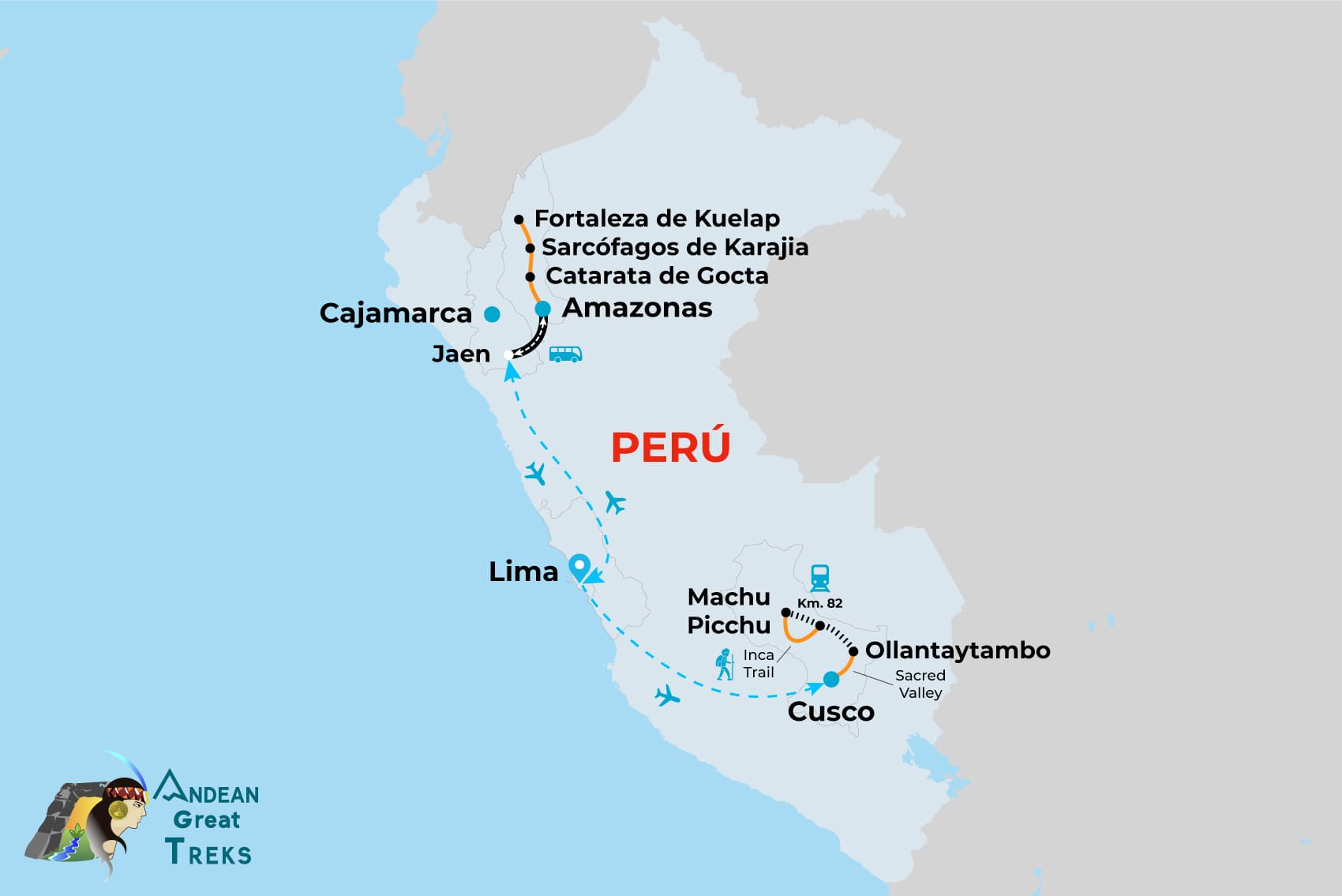 trip overview
included
Trip Highlights
activities
accommodations
itinerary
packing list
faq
essential trip information
best season to travel
price & availability
Reserve Online
trip overview
included
Trip Highlights
activities
accommodations
itinerary
packing list
faq
essential trip information
best season to travel
price & availability
Reserve Online
 CREATING AUTHENTIC TOURS IN PERU
CREATING AUTHENTIC TOURS IN PERU

Kuelap & Inca Trail to Machu Picchu are the best cultural attractions in Peru. They have an exquisite architectural design designed by the cultures of the Andes of Peru. These sanctuaries of the Andean civilization are located in the middle of the mountains and cloud forests, which offer incredible sunsets.
The north of Peru, still almost undiscovered by tourism, has a diverse cultural, historical and scenic offer, so that every traveler gets their money’s worth. Embark on an exciting journey to the unknown north of Peru and follow in the footsteps of the pre-Inca civilizations. In two weeks, you will get to know picturesque colonial cities, you will visit the ruins of Kuélap, an impressive fortress dating from the eleventh century -approximately- and is located at 3000 m s. n. An architectural jewel built by the Chachapoyas culture, it stands out for the perfection of its finishes, the monumental size of its buildings and how complex it was to access it, due to its walls up to 20 meters high. Hike to one of the highest waterfalls in the world. Let yourself be drawn into the spell of this exciting journey through the cultural past of northern Peru.
The follow days, you will immerse in depth the inca culture, visiting the ancient capital of South America, where the incas developed the most powerful empire and great Andean technologies. Explore Cusco together your expert local guide, who will bring you to the unique attractions. Don’t let pass the best of the sacred valley villages, and fantastic local traditions of the Quechuas.
Admire the most impressive masterwork the incas did. The classic inca trail to Machu Picchu, actually is well preserved and you can hike through this ancient inca trail, that on incas time was used just by the royal families of the King. Along their 45 km you will walk by fertile valleys, mountain forest, lush cloud forest, full of Andean birds, beautiful orchids. As well stunning inca constructions, many of then were used as religious shrines.
Came and explore the best of peruvian Andean Cultures.
Welcome to Peru! Your adventure begins in Lima. Peru’s colourful capital is equal parts cosmopolitan and chaotic. You will be collected from the airport and transferred to your hotel where you will meet your fellow travellers and local leader. Your adventure begins with a welcome meeting at 2 pm. Please look for a note in the hotel lobby or ask reception where it will take place. After the meeting, stroll the streets of downtown Lima and check out some of its main attractions on a leader-led walking tour. Enjoy free time before an optional group dinner this evening. The unofficial food capital of South America, there’s no better place to sample Peru’s national dish, ceviche, than at one of Lima’s excellent restaurants. As there’s little time spent in Lima, you may like to arrive a few days early to see the sights, including the chic suburb of Miraflores, Central Park, Lovers’ Park and the National Museum.
You will catch a flight from Lima to Jaen. At your arrival our staff of Andean Great Treks will pick up you, and transfer to your hotel, where we’ll stop for lunch before heading to Chachapoyas by private transport, which takes about four hours, during this beautiful journey we will descend into the Marañon River Valley (the Marañon is a major tributary of the Amazon River) before climbing upwards towards Chachapoyas through the stunning Utcubamba Canyon. About 20 km north of Chachapoyas, we’ll take a side road to the village of Cocachimba. This is where we’ll spend the night, at the wonderful Gocta Lodge. The lodge has amazing views of Gocta Waterfall, both from its 18 rooms and its outdoor swimming pool. Gocta Lodge is close to the start of the trail to Gocta Waterfall, our destination on Day 2.
Our trek to Gocta Waterfall begins right at our hotel door, which is a short walk from the trailhead. The trek passes along the sides of a beautiful cloud-forested valley, passing through the forest where animals, birds and butterflies are found in abundance. If you’re very lucky, you might even spot (or at least hear) a yellow-tailed woolly monkey, mountain sloth or magnificent cock-of-the-rock (the national bird of Peru).
The trail to Gocta is well maintained and very scenic. If you’re in good physical condition and enjoy walking and hiking, it’s a relatively easy trek. Some sections have steep inclines, however, and some visitors may struggle at times during the trek. One alternative to trekking is to hire a horse for part of the journey, or for the return leg if you´ve had enough walking.
You’ll have glimpses of Gocta Waterfall from various points of the trek, and you’ll hear it growing louder as you get nearer, but only after about two hours will you come face-to-face with this towering waterfall, which measures around 771 meters tall — one of the world’s tallest waterfalls. And although locals have known of Gocta for as long as they can remember, it was only in 2006 that its existence was announced to the wider world. It’s a magnificent sight up close, its raging waters tumbling down into a massive, churning pool below. If you’re feeling brave – and have a poncho or other waterproof jacket (or maybe just a bathing suit) – you can walk close to the plunge pool, where the feeling of tumbling water and rainbow-flecked spray is almost overwhelming.
After spending time at the falls, you can make your way back along the trail and return to the lodge, where you can have a well-deserved rest. The entire trek to Gocta and back normally takes about six hours. Make sure you bring good walking shoes.
After breakfast we’ll drive back down into the beautiful Utcubamba Canyon before crossing over into the neighboring province of Luya. From the village of Luya we will head to the village of Cruz Pata, where we begin our reasonably short and very scenic walk to Karajia (the walk normally takes about 45 minutes).
When we finally round a bend on the valley side, you’ll see the striking sarcophagi of Karajia standing on ledges on the cliff face above you. These human-shaped figures represent one form of burial used by the Chachapoya culture, which ruled this part of Peru from around 900 to 1470. The figures are unusually large, the seven main sarcophagi standing up to 2.5 meters tall and constructed of clay, sticks and grass. They stand looking out towards the rising sun. Their location on a largely inaccessible cliff has protected them from looters, something the ancient Chachapoya likely took into consideration when they put them there. Each sarcophagi contains a mummy, with various artifacts, some precious, accompanying them. They were likely elite members of the Chachapoya civilization.
Once we have marveled at these spectacular sarcophagi, we’ll head back along the trail to our transport.
In the morning we’ll drive to the village of Tingo where we’ll board the cable car for a fun ride across a canyon up to Kuelap Fortress. After a short walk, we’ll arrive at this hugely impressive archaeological site.
Kuelap was built by the Chachapoyas culture in the 6th century AD, some 500 years before Machu Picchu. It sits at 3,000 meters (9,900 feet) above sea level on a ridge overlooking the Utcubamba Valley, a commanding presence watching over the surrounding area. As you approach the fortress, you’ll undoubtedly be impressed by the towering outer walls, which reach 20 meters tall in places. The entire oval-shaped complex is about 584 meters long and 110 meters wide at its widest part. It is believed that it took about 40 million cubic feet of stone to build the gargantuan fortress, making it possibly the largest known ancient stone structure in South America, and three times larger than the Great Pyramid of Egypt.
As we walk around the near-impenetrable outer walls, we’ll eventually reach one of the three extremely narrow entrances into Kuelap. These provided excellent defense against potential invaders. As you walk up the narrow stairway, you can imagine how tough, and how brutal, it would have been for any attackers trying to force entry through these tight stone passages.
At the top of the entranceway, you’ll step up onto a tranquil plateau inside the fortress walls. As you do so, you’ll understand why the term “fortress” doesn’t quite do Kuelap justice. It was more like a walled city or citadel, capable of supporting thousands of people. Inside the fortress are the remnants of more than 400 circular dwellings, some of which have been restored to how archaeologists believe they would have looked hundreds of years ago. These dwellings are decorated with strange zigzag motifs and rhomboid friezes, the symbols possibly representative of the families who lived within. Passing through lightly wooded area inside the complex, where orchids grow and hummingbirds flitter about, we’ll explore the rest of the complex, including religious buildings, defensive towers and a strange construction that might have been used as a solar observatory.
There’s plenty to see at Kuelap, so we’ll make sure you have plenty of time to explore with your guide and then on your own. When you’re ready, we’ll return to our private transport and head back to Chachapoyas.
The day begins with a scenic two-and-a-half-hour drive through the hills to a small village called Yerbabuena. From here, we walk for two hours uphill to the enchanting site of Revash, a cliff-side funerary complex (alternatively, we can drive you a further 10 km to the village of San Bartolo, from where it’s an easier 30-minute walk to Revash).
Built by the Chachapoya culture around 1200 AD, Revash is different from other funerary sites in the region. Rather than sarcophagi or simple tombs, the mausoleums, or chullpas, at Revash were built to look like little houses, giving the impression of a tiny, colorful village built on the cliff.
The tombs are built of rock and adobe, and painted pink and cream. The sloping roves are purely symbolic and serve no real practical purpose (the cliffs above protect the chullpas from the rain). The walls of the little “houses,” meanwhile, are decorated with painted figures, including felines, South American camelids, people and geometrical designs.
Through analysis of the bones found at Revash, it appears that each tomb was not used for a single person. Instead, each tomb served as a collective funerary residence for members of a prestigious or powerful family.
After exploring Revash, we’ll continue on to Leymebamba (a 45-minute drive) where we’ll visit the modern and highly impressive Leymebamba Museum. The museum houses more than 2,500 artifacts from the Chachapoyas culture, and teaches you all about this fascinating civilization. And then there are the famous mummies, more than 200 of them! The museum was purpose built to house the mummies found at the Laguna de los Cóndores archaeological site. Seeing them lined up in their climate-controlled room is quite an experience. They are so well preserved that you can see them as individuals, frozen in time, with expressions all of their own.
The museum building was designed to reflect local architectural traditions, and the surrounding gardens are full of beautiful flowers and trees, including more than 100 native species or orchids. Inside the museum, all of the exhibits have detailed descriptions in several languages, making it very accessible to foreign visitors.
After visiting Leymebamba Museum, we’ll go to Chachapoyas.
Today we say goodbye to these wonderful lands, after breakfast you will be transferred to the Jaen airport. During the journey you will be able to enjoy the Utcubamba valley, and its mountains full of vegetation. At the Jaen airport, you will take the flight to Lima, where you can stroll in the afternoon in the Miraflores neighborhood, or if you want to have a fabulous dinner in the best restaurants in Peru.
Today you will say goodbye to the capital of Peru for a few days, since in the morning you will have to take a flight to Cusco, your local guide will meet you at the Cusco airport.
This city is at a very high altitude (3,400m), so you may want to take a little time to acclimatize, whether it’s to go out to see the city or relax with a bite of street food. After arriving at your hotel, in the afternoon you and your local guide can enjoy an orientation walk to see the colonial wonders and indigenous foundations of this fascinating city. It is the oldest inhabited city in South America, so there is so much to do and see. You’ll visit the facade of Qoricancha temple, the local San Pedro market, the main square, past the 12 Angled Stone, Regocijo Square and San Blas Square.
In the morning we gonna pick up you at 7:00 , from your hotel, then we will go by bus to the Sacred Valley of the Incas, where the Inca once built important cities such as Chinchero, Ollantaytambo, Maras, Urubamba. This spectacular cities amidst the breathtaking Andean landscape were designed in harmony with nature and are a dream for anyone who likes to visit archaeological sites and ruins. For the tour, we will use the tourist ticket “Boleto Turistico Parcial” . This lush valley was known as Wilcamayo to the Incas and has long been the main source of food for the high Andes. Maize crops can be seen surrounding the river and covering the terraces carved high into the valley walls. Our first place to visit is Chincheros where you can see the andean terraces, temples, also you can enjoy the typical market of Chincheros, then we will visist Moray, and Salineras at midday we go to Urubamba city where is the lunch stop, then we will go to the inca city of Ollantaytambo, where our tour guide will show you the most important places of this inca remain. The day will end at your hotel located in the Sacred Valley.
We will pick up you from your hotel in Sacred Valley at 5:00 am, then we go in private minivan to Km 82, Piscacucho, start of the classic Inca Trail to Machu Picchu, at the checkpoint you will meet your crew of local porters,cook. Before to start the inca trail to machu picchu we will weigh the equipments and control the passports and your tickets, for the classic Inca Trail to Machu Picchu, then we will start our trek at 9:00 am, along the Urubamba River.The first day includes uphill trekking to the campsite until we reach Llactapata an important archaeological site at 12:00 pm, where we will learn a bit about the history and culture of the Incas, then at 13:00 pm we will have lunch at the site of Tarayoc, then we continue 2 hours of walking to our first camp of Huayllabamba (3,100 meters) this site is the last town that we will see on the route, it is inhabited by farmers who still plant their plots of corn and potatoes. This day you can take advantage to charge your devices with electricity. In the afternoon it will be our presentation with our porters, and a very nutritious dinner to rest.
This is the most challenging day of the trek, as we ascend a long steep path (approximately five hours) to reach the highest point of the trail. Colloquially known as ‘Dead Woman’s Pass’, Warmiwañusca sits at a height of 4,200 meters above sea level, providing amazing views of the valley below. Your porters will wake up you, at 5:00 am with a hot cup of coca tea to get you ready for the day. Today we will start at 6:30 am. We’ll hike for roughly 5 hours to the highest pass of the classic inca trail to machu picchu, Dead Woman’s Pass (4200 meters/13,829 feet). The first 2 hours , you will walk into highland forest, the way is steps and uphill. Then you will get the place of Llullucha, where we will stop a long time, from this point until the dead woman pass is one hour and a half , the landscape gonna change , is a new microclimate, because the altitude it gonna be very hard, but not impossible to reach the pass at 12:00 pm, we’ll stop a short break to enjoy the views before setting off again to descend to the next valley (Pacaymayo Valley ). It’s another hour and a half down the side of the valley to our lunch spot, we will end the hike at 2:00 pm . In the afternoon is a free time, to relaxing , in case you like a cold shower there is , if not just enjoy the beauty of the landscape, this day we have also tea time and the dinner.
We begin early again, wake up at 5:30am to begin what is commonly felt to be the most beautiful day of the whole classic Inca Trail. We begin ascending again to the second pass of the trek. It’s 2 hours to the pass and along the way we’ll stop at a small Inca site (Runcu Raccay) and see two huge waterfalls cascading down the opposite side of the valley. After the second pass, it’s another hour downhill hike to reach the magnificent Inca site, Sayacmarca (an otherwise inaccessible village). We’ll stop here for a rest and have a quick tour of the site and then watch the Vilcabamba mountain range. It’s then just another 20 minutes until we stop for the lunch place, in Chaquicocha at 11:00 am (Dry Lake, 3600 meters). After lunch, we hike for 2 hours along what we like to call “Inca flat” (gradual inclines) and begin to enter the jungle, known as the Cloud Forest. As we walk we will have the opportunity to see the majesty of Salkantay, the second highest snow-capped mountain in Cusco. Towards the end of the Inca flats we begin to make our way up to the last peak at Phuyupatamarca (3600 meters) from where we’ll have great views overlooking the Urubamba River. Down the valley we get our first views of Machu Picchu Mountain but the site itself is still hidden from view. From Phuyupatamarca it’s a 3 hour walk down a flight of steps, to our last campsite, arrival time is at 16:00 pm. Wiñay Wayna is the most spectacular Inca site on the trail after Machu Picchu and the most popular campsite because of its proximity to Machu Picchu.
Wake up time is at 4:00 AM. Then we will do a line in order to wait at the checkpoint to be opened. At 5:30 am once the park rangers do the last checking we start the walk to the Sun Gate, along the way we have spectacular views of the mountains and Urubamba river. We will reach the Sun Gate at 6:30 am, over there you can take the first picture of Machu Picchu with amazing views, after to enjoy the sunrise, we will go down to the sacred citadel. At 8:00 am we will arrive to the gate of Machu Picchu , overe there we have to leave all our backpacks, because into the archeological site is not possible to do with rucksacks. As well you can use the toilets and buy some coffes or sodas. At 9:00 am we start the tour guiding into the complex with your tour guide for 2 hours. At midday you have to go down to Aguas Calientes town, and look a restaurant for your lunch. So the return to Ollantaytambo by train is at 14:55 pm. After 1h 45m the train arrives to Ollantaytambo train station where gonna pick up you our staff, after to have amazing days you will arrive to your hotel in Cusco at 18:30 pm.
Visiting Machu Picchu:
According to Machu Picchu visiting regulations, all visitors must follow a pre-determined route within the site. This route must be followed in one direction only and once the guided visit commences exiting and re-entering the site is not permitted. Once the guided visit concludes, visitors must exit the site and personal exploration of Machu Picchu is not permitted.
After breakfast enjoy your last day at leisure before transferring to the Cusco airport for your flight at home.
 warm jackets
warm jackets
 Hydration bladder
Hydration bladder
 wool socks
wool socks
 camera
camera
 scarf
scarf
 first aid kit
first aid kit
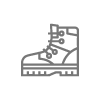 hiking shoes
hiking shoes
 Dry bags
Dry bags
 Trekking Poles
Trekking Poles
 sun cream
sun cream
 Snack
Snack
 sun hat
sun hat
 bathing suite
bathing suite
 rain coat
rain coat
 Sandals
Sandals
 insect repellent
insect repellent
 Passport
Passport
 Down Jackets
Down Jackets
 toilet paper
toilet paper
 daypack
daypack
 Wool cap
Wool cap
 head lamp
head lamp
 gloves
gloves
 sun glasses
sun glasses
 cap
cap
 extra cash
extra cash
 Trekking pants
Trekking pants
The starting point of the Inca Trail hike of 4 days and 3 nights Network is located in the Piscacucho km 82 community, in the district of Ollantaytambo, province of Urubamba.
Most people will get to Cusco by air. Please remember that the Cusco airport is for domestic travel only. If you come directly from overseas through Lima, you must get your bags in Lima and re-check them for your flight to Cusco. Four airline carriers fly roundtrip between Lima and Cusco. That includes LATAM Airlines, AVIANCA Airlines, Star Peru, and Peruvian Airlines. They all offer similar schedules and in-flight service, but we usually recommend either LATAM airlines or AVIANCA. They tend to be the most helpful when unexpected flight cancellations or delays occur
The Inca Trail has an extraordinary history. The Inca Empire extended into parts of what is now Colombia, Ecuador, Peru, Chile, Argentina, Brazil, and Bolivia, and the original Trail stretched approximately 25,000 miles throughout these areas. During the 15th and 16th centuries, the Trail was used as a key trade route as well as for transportation. However, parts of it were also used for ceremonial purposes and as a pilgrimage route.
Therefore, there are many fascinating theories about the purpose of the connection of the Inca Trail to Machu Picchu, which was built at the height of the Inca Empire. Some researchers believe it served as an annual pilgrimage route to honor Inti, the Incan God of the Sun, who was thought to have been born on the Island of the Sun at Lake Titicaca. It is said that the Trail follows the path of the Sun’s rays during certain times of the year, from Lake Titicaca to Machu Picchu.
The construction of the city of Machu Picchu spanned the reigns of two Inca rulers: Pachacutec Inca Yupanqui (1438–71) and Tupac Inca Yupanqui (1472–93). However, a little over a hundred years later, the city lay mysteriously uninhabited. Historians have disputed the reasons for this, with some arguing that invaders killed the city’s population during the Spanish Conquest, and others arguing that the city’s population succumbed to a smallpox epidemic, years before the Spanish arrived.
During and after the Spanish Conquest, the Inca Trail and Machu Picchu became targets for plundering and theft. It has been reported that Germans Augusto Berns and J.M. von Hassel initially found Machu Picchu during the 1800s and early 1900s, respectively. However, due to the dense forestation that had started to amass around the abandoned city, Machu Picchu became far less targeted by looters than other easier-to-access sites along the Inca Trail in Peru and in the surrounding areas. The locals may also have kept quiet to save their secret city from the aggressive looting campaigns, so by the 19th century only a few locals and academics were even aware of Machu Picchu’s existence.
In 1911, the American academic and explorer Hiram Bingham re-discovered Machu Picchu along the Inca Trail in Peru and conducted the first official archeological research there. As a seasoned adventurer (due to childhood expeditions with his father) and a keen Latin American history scholar, Bingham spent time traveling the Spanish trade routes throughout South America. As a Yale University history professor, he organized a group of scholars to set out and find the ‘lost city.’
Then, on July 24, 1911, a local guide directed Bingham to the ruins of Machu Picchu. Once there, he and his team started to explore and excavate the area, with return trips in 1912, 1914, and 1915 to continue their work. Through the Yale Archeological Society, the area of Machu Picchu and several surrounding sites were excavated and further academic research was conducted. To this day, the area is still a historical treasure trove, adding much to the Inca Trail experience.
The Inca trail hike is famous because it provides hikers the only way to arrive in Machu Picchu by means of hiking. Upon the re-discovery of Machu Picchu by the American scholar Hiram Bingham, the Inca trail to machu picchu was also brought back to life.
Teams of archaeologists and local peasants explored what remained of this ancient inca trail, finding many Incan complexes and temples along the way that became some of their most beautiful attractions. Machu Picchu was named a UNESCO world heritage site in 1983, and one of the seven new wonders of the world in 2003, which made it a famous must-see travel destination.
The Inca Trail hike to Machu Picchu began receiving more tourists when Peru entered into a phase of pacification in coming out of a kind of civil war that bled the country from the early ’80s up until the mid-’90s. By the end of the last century, thousands of people flocked to this beautiful destination to arrive in the Sungate of Machu Picchu at sunrise. Only the people who hike the trail to machu piccu can experience such an event.
Just like every other outdoor activity, hiking involves a dose of risk-taking. However, the Machu Picchu hike is not dangerous at all.
There are no places where one’s safety might be compromised. In any case, the best way to minimize any danger level is by acting proactively and taking the necessary measures to prevent any such situations. For instance, proper acclimatization will prevent you from getting altitude sickness, which is the number one reason why people fall ill.
Taking a trip to any historical landmark in the world of the caliber of Machu Picchu demands preparation about the background of such attractions. Here is a list of a few books and videos that you should consider reading before your Machu Picchu trip:
A few videos you can watch:
The best way to ensure that one will hike the Inca trail successfully is by arriving in Cusco at least three days ahead of your departure time. These three days will give you the necessary time to acclimatize while you get to visit some of the beautiful attractions that you can visit in Cusco.
Arriving in Cusco by plane. Most people fly into Cusco, coming directly from Lima after their international flights. Lima holds the most important international airport in Peru, and almost all international flights must land there before people connect to their final domestic destinations. Cusco’s airport is the second busiest airport in Peru; most flights arrive from Lima while some others do it from cities like Arequipa, Juliaca, Iquitos, Puerto Maldonado, and Trujillo. As far as international flights, Cusco’s airport receives flights coming from Bogota, Colombia, Santiago de Chile, and La Paz, Bolivia. The most important and safest Peruvian airlines are Lan Peru and Avianca. Other budget airlines are SkyPeru, Peruvian Airlines, and Gol Peru.
Arriving in Cusco by bus and train (overland). There are plenty of comfortable bus companies servicing Lima and Cusco on a daily basis. The bus ride usually takes up to twenty hours of driving. Traveling to Cusco from Lima by bus is not advisable. Most people who do arrive in Cusco by means of bus do it after following an itinerary that allows them to visit a few other interesting tourist attractions along the way. Places like Paracas Marine National Reserve or Poor Man’s Galapagos, the Huacachina Oasis in Ica, and the Nazca Lines are some of the must-see attractions one can visit on the way to Cusco. There are a few hop-on/ hop-off tour operators that allow you to visit those places by purchasing one full ticket between Lima and Cusco. Also, plenty of night buses run from Arequipa (the second-largest city in Peru) to Cusco. Arequipa is a beautiful colonial city where one can visit the Colca Canyon and see the flight of the condors. Also, many people choose to climb the Misti and Chachani volcanoes in this area.
As far as trains, Cusco connects with Puno, from where Peru rail runs a few different tourist trains.
THINGS TO DO IN CUSCO BEFORE THE INCA TRAIL HIKE
Cusco is the most beautiful city in Peru and one of the most beautiful cities in South America. It is a place that deserves time in its own right to be explored and enjoyed. As I mentioned above, one of the most important reasons to arrive in Cusco a few days ahead of your Inca trail tour is to accelerate the process of acclimatization to the altitude. To do this smoothly and perfectly, then we recommend the following things to do:
Day One. Go for a walk of your own or take a walking city tour of Cusco. This is a great way to experience Cusco upon arriving. In these tours, you will see some of Cusco’s most impressive attractions, such as the Main Square or Plaza de Armas, the San Blas neighborhood, and the San Pedro central market. These walking city tours usually take up to 3 hours. Make sure you book for an afternoon city tour to give your body some time to first adapt to the altitude.
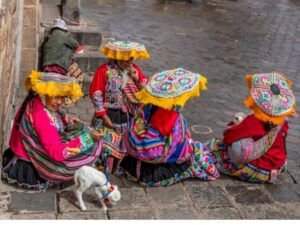
Day Two. Take the Rainbow Mountain tour or the Humantay Lake tour. Climb high, sleep low is one of the best practices that hikers perform when hiking at high altitudes. One of the ways people can quickly adapt to the altitude is by climbing either the Humantay Lake or the Rainbow Mountains. By doing so, one actually gets to do what is mentioned above as people will climb to altitudes above 13,000 ft and return to Cusco’s altitude of 10,500ft in the afternoons.
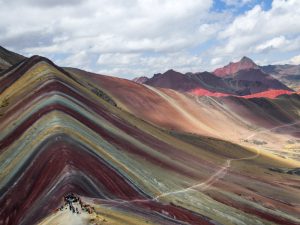
Day Three. Take it easy, or take the magnificent Sacred Valley tour. We recommend that you make your hotel reservations for this night in places like Urubamba or Ollantaytambo. You can check with your inca trail tour operator and ask them to pick you from either of these locations the following day. If you stay at either of these locations, you will save yourself the two-hour drive back to Cusco from Ollantaytambo after completing the Sacred Valley tour and the two hours from Cusco to Ollantaytambo on the day of the tour. Additionally, this decision will give you two more hours of sleep on the day of the hike as you won’t have to get up at four in the morning to be transported to the start of the Inca trail hike to Machu Picchu.

After you have experienced some of what Cusco offers, it’s time to turn our attention to the Classic Inca Trail tour. To hike this route to Machu Picchu, you are required by the government of Peru to hire a licensed guide service or tour company with the required permits to take trekkers on the journey.
The company you choose will often arrange road transportation from Cusco to the start of the inca trail trek, with pickups that generally occur early in the day (around 4:00 AM local time). The most popular place to start the hike is known as Kilometer 82, which is the start of the Classic Inca Trail route. Once you reach this location, you will generally conduct a gear check, fill up your water containers, and make sure everyone is fully prepared to start the journey.
The network of Inca trails, known in the Quechua language as ‘qhapac’ (main road or path of the powerful), is an immense connection of Inca trails built for the most part by Emperor Pachacutec in the 15th century.
These roads linked the main cities of the empire with Cusco, the capital of the empire. The Inca himself was led from the ‘sacred city’ to the various points of the empire through the qhapac ñan.
The network of Inca roads covered part of the territories of the current countries of Peru, Bolivia, Ecuador, Colombia, Chile and Argentina. Due to their historical importance, they are currently considered ‘Cultural Heritage of Humanity’ by Unesco. Because of this they are protected and preserved for the future.
What was the importance of the Inca Trails?
The Qhapaq ñan is the word that defines the road system of the Inca civilization. It is the best proof of the development reached by the Incas in civil engineering. It is worth mentioning that this network of roads was built on one of the most rugged territories in the world. He managed to cross the rugged Andes Mountains and the arid deserts of the South American coast.
This network of Inca roads crossed the empire of the Incas by routes drawn from north to south (from end to end) along the coast and through the Andes Mountains. There were small sections for the common population. There were also wide sections dedicated to Inca royalty. The Inca roads of the sierra had sections completely paved while those of the coast were built simply of earth.
The world famous Inca Trail to Machu Picchu is just one part of this complex network of roads. Go up the Urubamba river basin to the Inca city, after winding difficult mountains. At present it is considered the best hiking route in Peru. You can visit it in four days through a perfectly planned tour.
The roads of the Incas were built with the main purpose of keeping a huge territory communicated. This made it possible to mobilize armies very quickly. It also served as a trade route in a civilization prone to redistribution and exchange. Another extremely important purpose was the culturalization of the newly conquered peoples. It should be noted that these roads were built in the expansionist time of the Incas.
What is the length of the Inca trails?
At present, more than 60 thousand kilometers of roads that formed this enormous network have been identified. But studies carried out reveal that the Qhapaq ñan would be made up of more than double that identified throughout the South American territory.
What was its function?
The route of the Inca roads, in addition to connecting one town with another, served to connect the culture of the peoples of the time. Likewise, its function was that of a trade route and strategic routes of cultural connection between the different towns of the immense Inca empire. This is how Inca cities were integrated such as: Vilcashuaman, Pumpu, Hatun Xauxa, Huánuco Pampa, Cajamarca, Quito, etc.
The Qhapaq ñan shows many sections in which there are two parallel roads in a trunk route. It is known that the Inca, his court and his armies would go through one of them, while the other was destined for the people.
Likewise, this road network had a commercial function as it supplied different cities with products that were harvested at different altitudes. For example, the city of Cusco was able to supply itself with: chili, cotton, coca, corn, fish, mullu and even the famous spondylus shell.
How is it designed?
The Inca trails are designed in response to the coastal and mountain geography. There are stretches in immense arid plains up to the most rugged mountains of the Andes mountain range. There are also countless slopes, cliffs, mountains, pampas, swamps, gorges, and canyons. In many cases, the most difficult sections were solved with bridges and uneven roads.
Main Inca trails
The Inca roads were made up of several longitudinal and transversal sections. However, the longest and most important sections were two: the longitudinal route that crossed the Andes Mountains and the longitudinal route that crossed the desert coast:
The coastal roads: As its name indicates, this longitudinal route ran along the coastline of the empire, from the south of Ecuador to the north of Chile. The roads reached 3,943 kilometers. It is calculated that the minimum width measured 3.5 meters while the maximum width reached 20 meters. It crossed up to 52 Cusco valleys including important religious centers such as Tambo Inga, Armatambo and Pachacamac. The Inca Huayna Cápac had these roads built after conquering Quito (Ecuador) in the 15th century.
The roads of the mountains: This road was initially built by Emperor Pachacutec and finished by his successors Túpac Inca Yupanqui and Huayna Cápac. This route connects the current cities of Quito (Ecuador) with Santiago (Chile), crossing the difficult geography of the Andes Mountains. In total it has an area of 5,658 kilometers. Due to the mountainous slopes, this road was built with stone pavers, bridges, as well as administrative centers, tambos (rest centers for walkers) and colcas (food centers for walkers). The narrowest sections were 3 meters wide. The widest sections, eighteen meters.
Constructions along the roads
The difficult South American geography and the immense distances that the Inca roads traveled forced the Incas to build certain structures necessary for the proper functioning of the roads.
The bridges: There were several bridges that allowed crossing rivers or spaces with abysses. These bridges could be woven of straw (the icchu or wild straw of the Andes) and were characterized by being hanging. And there were other bridges that were built of tree trunks, supported by abutments of huge stone blocks. Also noteworthy are the ‘oroyas’, wooden rafts that were used to flow through the lakes. Currently the Queswachaka bridge in Cusco is an example of the tradition of the Andean peoples in the construction and maintenance of Inca bridges.
The tambos: These constructions had the function of shelters and deposits of food, wool, firewood, clothes. These products were stored both for people who traveled and for emergencies. It is estimated that on the main roads there were dairy farms every 20 or 30 kilometers. These housed the “chasquis” or emissaries who were young runners who went from tambo to tambo carrying the Inca’s messages through a relay system. Through this system it is said that a message could reach from Cusco to Ecuador in 10 days (approximately 2,000 kilometers).
The Inca Trails to Machu Picchu
The Inca Trail to Machu Picchu is the small network of roads that connects the towns of Cusco with the Inca city of Machu Picchu. With the discovery of this archaeological site in 1911, part of this section of the Qhapac ñan was unearthed. Since then these trails have been valued.
Due to its location on the slopes of mountain ranges, this section of the Inca Trail was built following the characteristics of the mountain roads. The Incas first made the layout of the road, then the foundation of the soil with several layers of stone and earth. Next the paving and the drainage system were made. Due to their complex construction, these trails are kept in good condition.
This section of the Inca Trail was not discovered by the Spanish. It is also believed that they did not give it the necessary importance. In any case, the Spanish did not reach Machu Picchu, which, after being abandoned, was hidden in the thick vegetation over the years. The section from qhapac ñan to the Inca city also suffered the same fate.
The Inca Trail today
Currently, the section of qhapac ñan that connects Cusco with Machu Picchu was valued and adapted to be traveled by tourists. It is a route of almost 40 kilometers that is crossed in 3 days and 3 nights. The fourth day is dedicated to visiting Machu Picchu.
Unlike other hiking trails in Cusco, the Inca Trail to Machu Picchu is protected by the Peruvian State. This is due to the historical value of the sections of qhapac ñan that it runs through. Therefore, no unauthorized person can walk its ways.
The only way to get this authorization and travel the Inca Trail is to hire a tour through an authorized tourism agency. Tourism agencies manage permits with the Ministry of Culture of Peru and add a tour guide service, camping equipment, food, tickets to Machu Picchu and more services for the visitor.
Currently there are many tourists who want to make the Inca Trail to Machu Picchu. Due to the high demand of visitors, tours must be purchased online 6 or 7 months in advance. It is the best hiking trail in Peru.
Along the trek, you will walk through different terrains, and experience diverse microclimates and altitudes. All of these factors contribute to the great biodiversity that is unique to this area.
For the inca trail hike more than any of the treks, we recommend the use of Trekking poles, especially for those passengers with knee problems. There are multiple times during the inca trail hike that a Trekking poles is handy, be it ascending a mountain or walking down immense sets of Inca stairs. It will help with your balance and reduce the impact on your knees.
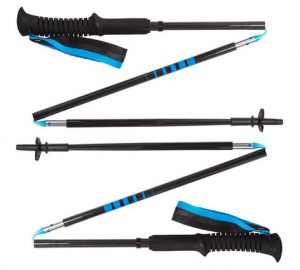
Hiking the Inca Trail is moderately difficult, and it is important that hikers take adequate physical preparation. Some sections of the trek are more difficult than others, and involve steep ascents, high altitude, and long days on the trail. Though some may find the distance covered on the trek each day to be challenging, proper physical preparation will allow travelers to enjoy the trek to the fullest.
When trekking along the Classic Inca Trail Hike, elevation is something to keep in mind. It is important to note that this hike is not easy, and certainly not a trek you can take on without adequate physical preparation. You will be hiking up to 14,000 feet in elevation, and on one of the hiking days you could be on the trail for up to 12 hours.
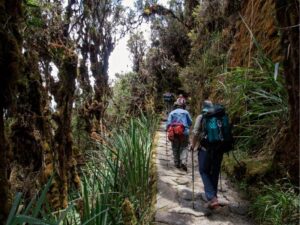
Cusco has two distinct seasons: dry and rainy. However, in these two seasons, you can experience the different microclimates of each town. The microclimate varies according to the altitude you are at. Having that said, you will notice that the climate in Machu Picchu and along the way varies. You will hike from an altitude of 2050 m.a.s.l. to 4200 m.a.s.l.
Rainy season: From November to April. During this time Cusco receives a greater amount of rainfall. Average daytime temperatures are higher than the dry season at 23 °C while night temperatures can be as cold as 6 °C. Likewise, Annual rainfall is 160 mm. During these months, it is cloudy and humidity can reach 91%.
Dry season: From May to October. Days are bright and sunny with a temperature of 22 °C (61 °F) while nights are much colder sometimes with a low temperature of 0 °C. Likewise, Annual rainfall is 60 mm. It is sunny with a clear sky and 70% of humidity.
Because of high altitude temperatures can change quickly and radical. It can get pretty cold during the nights. In winter (May-September) temperature may drop below 0°C/32°F. So be prepared for cold too, its highly advisable get locally made gloves and a hat for the cold nights.
The best season to do the Inca Trail hike is during the dry season. However, you should know that whether you come in the dry or rainy season, it will have advantages and disadvantages.
We covered the process of obtaining your permit, but it may also be helpful to understand the best times of each year to hike. The most popular time to hike the Inca Trail is between April and September. With the rainy season in Peru over, most tourists and travelers will have planned to take their trip during these months. The trail itself is open for 11 months of the year, but all tours are closed in February for environmental and archeological maintenance. The mountains Huayna Picchu and Cerro Machu Picchu, which are both part of the Machu Picchu sanctuary, are temporarily closed each year for maintenance (in recent years, they have been closed at different times in April, though this may not always be the case and the timing of closures can be variable going forward.
January and March
During these months Inca Trail tours are relatively uncrowded, wet, and certainly fun if you enjoy a bit of a challenge. Fewer tourists and fewer queues when you arrive in the city can mean that traveling to and around Machu Picchu in the winter season has its advantages. Because Machu Picchu is considered to be a shrine to the Inca Emperor Pachacuti (1438–1472), hiking at this time of year can highlight the quiet beauty that this site was created to be appreciated in.
April
Lovely and temperate, April is an excellent time for an Inca Trail hike to Machu Picchu tour due to the firmer ground and clearer weather. Photography can also be quite fortuitous in April if you want to capture some high-quality pictures of Machu Picchu and the surrounding forests.
May
Gorgeous weather for hiking the Inca Trail hike and reasonably dry, May is a great time to visit Machu Picchu as well. Be aware of booking and travel costs, though, as May is the start of peak traveling season for university/college students. Flights and accommodations can get somewhat expensive if you don’t plan well.
June, July, August, and September
These are the most popular months to go hiking on the Inca Trail hike and/or to visit Machu Picchu. With dry weather, very little rain, and cooler nights, hiking during these months is generally more comfortable than at other times of the year. The downsides can include the challenge of securing accommodations and trail permit reservations, as they will be scarce.
October
With fresher, cool temperatures, this is great weather to hike the Inca Trail. Although it is colder than many of the other months, October is reasonably dry and falls outside of holiday periods, making it a great time to go hiking in Peru in general. The off-peak season provides choice hotels and quieter experiences when traveling and dining, as well.
November and December
November and December feature surprisingly good weather for hiking the Inca Trail, with minimal rain. Just before the winter break, the queues and attractions in Machu Picchu and surrounding areas are busy but not overcrowded. Also, the hotels near Machu Picchu and transport are still reasonably quiet.
Conclusion
There you have it, an introduction to the need-to-know essentials for hiking the Inca Trail and visiting Machu Picchu! We hope this guide has given you an informative and helpful idea of what to expect as you plan your one-of-a-kind adventure to Peru. If you have any additional questions on hiking to or visiting the iconic Machu Picchu citadel, please do not hesitate to contact us.
Tips: It is important to pack light and consider the climate of the time of the year you are coming to do the inca trail 4 days. If it is during the rainy season, you need to buy a rain poncho and bring a raincoat. Wear always sunscreen no matter the time of the year.
The Classic 4 day/ 3 night Inca Trail hike includes beautiful places. Among the tourist attractions, we can name archaeological remains and natural areas that are found on the route.
Piskacucho 2720m / 8923ft:
The Piscacucho community or better known 82 kilometer, is located next to the rail to Aguas Calientes. Here is where the famous 4 day/3 night Inca Trail to Machu Picchu starts.

Llactapata 2850 m / 9350 ft:
The name of the Archeological Center of Llactapata comes from two Quechua words: Llaqta = Town, Pata = Elevated place. It is an Incan town located at the confluence of the rivers Cusichaca and Urubamba. Llactapata consists of constructions with different well defined sectors such as: Enclosures, terraces, plazas, staircases, channels, etc. This archeological site shouldn’t be confused with the one that has the same name and that you can visit on the Salkantay trek, which was a ceremonial center.

Wayllabamba (1st campsite) 3000m / 9842ft:
Wayllabamba comes from Quechua words and means ‘grassy plain’. It is here where you will camp on the first day hiking the inca trail trek. There is a village nearby where travelers can mingle with local villagers. You can see a few dispersed houses, terraces and an old aqueduct and channels that trace back to the Inca period. This small village is located at the confluence of the river Cusichaca and Llullucha stream (or Hatun Wayruro).

Ayapata 3300 m / 10829 ft:
This place shows a flat area which serves as a resting place. From this point, you can appreciate the impressive Andean Mountains and the beginning of the micro climates and ecosystem.
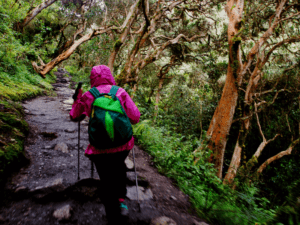
Llulluchapampa 3800 m / 12460 ft:
This point is a clear proof of the steep climb ahead. The reason for the name is thanks to the Llullucha stream that flows along the Inca Trail hike. Along the way, you will observe the great variety of the flora and fauna, and the charm birds chirping. Llulluchapampa is the last place where you can buy supplies for the rest of the Inca Trail hike.

1st Warmiwañusca Pass 4200 m / 13779 ft:
This is the first mountain pass that tourists walk through on the Inca Trail hike to Machu Picchu and it is the highest point along the hike. Its name comes from two Quechua words that means “Dead Woman”. It is a high Andean zone from which you can observe a magnificent and diverse landscape. Although the climb to the steep summit requires a great effort, it is worth it for the incredible view and feeling of achievement of the high altitude.

Pacaymayu (2nd campsite) 3580 m / 11700 ft:
It is here where you camp on the second day. Getting to this campsite is a great achievement because of the strenuous up and down mountains you will hike through. You can appreciate a more diverse ecosystem here since it is the beginning of the jungle side with more vegetation and wildlife.
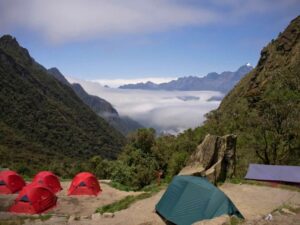
Runkuracay 3680 m / 12073 ft:
It is an Incan archeological site. Its name comes from Quechua words that means “Abandoned or collapsed house”. The Archeological Site of Runkuracay is located in the mountain with the same name. This archeological site consists of semicircular construction, with a main square and other facilities that surround the construct such as niches, recesses, and trapezoidal doors.
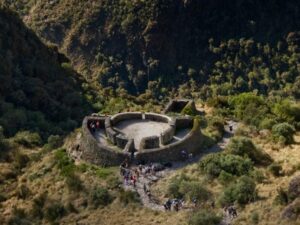
2nd Runkuracay Pass 4000 m / 13779 ft:
It is at a very short distance of the archeological center. This is the second Mountain pass that you will walk through. Although the climb to this point is not very steep, the high altitude is. From this point, you can observe the Sayacmarka viewpoint, Archeological site of Runkuracay and Cochapata lagoon.

Sayacmarka 3650 m / 12000 ft:
This archeological site is considered an Incan fortress and the name comes from Quechua words that means “Inaccessible town” due to its location. Its stone architecture is magnificent and is seen in all the area. You can find the temple of the Sun, food storage rooms, and a residential area. There is a complex ingenious irrigation system.
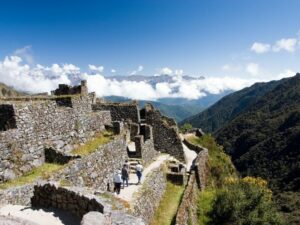
Chaquicocha 3600 m / 11800 ft:
Here you can find the Chaquicocha lagoon which means “Dry Lagoon” and it is here where you can rest. From this point, you can observe the change in the ecosystem that is the beginning of the tropical forest. Near the area, you can find an Incan tunnel that takes you to the other side to continue with the hike.
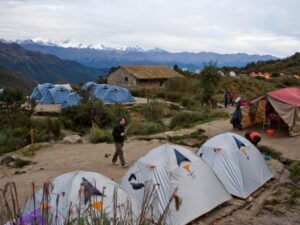
3rd Phuyutupamarca Pass 3680 m / 12073 ft:
Third and last Mountain pass that you will hike through in the Inca Trail hike . The Archeological Site of Phuyupatamarca is located here. Phuyupatamarca comes from the Quechua words and means “The City Above the Clouds”. This is because it is surrounded by clouds. It has a great amount of enclosures and a sophisticated retaining wall structure since it is located on the steepest side of the mountain.

Intipata 2800 m / 9270 ft:
This archeological site is a set of Inca platforms and enclosures that keeps harmony with the surrounding. The terraces of considerable size allow the development of large-scale agriculture and were built to prevent erosion of the Mountain.

Wiñay Huayna (3rd campsite) 2680 m / 8792 ft:
A magnificent archeological site that is on the mountain slope. Its name comes from Quechua words that means “Forever Young”. You can notice that this site was a small town for its constructions. There is a main yard surrounded by terraces that were used for agricultural purposes and also as retaining walls. This is just a magic and historical place.
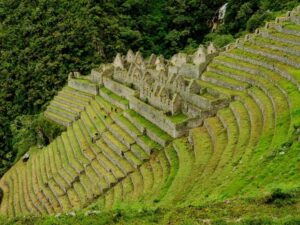
Inti Punku 2730 m / 8956 ft:
Site used as the entrance door to Machu Picchu citadel during the Inca time. Its name comes from the Quechua words and means “Sun gate”. It consists of enclosures with windows and a main door. From this point, you can have the first and amazing view of Veronica snow capped mountain and Machu Picchu citadel.
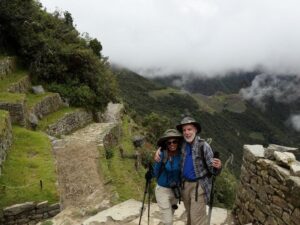
Machu Picchu elevation 2400 m / 7873 ft:
The name of the impressive Machu Picchu Inca citadel comes from the Quechua words and means “Old Mountain” and it is the last destination of most hikes. It surprises the visitor with the greatness of its architecture and engineering. The architecture of its buildings is unique. You can observe: the religious enclosures, enclosures for the Inca and the urban area. The other area is for the agriculture in which you can notice the terraces on the slopes of the mountain that also work as retaining walls. There is an irrigation system with aqueducts in the whole citadel.

Aguas Calientes 2050 m / 6561 ft:
Town located at the Urubamba riverside. It is the main access to Machu Picchu travel. Here you can the railway and the hot springs of Aguas Calientes. There is also a craft market. The weather is warm and humid since it is located in the Eyebrow of the Jungle.
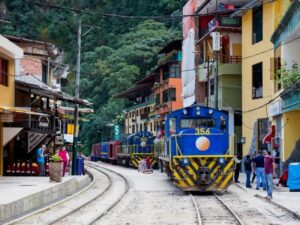
There are four different routes and itineraries covering the network of roads within the National Sanctuary of Machu Picchu. Below are the itineraries for every one of them.
1.- The Six-Day Salkantay Trek + Classic Inca Trail Hike
Details.
Difficulty level: Hard
Distance covered: 27.5 miles / 44.25Km
The combination of the Salkantay Trek and the classic Inca trail hike is the longest and toughest route of all the routes. It is a hike recommended for experienced hikers only, and it requires proper acclimatization to climb the impressive Inka Chiriaska pass. The trail starts at Soraypampa, which is the starting point of the classic Salkantay trek. Unlike this other route, the Salkantay trek combination does not head toward Santa Teresa; instead, it climbs to the much higher and more difficult to ascend Incachiriasca pass (16,000 ft / 5,000 meters). From this location, it continues to the archeological site of Inkarakay, where it enters the classic Inca Trail hike and the National Sanctuary of Machu Picchu.
Itinerary.
Day One
Difficulty level: Moderate.
Distance covered: 3 miles / 4.98Km
Highest Point: 15,630ft / 4,764m (At Pampa Japonesa)
Lowest Point: 12,839ft / 3,913m (At Soraypampa)
Elevation gain: 2791ft / 851m
Starting time: 4:30 A.M. from Cusco. The starting point for the six-day Salkantay trek plus classic Inca trail hike is Soraypampa. From there, the road goes on a steep and steady climbing toward Pampa Japonesa. The path is difficult due to the intense climbing and the high altitude.
Day Two
Difficulty level: Difficult
Distance covered: 8.53 miles / 13.7Km
Highest Point: 16,125ft / 4,916m
Lowest Point: 15,630ft / 4,764m (At Pampa Japonesa)
Elevation gain: 495ft / 150m
Starting time: 7:30 A.M. The first part of the road is a 1.5-hour steep and difficult climb toward the Inkachiriaska Pass. From this location, the path is a long, steady downhill hike to the campsite at Pampacahuana.
Day Three
Difficulty level: Difficult
Distance covered: 6.06 miles / 9.76Km
Highest Point: 12,368ft / 3,770m (At Llulluchapampa)
Lowest Point: 9,653ft / 2,942m (At Huayllabamba)
Elevation gain: 2,717ft / 828m
Starting time: 6:30am
Visited archeological sites: Paucarcancha & Huayllabamba.
Day Four
Difficulty level: Difficult
Distance covered: 6.01 Miles / 9.8Km
Highest Point: 13,800ft / 4,201m
Lowest Point: 11,797ft / 3,595m (Pacaymayu Alto)
Elevation gain: 1,432ft / 437m
Starting time: 6:30 A.M. The first part of the road is a 1.5-hour steady climb towards the Dead Woman’s Pass. Then, a 1.5-hour downhill toward Pacaymayu, followed by a 1.5-hour climb to the Runkurakay pass and a 1.5-hour walk downhill toward the lunch place at Chaquicocha, followed by a 2-hour gradual uphill walk toward the campsite at Phuyupatamarca.
Visited archeological sites: Runkurakay, Sayaqmarka, Qonchamarka
Day Five
Difficulty level: Moderate
Distance covered: 6.31 Miles / 10.15Km
Highest Point: 11,991ft / 3,654m (Phuyupatamarka)
Lowest Point: 7,987ft / 2,434m (Machu Picchu)
Elevation Loss: 4,004ft / 1,220m
Starting time: 6:30 A.M. The first part of the trail is a 3.5-hour steady walk downhill towards the lunch place at Winaywayna. Then, a 1.5-hour walk on ‘flat’ terrain toward Intipunku, followed by a 45-minute walk downhill toward Machu Picchu.
Visited archeological sites: Phuyupatamarka Torreon, Phuyupatamarka, Intipata, Winaywayna, Intipunku, Machu Picchu
Day Six
Difficulty level: Easy
Distance covered: 2 Miles / 3.2Km
Starting time: 5:00 A.M.
Visited archeological sites: Machu Picchu Tour
Machu Picchu Altitude: 2,430 meters / 7,972 ft
2.- The Five-Day Inca Trail Hike – The Best Itinerary by far!
Details.
Difficulty level: Moderate.
Distance covered: 31.06 Miles / 50 Km
This is by far the least transited route by tourists. According to the Ministry of Culture of Peru, only 1% of the people who hike the Inca Trail hike get to take this itinerary. For many, the five-day Inca trail hike tour is the best way to hike to Machu Picchu. It is a longer trek that allows a complete experience of almost every Incan site along the way; this itinerary enables tourists to enjoy the inca trail to machu picchu without the crowds that swarm the four-day itinerary.
ITINERARY:
Day One
Difficulty level: Moderate.
Distance covered: 11 Miles / 17.6Km
Highest Point: 9,190ft/ 2,810m
Lowest Point: 8,081ft / 2,463m
Elevation gain: 1,109ft / 347ft
Starting time: 4:30 A.M. from Cusco, or 7:00 AM from Urubamba or Ollantaytambo.
The entry point for the five-day Inca trail hike is the 88 Km at Qoriwayrachina where people must check in with the Machu Picchu National Sanctuary park rangers. This location was the official starting point of the Inca Trail Hike until the mid-90s. Hikers who take this route will separate from the ones taking the 4-day route at the 82 Km and walk on the right bank of the Urubamba river until they arrive in the 88 Km. On this day, the campsite is located at Chamana or Llaqtapata.
Visited archeological sites: Salapunku, Qanabamba, Qoriwayrachina, Torontoy, Machu Qente, and Wayna Qente.
Day Two
Difficulty level: Difficult
Distance covered: 7.71 Miles / 12.5Km
Highest Point: 12,368ft / 3,770m
Lowest Point: 8,539ft / 2,599m
Elevation gain: 3,829ft / 1,167m
Starting time: 7:30 A.M. The first part of the trail is a 2.5-hour gradual climb toward the village of Huayllabamba. From Huayllabamba, the itinerary takes a two-hour round-trip detour toward the Incan sites of Paucarcancha and Huayllabamba, After lunch at Huayllabamba, the trail becomes steeper for about three hours until the campsite at Llulluchapampa.
Visited archeological sites: Llaqtapata, Tarayoq, Huayllabamba, Paucarcancha.
Day Three
Difficulty level: Difficult
Distance covered: 6.01 Miles / 9.8Km
Highest Point: 13,800ft / 4,201m
Lowest Point: 11,797ft / 3,595m (Pacaymayu Alto)
Elevation gain: 1,432ft / 437m
Starting time: 6:30 A.M. The first part of the trail is a 1.5-hour steady climb towards the Dead Woman’s Pass. Then, a 1.5-hour downhill toward Pacaymayu, followed by a 1.5-hour climb to the Runkurakay pass and a 1.5-hour walk downhill toward the lunch place at Chaquicocha, followed by a 2-hour gradual uphill walk toward the campsite at Phuyupatamarca.
Visited archeological sites: Runkurakay, Sayaqmarka, Qonchamarka.
Day Four
Difficulty level: Moderate
Distance covered: 6.31 Miles / 10.15Km
Highest Point: 11,991ft / 3,654m (Phuyupatamarka)
Lowest Point: 7,987ft / 2,434m (Machu Picchu)
Elevation Loss: 4,004ft / 1,220m
Starting time: 6:30 A.M. The first part of the trail is a 3.5-hour steady walk downhill towards the lunch place at Winaywayna. Then, a 1.5-hour walk on ‘flat’ terrain toward Intipunku or sun gate followed by a 45-minute walk downhill toward Machu Picchu.
Visited archeological sites: Phuyupatamarka Torreon, Phuyupatamarka, Intipata, Winaywayna, Intipunku, Machu Picchu
Day Five
Difficulty level: Easy
Distance covered: 2 Miles / 3.2Km
Starting time: 5:00 A.M.
Visited archeological sites: Machu Picchu Tour
Machu Picchu Altitude: 2,430 meters / 7,972 ft
3.- The Four Day Classic Inca Trail Trek- The Most Visited Itinerary.
Details.
Difficulty level: Moderate
Distance covered: 21.18 miles / 34.6Km
The Classic four-day Inca Trail Trek is the most visited route in the National Sanctuary of Machu Picchu. In this version, one must share campsites and the road with travelers from all tour. operators. It is a shorter version than the five-day option.
ITINERARY
Day One
Difficulty level: Moderate
Distance covered: 7 Miles / 11.26Km
Highest Point: 9,653ft / 2,942m
Lowest Point: 8,826ft / 2,690m
Elevation gain: 827ft / 252m
Starting time: 4:30 A.M. from Cusco, or 7:00 A.M. from Urubamba or Ollantaytambo. The entry point for the four-day Inca Trail hike tour is the 82KM at Piscacucho. Hikers who take this route will walk on the left bank of the Urubamba river toward Meskay and Huayllabamba.
Visited archeological sites: Inkarakay and Tarayoq
Day Two
Difficulty level: Difficult
Distance covered: 4.80 Miles / 7.72Km
Highest Point: 13,880ft / 4,201m
Lowest Point: 9,653ft / 2,942m (At Huayllabamba)
Elevation gain: 4,227ft / 1,259m
Starting time: 6:30 A.M. It is the hardest day of this itinerary by far. The first part of the trail is a 4-hour steep climb toward the Dead Woman’s Pass, followed by a 1.5-hour walk downhill to the campsite at Pacaymayu, Alto. Some people continue to Chaquicocha in the afternoon, but the usual itinerary ends for the day here.
Day Three
Difficulty level: Difficult
Distance covered: 6.23 Miles / 10.26Km
Highest Point: 12,337ft / 3,760m (At Runkurakay pass)
Lowest Point: 8,787ft / 2,678m (At Winaywayna)
Elevation gain: 542ft / 165m
Starting time: 6:30 A.M. The third day of the classic Machu Picchu Hike is the longest one. The first part of the trail is a 1.5-hour steady climb towards the Runkurakay pass. Then, a 1.5-hour walk downhill toward Sayacmarka, followed by a 1.5-hour climb to the lunch place at Phuyupatamarka pass. From Phuyupatamarka, the trail goes downhill for about 4 hours, all the way to the campsite at Winawayna.
Visited archeological sites: Runkurakay, Sayaqmarka, Qonchamarka, Phuyupatmarka, Intipata, Winaywayna
Day Four
Difficulty level: Moderate
Distance covered: 3.15 Miles / 5.07Km
Highest Point: 8,787 ft / 2,678m (At Winaywayna)
Lowest Point: 7,987ft / 2,434m (Machu Picchu)
Elevation Loss: 800ft / 244m
Starting time: 5:30 A.M. The trail is moderate to easy, for the most part. Only 1.5 hours to the Sun gate or Intipunku on flat terrain, followed by a 45-minute downhill walk to Machu Picchu. The total time of the guided tour is two hours.
Visited archeological sites: Intipunku, Machu Picchu
Machu Picchu Altitude: 2,430 meters / 7,972 ft
4.- The Short Inca Trail Hike – The Easiest Version
The Short Inca Trail Hike tour is an excellent alternative for those who don’t have the time or the will to hike any previous options. This hike differs significantly from the four and five-day alternatives. For instance, the starting point of this hike is the 104 Km at Chachabamba. The only way to get to the 104 km is by train. Most people board their trains at Ollantaytambo; the train ride takes about 1.5 hours.
Hikers must check in with the park rangers at the 104 Km or Chachabamba. This particular hike does not allow for camping.
People must get to Machu Picchu in the afternoon and visit Machu Picchu on their second day. In short, this is a day hike, followed by a second day where people visit the city of Machu Picchu.
Details.
Difficulty level: Moderate
Distance covered: 5.81 Miles / 9.35Km
ITINERARY
Day One
Difficulty level: Moderate
Distance covered: 5.81 Miles / 9.35Km
Highest Point: 8,787ft / 2,678m (At Winaywayna)
Lowest Point: 7,160ft / 2,182m
Elevation gain: 1,627ft / 496m
Starting time: 4:30 A.M. from Cusco, or 7 A.M. from Ollantaytambo. The entry point for the short inca trail hike is at the 104 KM at Chachabamba. Hikers who take this route will walk to Machu Picchu in one day. Usually, they arrive in Machu Picchu at 4:00 P.M.
Visited archeological sites: Chachabamba, Winaywayna, Intipunku and Machu Picchu
Day Two
Difficulty level: Easy
Distance covered: 2 Miles / 3.2Km
Starting time: 5:00 A.M.
Visited archeological sites: Machu Picchu Tour
Machu Picchu Altitude: 2,430 meters / 7,972 ft
The Historical Sanctuary of Machu Picchu presents a great biological diversity that can be found along the 4 day Inca Trail hike . In the Inca Trail Hike, you will go through different forests such as tropical rainforest, pluvial tundra, montane forest, subtropical rainforest, very humid forest, tropical páramo.
Regarding the flora, you can find more than 300 different species along the inca trail to machu picchu. For instance, there are more than 300 species. Wildlife in the sanctuary is as wide as the flora since there are more than 400 different species living in distinct altitudes.
The extraordinary ruins of Machu Picchu, at an elevation above 2400 m, were among the most amazing creations of the Inca Empire at its height: its giant walls, terraces and ramps seem to have been cut out of continuous rock escarpments. This remote site lies on the eastern slope of the Andes on the upper reaches of the Amazon basin in a region exhibiting a rich diversity of flora and fauna.
There is an abundance of diverse and unique Inca Trail Wildlife in the Andean Mountains of Peru. More importantly the final destination of the Inca Trail tour brings you to Machu Picchu, which happens to be one of the most protected and preserved sanctuaries in all of Peru. The Inca Trail hike covers many different climates and topographies which in turn yields a variety of different ecosystems for wildlife to thrive in. This 26 mile stretch of the Classic 4 Days Inca Trail hike has more than 370 different bird species many in which can´t be found anywhere else on the planet. There is also about 50 different mammal species found here along with over 700 known different butterfly species. Chances are you will have a chance to glimpse some unique and beautiful wildlife while trekking on your Classic 4 Days Inca Trail hike.
A few of the most commonly observed bird species in these parts consist of the White-tipped Swift, the Versicoloured Barbet, and the amazing Collared Trogan. There is a section of the Classic Inca Trail as well that is known specifically as the “Zona de Osos,” or the Bear Zone. Along this section of the Inca Trail hike, although very rare, you may have the chance to observe the elusive and very peaceful Spectacled Bear. These bears are the last known species of short faced bears known to exist in the world today and are the only native species of bears known to exist in South America. Seeing one of these on the Classic Inca Trail hike would be an amazingly rare gift.
Upon your arrival to the sacred Inca site of Machu Picchu you will notice a funny looking mammal wandering around the Inca site. These furry and long necked curious creatures are the famous Andean Llamas.
While hiking along your Classic Inca Trail hike, make it a habit to look upwards towards the sky. Known as a symbol of good luck amongst trekkers, if you are lucky you will observe the largest known bird species on the planet, the Andean Condor. This bird has a wingspan of ten feet ten inches and can weigh anywhere from 17-33lbs. The Condor is an important symbol in the Inca ideology, representing the heavens. Since it is only found soaring over the highest peaks of the largest mountains, it was known to the Inca as the messenger of the gods. The Andean Condor nests at a breathtaking elevation of over 16,000 feet usually and only lays up to two eggs at a time. Along with being the largest bird species in the world, it also holds the record of having one of the longest life spans. The Condor will often time live up to 70 years or more. The majestic Condor is the national symbol of many South America countries including Peru, Bolivia, Ecuador and Chile.
The Classic 4 Days Inca Trail hike to Machu Picchu offers many unique chances to not only learn and explore human history and culture, but to observe some of the most beautiful wildlife on Earth. While trekking have your camera ready and make sure to be very aware of your surroundings. You never know what may be observing you!
The Machu Picchu Historical Sanctuary contains an impressive diversity of avifauna for such a compact area. This is due to the rapid succession of climatic zones in the Sanctuary. In Machu Picchu we find altitudes ranging from above 6,000 meters to 1,725 meters, from high puna grassland to humid subtropical cloud forest. Many bird species in the Andes have relatively small altitudinal ranges, and each habitat has species found in no other zone. Coupled with the microclimate created by the Urubamba Gorge, this creates great diversity—and a paradise for the birdwatcher.
As of 1995 approximately 375 species of birds are known in the sanctuary, of which around 200 can be readily observed while walking the Inca Trail hike. Without doubt further observations in remoter corners will add yet more species to this impressive list.
In the rain shadows of the intermontane valleys we find a dry climate characterized by short, scattered trees, shrubs and cacti. An early morning walk in this habitat, such as near Llaqtapata at the start of the Inca Trail hike, will reveal a variety of interesting birds. Partridge-like Andean Tinamous whistle from grassy fields and Torrent Ducks brave the whitewater of the rivers, swimming up the class five rapids, often accompanied in August by several improbable balls of fluff—their ducklings! White-capped Dippers bounce from rock to rock, searching underwater for crustaceans clinging to the boulders.
While doing the Classic Inca Trail hike, stay alert for sightings whenever crossing subtropical woods, for there is where birds mainly fly, hunt, build their nests, flock and so on. Those woods house a wide variety of species, surely a great adventure for everybody with a penchant for natural exploration! On day 1, bird-watching is likely in places beyond villages, but from then on, as the Classic Inca Trail hike heads to the jungle forest, it will become pretty intense.
Also, birds can be found along the paths, unexpectedly. One insider advice is trying to walk not so fast, in silence and paying attention, thus not scaring them, they of course will take off as their instincts signal possible danger of being hunt and eaten. Biological evolution of course always goes on the direction of preserving life and multiplying it.
Bird-watching can be so wonderful indeed! Spotting one standing on a branch, seeing its colors, shape, size, listening to its tweets, understanding its behavior, taking pictures and so on can be such an added reward for an already great experience the Classic Inca Trail hike is.
Along this top tour, ornithology lovers can find several kinds of parrots, doves, hawks, motmots, hummingbirds, the national bird of Peru called the rock rooster (of an intense red and black plumage) and more. The classic Inca Trail hike offers you this wonderful experience.
Many species of Finches flit amidst the bushes and cacti, and Scarlet-fronted Parakeets wheel noisily overhead, easily visible with their bright green plumes, until they alight on a tree and seem to disappear, perfectly camouflaged in the foliage. Brightly-colored Hummingbirds compete for nectar where cacti and shrubs are flowering—Sparkling Violetears, Green-tailed Trainbearers, .Bearded Mountaineers and the world’s largest Hummingbird, the Giant Hummingbird. Be sure to get out early to see the birds, because there are few to see by 11:00 a.m., except for a brief preroosting flurry before dark.
Moving to higher altitudes we reach the bleak grasslands known as the puna. At dawn it is cold and as the sun rises it is easy to see many birds feeding as the temperature rises. Terrestrial Flycatchers known as Ground-tyrants fly from rock to rock in search of flying insects, and flocks of brightly-colored Yellow-finches spring out of the ichu grass as the shadow of a Mountain Caracara passes.
A short walk here will produce encounters with strangely named birds such as Cinclodes, Puna Ibis, Sierra-finches and Canasteros. Due to the abundance of diurnal rodents at this altitude (it is too cold for them to be nocturnal) there are many birds of prey, including the Puna Hawk, Cinereous Harrier, and Black-chested Buzzard-Eagle. Master of his environment, the Andean Condor soars majestically on wind currents, often traversing many miles without a single flap of his wings. Despite its grandeur the Condor is strictly a carrion eater; it is incapable of grasping prey with its chicken-like feet.
On sheltered slopes, usually above 3,800 meters, grows polylepis woodland. This habitat is extremely endangered due to cutting for firewood, yet contains some of the world’s rarest birds. These forests are usually isolated from other forest types and surrounded by puna grassland. Birds in this habitat include the White-browed Tit-spinetail, Tawny Tit-spinetail, Royal Cinclodes, Ash-breasted Tit-tyrant, Giant Conebill and an assortment of high-altitude Hummingbirds. Line-cheeked spinetails probe the mossy trunks and d’Orbigny’s Chat-tyrants flit from tree to tree. Polylepis forest is hard to get to, but rewarding once reached.
But it is in the cloud forest that the birdlife reaches its greatest diversity. This is the forest found in the lower Urubamba Gorge (where not deforested) and the final two days of the Inca Trail hike. Here birds can be seen in mixed feeding flocks, as many as thirty species together. A morning of birdwatching in the misty cloud forest may produce many of the following: Cock- of-the-Rock, Brown Tinamou, White-rumped Hawk, Andean Guan, White-throated Quail- Dove, Andean Parakeet, Scaly-naped Parrot, Collared Inca, Violet-throated Starfrontlet, Great Sapphirewing, Chestnut-breasted Coronet, Sapphire-vented Puffleg, Amethyst-throated Sunangel, Tyrian Metal-tail, Rufous-capped Thombill, Golden-headed Quetzal, Crested Quetzal, Masked Trogon, Gray-breasted Mountain Toucan, Ocellated Piculet, Crimson-mantled Woodpecker, Crimson-bellied Woodpecker, Spot-crowned Woodcreeper, Azara’s Spinetail, Marcapata Spinetail, Scribble-tailed Canastero, Pearled Treerunner, Streaked Tuftedcheek, Montane Foliage-gleaner, Buff-throated Treehunter, Variable Antshrike, Undulated Antpitta, Rufous Antpitta, Unicolored Tapaculo, Green and Black Fruiteater, Barred Fruiteater, Red-crested Cotinga, tyrannulets too numerous to list, flycatchers, tanagers, Green Jay, Mountain Wren, Inca Wren, Blue and White Swallow, Great Thrush, Andean Solitaire, Brown-capped Vireo, Dusky-green Oropendola, Mountain Cacique, Spectacled Redstart, and Slate-throated Redstart.
During the tour of the Inca trail hike to Machu Picchu we will see different types of roads (cobbled roads and dirt trails). Likewise, they cross the scattered forests of native trees, streams and mountain passes. For this reason, we must be very careful with our movement. Since, a misstep can mean a fall between low, intermediate and high risk.
Therefore, when moving, if we get to see a bird, we must first stop. After that, take our binoculars and quickly observe it, trying to remember the most striking characteristics of the bird. Finally, once that information is collected, we continue with our journey.
Practicing birdwatching on the Inca trail hike can be tricky. Because all our concentration will be on reaching the camps after having enjoyed the Inca trail hike. However, a good habit that we can develop is to use the little breaks that there will be. During our trip to the camps, 5 to 10 minutes we will use them to scan the surroundings in search of birds. However, remember not to stray too far or expose yourself unnecessarily and above all to follow the indications of your guides.
Another time of day that we can use for bird watching are breaks (free time). After meals. Also, when we arrive at our camps we will have breaks until before dinner. During, these we can use to practice bird watching on the Inca trail hike.
One of the biggest reasons why travelers on the Inca trail Hike often have accidents. It is because they try to take pictures while walking. For this reason, they suffer injuries and falls, although it is not constant, some bird watchers tend to do the same. Therefore, we remind you to stop every time you want to birdwatch. First, stay in safe areas without blocking the passage of other travelers and above all avoid being distracted.
Birds potentially increase their activity. During sunrise and sunset. Due to their morning and evening feeding habits.
Sunrise: 1 hour after sunrise.
Sunset: 1 hour before sunset.
Also, we recommend that our bird watchers get up early every day. Before, have breakfast and use that extra time to explore the campgrounds in search of birds.
Binoculars are highly recommended equipment for bird watching on the Inca trail hike. However, if we do not have some, we can only use our eyes to help us. Also, to recognize the birds of the Inca trail hike. Maybe not with the same detail as if we used a pair of binoculars but it can be functional. Also, the recommended measure in case they have binoculars or can buy one is 10 * 42 or the closest to this measure. Since, his visual field and sight approach are ideal.
If we talk about plates (images of birds), books and / or guides of birds. We can find a great variety. However, remember that in the case of the Inca trail hike there is a weight limit. For this reason, we will not be able to carry guides or complete books on the birds of Peru. Since, it is usually very heavy. Instead, taking a small guide of only the Inca trail hike birds would be ideal. Likewise, we can buy them in the bookstores located near the main square (central square of Cusco). On the other hand, it is worth mentioning that the book of birds of Peru. Also, it can be found in an application on the android and apple play stores.
For our cloting (clothes). We must consider that most of them are subdued or muted colors. Because, using intense and / or flashy colors scare away birds such as: red, yellow, phosphorescent green.
Another way to observe birds on the Inca trail hike is by taking pictures. After spotting a bird, we sneak up as close as possible and take pictures of it. Since all cameras are functional, it does not matter if they are low or high end. Since, often the birds perch in the bushes that are next to the Inca trail hike. Therefore, many times we can obtain good quality photos.
GOpro cameras are excellent for taking panoramic photos and videos of the entire Inca trail hike. However, they are not very useful for bird watching. Since, they do not have the necessary focus “zoom”.
CAMERAS FOR BIRD AND WILD NATURE PHOTOGRAPHY
Some tips and recommendations for choosing your camera and equipment for photography of birds and wild animals.
If you like bird photography or wild animal photography (for example, if you plan to do some kind of photographic safari) and you are looking for your first camera or want to improve your equipment, I recommend that you read this article calmly.
For simplicity, I will always refer to bird photography. An equipment that is valid for photography of birds is normally valid for photography of wild animals and possibly for sports photography, although within sports photography there are many variants.
In any case, bird photography is a specialty in itself.
Birds have their peculiarities: they fly and are more difficult to follow, they have very fast movements even when perched, some are very small and tend to be very suspicious animals, that flee easily from human presence (or from any element they consider suspicious or that is not part of their usual environment)
The ideal equipment for bird photography
Let’s see what technical characteristics are important for this type of photography.
It does not mean that you have to look for a team with all these characteristics. The ideal camera or the ideal photographic equipment does not exist. Each one has to find their balance, sacrificing some characteristics to have others.
To give us a basic idea of the importance of each element, we could say that in regards to the technical part, the objective is 80%, the camera 15% and the tripod 5%.
The experience and technique of the photographer is of course very important. In many cases the limitations of the equipment can be compensated with knowledge, imagination and patience.
And if you don’t have patience, or knowledge (of photography, the species you want to photograph, the environment in which they live, their habits and schedules …), or experience in bird photography … even if you have the best photographic equipment in the world, your results are going to be mediocre.
In the case of photography of birds in flight, the technique and experience of the photographer is perhaps the most important factor. But logically in those cases it is also necessary that the equipment has a minimum performance in sections such as the focus system and the shooting speed.
Lenses for bird photography
We are going to start with the objective, since it will determine the type of photography that we will be able to take and it will also partly condition the characteristics of the camera.
1 | We are looking for a long telephoto lens
With a minimum equivalent focal length of about 300mm.
Greater focal length translates into a narrower angle of view, that is, we could see it as more ‘range’ to capture far away animals in detail.
There is a preconceived idea that with a telephoto lens we will be able to photograph birds from miles away. This is not like this. To get quality photos we have to be within walking distance: we are talking about several meters in the case of small birds and tens of meters in the case of medium and large birds. As the distance increases, the quality worsens due to atmospheric effects (suspended dust, humidity, thermal currents …) and we would also need much longer focal lengths to get a close-up.
2 | A very good optical quality
The birds have a very fine texture and very beautiful patterns in their plumage.
Normally we are going to photograph the animal from a certain distance and on many occasions we are going to make a crop in editing (to keep a close-up of the main subject).
The better the sharpness of the lens (acuity / contrast), the more detail of the bird we can capture in our photo.
3 | The widest possible opening
This has to do mostly with shutter speed.
Birds are animals with continuous and rapid movements, even when they are perched.
We need very high shutter speeds to freeze these movements and get super sharp images (to avoid shaky areas of the image).
The same applies to photography of birds in flight.
In bird photography it is very common to work with speeds above 1 / 1000s
The point is that to get a good exposure at such high shutter speeds we need a lot of light on the sensor.
The larger the lens aperture (small F-numbers), the more light the sensor can pick up, and the camera’s ISO does not need to be raised.
The maximum aperture of the lens can also limit the effectiveness of the camera’s focusing system, the focusing system also needs quite a bit of light to function properly.
4 | Very fast focusing motor / system
The focus system depends on the lens + camera combination.
If the camera has a perfect focusing system but the lens has a certain inertia or a slow motor, the weak link that will limit us is going to be the lens.
High-end telephoto lenses often include some type of focus range selector or limiter.
For example, if we are going to photograph small birds that are going to be perched at 4 meters from a hide, we would put the selector in the focus range of nearby objects.
If we are going to photograph birds in flight we would put the selector in the focus range of close objects.
The range limiter optimizes the response time of the focusing system.
5 | Optical stabilizer
For telephoto lenses (long focal lengths) the optical stabilizer built into the lens tends to work much better, compared to a stabilizer built into the camera sensor.
The stabilizer only helps us when we use the freehand camera.
With the camera on a tripod or sweeping it is often advisable to deactivate it (it depends on the camera).
On the other hand, the optical stabilization system always introduces a small loss of optical quality (they are moving optical elements inside the lens), therefore you have to assess which aspect is most important to you.
If you’re just starting out with long telephoto lenses and aren’t very experienced, I think a stabilizer lens is going to give you a bit more headroom in certain situations.
The loss of sharpness that the stabilizer can introduce is minimal and there are about 1000 external factors that will most affect the quality of your photos in these types of photos.
6 | Fixed focus vs zoom lens
Fixed lenses add an added bonus to optical quality and usually offer a larger maximum aperture.
Zoom lenses are more versatile.
Many times we have to be still in one position and we do not know in advance where the bird is going to be placed. With a zoom lens we can play around with the framing a bit. With the fixed lens we only have that angle of view.
To begin with bird photography I would recommend a telephoto zoom lens.
It is true that in the end we tend to use it in the longest focal lengths in any case, but it gives us more room for maneuver.
When you have a little more experience it may be worth taking the leap to a fixed lens to gain that little bit of optical quality and aperture.
7 | Multipliers / Teleconverters
They allow to increase the equivalent focal length of our lens.
The standard teleconverters are usually the 1.4x and 2x
The operation is very simple. They act as an intermediate optical element. They are placed between the lens and the camera.
If we have a 300mm objective, by placing a 1.4x multiplier we would have an equivalent focal length of 420mm.
If we put a 2x multiplier, the equivalent focal length would be 600mm.
Logically they have their disadvantages:
Those intermediate optical elements always subtract some optical quality from what the lens offers separately.
The teleconverter reduces the aperture of the lens, and this has two negative effects: in some cases it will force us to raise the ISO more to maintain an adequate shutter speed, and the other unwanted effect is that in some cameras the focus system can stop to function properly
In general, they are only recommended for lenses with a large aperture: f / 4, f / 2.8 …
The 1.4x teleconverter reduces the aperture of the diaphragm by 1 step. For example an f / 4 would become an f / 5.6
The 2x teleconverter reduces the aperture by 2 steps. An f / 4 lens would become an f / 8
For a given system (a mount) not all multipliers are compatible with all lenses and with all cameras.
In most cases the limitation is in the ability of the camera to focus at certain apertures (the phase detection focusing system of SLRs requires a certain minimum aperture to work properly).
We could use the lens with manual focus, but for this type of photography it is difficult to achieve good results without the help of autofocus.
In other cases it may be physical limitations, there are teleconverters that include protruding optical elements and could find the optical elements on the back of some lens models.
THE IDEAL CAMERA FOR BIRD PHOTOGRAPHY
Today all digital cameras offer excellent image quality. The point is that for this type of photography we are going to put the camera very close to its limits in some cases.
It is not so much about image quality as it is about versatility and the number of ‘good’ photos that we can get (keeper rate) in a session.
Let’s see then the most important characteristics:
1 | Focus system
A good system of continuous focus, especially if we are going to take photos of birds in flight or animals in movement in general.
Typically phase detection focusing systems work best in continuous focus because they ‘know’ the distance to the subject, whereas contrast detection has to constantly test to optimize contrast.
Hybrid systems combine the best of both technologies and are often fast and reliable.
It is also important that the camera allows the focus areas to be configured flexibly.
Especially for photography of birds in flight, it is very difficult to work with a point focus in the central area and keep track of a bird in flight (there are photographers with a lot of experience who are able to follow the movement of the bird and keep the focus point where want).
In general, it is much more efficient to use a multi-point focus area that covers a certain surface of the frame, to always try to keep the bird within that active area.
On the other hand, if the area is too large we run the risk of losing focus if another bird crosses or if the background where it is flying contains elements with a certain texture (rocks, vegetation, etc.)
In slightly higher-end cameras, some parameters of the focus system can be customized: the reaction times of the system (sensitivity), the inertia or behavior with acceleration / deceleration of the subjects that we are going to photograph, or the behavior of the points. focus when we choose a group or focus area that includes multiple points.
2 | Burst speed
It is a very important feature in action photography in general.
For example with birds in flight it is literally impossible to synchronize the shot with the position of the wings, etc. using single shot.
To increase the probability of ‘hitting’ you have to take a burst shot and then select the most attractive photo in the sequence.
For perched birds, the burst is not usually so important unless we want to capture, for example, the moment when it is launched into flight or some movement or special situation (capture an insect, etc.)
There are cameras that include some kind of early-release feature (like Olympus’ Pro Capture mode). With this function, the camera starts shooting with the shutter button pressed halfway and stores the photos in the internal buffer.
When we finally press the shutter button to start the actual burst, the camera is left with part of the sequence it had shot earlier.
In this way we can capture actions that happen so fast that they exceed human reaction time.
3 | Buffer size and buffer cleaning times
Directly related to burst shooting.
It matters both the maximum burst speed (number of photos per second) as well as the time that the camera is able to maintain that speed and the average speed that it can achieve over, say, 4-5 seconds.
And it is also very important that the time it takes for the camera to empty the buffer is as small as possible since most cameras get blocked (we cannot take pictures or operate the camera) during that process.
4 | Image quality / behavior at high ISOs
On many occasions we will have no choice but to raise ISO to maintain a sufficiently high shutter speed.
Keep in mind that typical shutter speeds will be on the order of 1 / 1000s or faster in many cases.
A camera that offers a good signal-to-noise ratio with high ISOs will give us more versatility, especially in situations where the lighting conditions are not perfect.
5 | Sealed against dust and moisture
A sealed chamber will especially give us more peace of mind when conditions are bad.
Keep in mind that we are going to spend many hours in the field and we are not always going to have a perfect time.
Also, even if you do not plan to photograph if it is raining, you can find yourself in humid situations, near water (possibility of splashes), with dust, etc.
Remember that for a sealed camera to be protected the lens has to be sealed as well.
6 | Grip and ergonomics
Very important especially when we use the freehand camera with large lenses.
When we use telephoto lenses normally the weight of the whole, the center of gravity, is shifted towards the front.
The left hand holds the lens and carries most of the weight (it acts as a tripod when shooting freehand).
The right hand holds the camera and we need some freedom of action to access the settings, but at the same time a good grip to direct the camera, frame and shoot in a matter of seconds.
7 | Button customization and shortcuts
In action photography, birds, animals … many times you have to make very quick decisions and make configuration changes on the fly.
If we have to access a menu to configure an X parameter every 2 minutes, it is very possible that we will lose many interesting photos.
Most interchangeable lens cameras have the basic exposure management dials and controls.
As we move up the range, cameras tend to have more customization options and more buttons and quick-access controls.
An interesting option is that the camera has the possibility of disassociating the focus button from the shutter button (back button focus).
In many cases it is more convenient and more efficient to activate the focus from an external button. In this way, the shutter button is only for that, to activate the shutter, the camera does not have to do intermediate actions when pressing the button (refocus, measure the light …)
8 | Sensor size
The size of the sensor will mainly influence two things:
Equivalent focal length (crop factor)
Image quality when we have to set high ISOs
The focal length is a characteristic of the lens, independent of the camera in which it is used.
In photography and video, the focal length gives us an idea of the angle of view (framing)
For historical reasons, the Full Frame / 35mm film sensor is taken as a reference.
For example, a 300mm lens on a camera with a Full Frame sensor gives us a horizontal angle of view of about 7 degrees.
If instead of a Full Frame sensor we place a smaller one, for example an APS-C sensor, the image will be projected on a smaller surface. There is a crop with respect to the image that a Full Frame sensor would give.
We have a framing that would correspond to what we would have in Full Frame if we used a lens with a longer focal length.
To further relate focal length and angle of view (photographers are more comfortable with focal length) we use the concept of equivalent focal length.
For example, the 300mm lens on an APS-C sensor camera would have an equivalent focal length of about 450mm (300 x 1.5 which is the crop factor of an APS-C sensor). Those 450mm offer a viewing angle of about 4.5 degrees.
So, using a smaller sensor has the advantage that it gives us more ‘range’, it gives us a greater equivalent focal length.
On the other hand, the quality of the image is related to the amount of light that the sensor receives.
A larger surface area means more light (total photons received in the sensor assembly) and a better signal-to-noise ratio.
For technology equality (sensor technology is a very important factor), a larger sensor will provide an image with a better signal-to-noise ratio. This is only noticeable when the lighting conditions are not perfect or when we have to raise ISO.
For bird photography, a larger sensor gives us an advantage when the lighting conditions are not perfect or when we use a lens with a low aperture (for example, if we want to achieve a greater depth of field by closing the diaphragm a little).
Summary
Practically any interchangeable lens camera, SLR or EVIL, can be used for bird photography using the appropriate lens.
The lens is usually far more important than the characteristics of the camera.
With their limitations, bridge-type superzoom cameras can also be a good option, especially for perching bird photography.
The characteristics of the camera, especially the burst shooting speed and the performance of the focus system, will help us increase the chances of getting a good photo, especially if we try to take pictures of birds in flight.
Cameras with a Full Frame sensor: better performance at high ISOs, more versatility (being able to raise more ISO to have an adequate shutter speed), but larger, heavier and more expensive lenses to achieve the same range.
Cameras with APS-C / Micro 4/3 sensor: the crop factor works in favor (more reach with a certain focal length), smaller, lighter and cheaper lenses. Although in some systems we will only find long telephoto lenses designed for Full Frame sensors, the APS-C cameras in those systems will give us more range.
If we photograph perched birds, we will not need those very specific characteristics (burst and focus), although birds in particular are very fast moving animals, especially the smallest ones.
There are times that only by shooting in bursts we can achieve that pose we were looking for (discarding many other photos of that sequence).
In this type of photography, many photos are discarded and it is difficult to get a perfect photo: focus, framing, pose of the animal, background …
Therefore, the cameras that are more specialized in sports and action photography are the ones that will give us the best performance in bird photography. Better performance here means a higher percentage of ‘hits’ or good photos per session.
With a non-specialized camera we can also get very good photos of birds, but depending on the situation we will surely have fewer useful photos per session (compared to a camera with better performance)
Regarding image quality (electronic noise), in good light conditions all cameras: bridge, SLR, EVIL can give excellent quality.
As the lighting conditions get worse, cameras with a larger sensor can raise more ISO while maintaining an acceptable level of quality.
On the other hand, as we have seen, cameras with a larger sensor need larger, heavier and more expensive lenses to achieve the same range.
BIRD PHOTOGRAPHY TRIPODS
All tripods look good until you put a camera on them with a telephoto lens.
Working with long focal lengths, any minimal movement or vibration of the equipment transforms into an earthquake in the image.
To use long telephoto lenses, above 300mm, we need a very very robust and stable tripod that absorbs any type of vibration.
Sturdy and stable tripod usually equates to large and heavy tripod.
I think it is impossible to have a very light tripod that we can transport with a small size (legs with many sections), and that it is also very stable when we use telephoto lenses.
Normally, you want the tripod to be high enough to be able to work with the camera in a comfortable standing position.
Tripods without a central column are usually more stable, they would be equivalent to a tripod with a column, with the column located in the lowest part, but the fact of not including a column provides more rigidity in the upper part and allows it to be placed practically at ground level if necessary.
Tripods without a center column that reach a certain height are usually quite expensive.
For example, some tripods widely used in this type of photography are the Gitzo without a central column (the current models without a column would be series 3, 4 or 5 of the Gitzo Systematic) that would be over 1000 euros.
An option with good value for money could be a Manfrotto, for example a Manfrotto from the 055 series.
The Manfrotto 190 series tripods could also be an interesting option or even the 290 series tripods, depending on the balance you are looking for between stability, size and weight.
A tripod with good value for money for medium equipment can be this tripod from K&F Concept that can be transformed into a monopod.
The head also has to be very robust to leave the frame nailed in the position that we say. Note that a telephoto lens can exert quite a bit of leverage on the head.
A good ball head might work for photography of perched birds or even birds in flight, although it is usually not the best option.
For bird photography, especially if you are going to take birds in flight, gimbal or rocker type heads are often used a lot:
GIMBAL-TYPE HEAD
They are the heads that offer more flexibility to follow animals in motion and also offer a lot of stability if we need to keep the camera in a totally static position.
Recommended equipment to get started with bird photography
Bird photography is a very demanding specialty.
Shooting with telephoto lenses requires some experience, which is acquired with practice.
I think that the essential qualities for this type of photography are patience and perseverance, as it can be very frustrating at times.
To start with bird photography, I would recommend one of these options:
Bridge superzoom camera for bird photography
You already have an interchangeable lens camera: find a lens for birds
Camera with APS-C or Micro 4/3 sensor recommended for bird photography
Bridge superzoom cameras for bird photography
They are cameras in which the optics cannot be exchanged, it is fixed to the camera.
Panasonic Lumix FZ300
Generic characteristics of this type of cameras:
The focal range is usually huge.
Longer focal lengths (above 1000mm in equivalent focal length) would be practically impossible to achieve on an SLR / EVIL equipment
Optical quality is usually pretty decent.
They usually include lenses with good optical quality, designed specifically for that camera and that sensor. It should be borne in mind that the greater the focal range, the more difficult it is to achieve a certain homogeneous optical quality throughout that range, there is usually a sweet spot, a combination of focal length and aperture, which is the one that offers more sharpness. For medium long focal lengths the quality is usually acceptable.
The sensor is usually small.
Most use a 1 / 2.3 ″ (6.17 x 4.55 mm) sensor. Some models use a 1-inch sensor.
The overall focus system is slower.
In general it is considerably slower than in generic SLR / EVIL and much slower than in specialized sports and action cameras. They are cameras that can be used perfectly for photography of perched birds or in predictable positions, but it would be very difficult to capture birds in flight.
The main advantage of superzoom cameras is that for a reasonable price we have a complete equipment, relatively light, very flexible and versatile, with very long equivalent focal lengths that will give us a great ‘range’.
The disadvantages:
We will only get photos of very good image quality in good light.
When the light goes down a bit and we have to raise ISO to maintain the shooting speed, the image quality suffers.
Surely they will limit us to birds in flight, since their focus system is not usually very fast
In some models we can limit the maximum shutter speed.
In general, they are perfect cameras for ‘bird watching’, that is, for bird watching and collecting photos for registration and documentation.
Excellent quality photos can be achieved under the right conditions.
Keep in mind that if extreme focal lengths are used to take photos of subjects that are far away, the chances of obtaining a certain quality image drop considerably, and this applies to all cameras and equipment, including the higher ranges.
The atmospheric conditions greatly influence, the risk of shake (any camera shake will generate a shaky image) and also the difficulty of achieving a perfect focus in those conditions.
There are people who try a camera of this type with the maximum focal length, freehand, and are surprised to see that the photos are not perfect … No camera could take a good photo in those conditions.
Bridge superzoom cameras recommended for bird photography
If you already have an interchangeable lens camera and you want to try bird photography, I think the most reasonable thing to do would be to start with a simple zoom lens in the 300mm range.
A 300mm on an APS-C sensor camera would have an equivalent focal length of around 450mm, which is pretty good.
On a Micro 4/3 camera like Olympus or Panasonic, 300mm would correspond to a 600mm equivalent focal length.
If you already have experience, you can go to a longer telephoto lens, in the 500-600mm range.
Always keep in mind that as we increase the focal length it is increasingly difficult to achieve good results and we will need more experience.
Also remember what we have discussed. It is not about taking pictures of animals from miles away. The idea is to find a way to keep the animal as close as possible: using hides, from bird observatories and viewpoints, approaching natural drinking fountains or feeding or resting areas, preparing feeders or drinkers … But always respecting the animals and respecting the natural environment through which we are going to move.
Canon EOS 90D
According to Canon, the EOS 90D would be the evolution of the Canon 80D and the Canon 7D mark II (the latter has been one of the most widely used cameras for bird photography)
Canon EOS 800D reflex camera
The 90D is one of the most complete APS-C sensor SLRs on the market: excellent for video and photography.
We could say that it is a general purpose camera that also has very good characteristics for sports and action photography, and therefore it is a very good option for bird photography.
The main focus system for photography (when we use the optical viewfinder) allows a very precise configuration (sensitivity for tracking, acceleration, custom tracking zones…) that is very useful especially for photography of birds in flight.
Burst shooting can go up to 11 fps with single focus to first photo or 10 photos per second with continuous focus, maintaining focus between shots.
Recommended objectives:
Tamron 150-600mm f / 5-6.3 SP Di VC USD G2
Sigma 150-600mm f / 5-6.3 Dg OS HSM Contemporary
Canon 400mm f / 5.6 L USM
Nikon D7500
The D7500 is a kind of Nikon D500 (one of the best cameras for sports and action photography) packed in a smaller and lighter body.
Nikon D7500 reflex camera
Nikon’s D7000 series cameras have probably been the most widely used for bird photography.
The image quality offered by the D7500’s sensor is exceptional, it is one of the best APS-C sensors on the market.
The D7500’s photography focus system is also excellent: 51 phase-detection focus points spread over much of the frame, with 15 central cross-type points (for vertical and horizontal pattern detection).
You can shoot up to 8 photos per second while maintaining focus (continuous focus) between shots.
Video image quality is very good but it is a limited camera due to its video focus system (bad). If you are looking for a camera for photography in general or bird photography in particular, the D7500 is one of the best options. If you are looking for a camera for photography and video, it is not the best choice from my point of view.
Recommended objectives:
Tamron 150-600mm f / 5-6.3 SP Di VC USD G2
Sigma 150-600mm f / 5-6.3 Dg OS HSM Contemporary
Olympus E-M1 mark II
It is probably the best option if you are looking for a lighter equipment with a very good value for money.
Olympus OM-D E-M1 mark II
The Olympus E-M1 mark II’s performance is impressive.
There are many people conditioned by cameras with a Micro 4/3 sensor (a little smaller than the APS-C sensor), thinking that their performance will be much worse, when the reality is that in practice the differences are minimal, perhaps on the order of 1/2 step of ISO relative to APS-C.
On a day-to-day basis, you will find very few situations in which that difference will give you a competitive advantage.
The E-M1 mark II has a hybrid focusing system with phase detection (cross type focus points) and contrast detection. With 121 points spread throughout the frame.
With the mechanical shutter you can achieve 15 fps with single focus and about 10 fps with continuous focus while maintaining focus between shots.
With the mechanical shutter we would have up to 18 fps with continuous focus and up to 60 fps with simple focus.
It also has the Pro Capture function that makes the camera start buffering photos before pressing the shutter button (with the button in the middle focus position). In this way, for scenes in which we know something is going to happen but we do not know exactly when, the Pro Capture function anticipates the user’s reaction time and allows us to have photos that we would have otherwise lost.
Bird watching on the Inca Trail hike as well as in the surroundings of the city of Cusco is something that can change you completely. Bird watching on the Inca trail hike is very special, it is something unique. Since, there are very few places in the world that can generate these emotions. Above all, unique experiences that many people look for in days or weeks and get them here.
It may be because of the great diversity of ecosystems that exist. Since, we cross different altitude floors throughout the journey. During our walk to the citadel of Machupicchu. The great variety of colors and shapes that we observe. Certainly, they create experiences that captivate all those who take a break to enjoy the wealth of birds that surrounds them.
Since there is an extensive diversity of birds on the Inca Trail hike, we will focus on a Top 5 of the most common birds that we can observe during our journey to the citadel of Machupicchu.
BIRD WATCHING DURING THE FIRST DAY OF THE INCA TRAIL HIKE TO MACHU PICCHU
For the first day of the Inca trail hike to Machu Picchu, a distance of 9 km is traveled, through the inter-Andean valley of Kusichaka. Also covered with medium-sized shrubs and small scattered eucalyptus forests and local houses. Meanwhile, the hours of walking as well as the terrain will be moderate in difficulty and distance. For this reason, we can take advantage of the short breaks during the trip to the first camp for bird watching.
TORRENT DUCK
Merganetta armata
We will find it at the beginning of our trek of the Inca trail hike km 82 when crossing the Urubamba river in the mighty areas. Probably alone or in pairs swimming against the current or standing on the rocks. Meanwhile, the male has a black and white striped plumage for the lower part of its body. Also ribbed in brown with black for the top. On the other hand, the female is dark scarlet in the lower part and striated in the upper part. In fact, it is easy to recognize since it is the only duck that we will find in this sector of the Urubamba River.
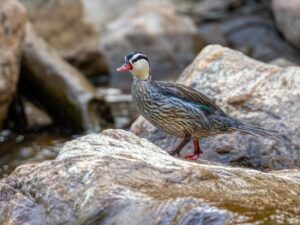
NEOTROPIC CORMORANT
Phalacrocorax brasilianus
Also, known as Cushuri, it can be seen quite frequently in the Urubamba River. Above all, in the lower current areas of the Inca trail hike, swimming or perching on the rocks. In addition, its plumage is black with a slender silhouette that is easy to recognize. On the other hand, there is no difference between the plumage of the male and the female (chromatic dimorphism). Rather, the juvenile is dull brown in color and is the only freshwater cormorant on the Inca trail.
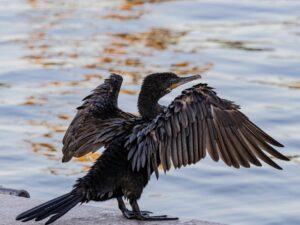
FASCIATED TIGUER HERON
Tigrisoma fasciatum
It is located on the banks of the river or on the rocks. In addition, it is unmistakable for the design of its plumage. Since, it is brindle with a white line that goes from the chin to the chest in the central part in adults. Meanwhile, juveniles are brindle brown. It is one of the few herons that climbs to these heights and is almost always seen alone.

VIOLET EAR BELLY BLUE / VIOLETEAR SPARKLING
Colibri coruscans
One of the species of hummingbird that we will find more easily during the first hours. After, start the walk until after lunch. It is an easy bird to recognize. Because of, his song that resounds in this first section of the Inca Trail hike. It has a diameter between 13.5 to 14 cm including the beak. Likewise, when observed with binoculars, the tuft of purple feathers in the lower part of the ear can easily stand out. The easiest way to locate it is to follow its edge that will surely lead us towards the bushes. We will probably find it perched on a branch.

THE GIANT HUMMINBIRD / GIANT HUMMINBIRD
Patagonas gigas
Its size ranges from 20 to 21 cm, which is why it is the largest hummingbird in the world. Since it is large, its flapping is slow. Therefore, recognizing this species is easy. Also, most of his time flies among the tops of eucalyptus bushes and trees. Meanwhile, it flies and in low light a dull reddish color is distinguished for its plumage. On the other hand, in good light its gray plumage is distinguished in the upper part of the rump. However, if it is not observed during the walk, it is easily found in the camping area (Wayllabamba).
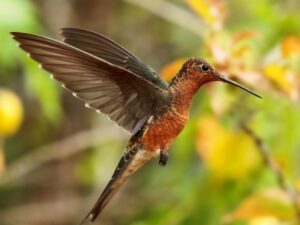
TÓRTOLA OREJUDA / EARED DOVE
Zenaida auriculata
Called locally as “Cuculi”. This singular turtle dove is normally found. Almost always in groups in open fields and growing areas; measures 28.5 to 31 cm; one of the peculiarities. Also, it has are the white feathers on both wings that are easily noticed. Meanwhile, it is in flight. To be able to locate it, it is enough to observe the cultivation areas that are found after lunch, which is regularly in the Tarayoc area.

CERNÍCALO AMERICANO / AMERICAN KESTREL
Falco sparverius
Recognizing it is very easy. Since it is very skilled when flying, it moves with great speed and lunges. Immediately, before any bird that enters your domain. Above all, it is found perched on power lines, fences, and dry trees. We will surely find it along the first day’s journey, it is the smallest and most common kestrel in Peru. It has a difference in color in the plumage between the male and the female. The male has a reddish mantle. Similarly, both wings are blue. The female. Meanwhile, the mantle and wings are reddish.
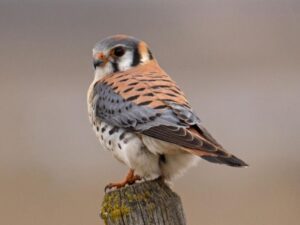
MITRED PARAKEET
Aratinga mitrata
They move in groups of 10 to 15 individuals. For this reason, they are very boisterous when flying. We will surely see it between the Tarayoc sector and the first camp. Meanwhile, they fly in circles and take breaks to eat fruit in the trees. For this reason, they often observe perches and the red feathers on their forehead are clearly visible. Moreover, it is easy to photograph them in the camps. Since, they can be found perched in the branches of the trees, around the camping areas.
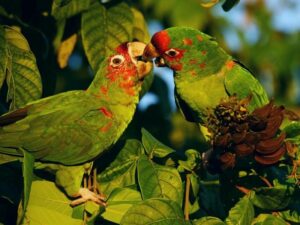
BEARDED MOUNTAINEER
Oreonympha nobilis
It is a fairly large endemic hummingbird, 15.5 – 16.5 cm. It is observed between 2700 to 3900 m. Also, the females are similar to the males in color only that they are more opaque. Also, they do not have the green and purple feathers at the bottom of the bill. On the other hand, most of the time they are seen flying or perched in the Nicotianas.
Where do we find this endemic bird on the Inca trail hike?
We can find this species from the Inca Trail entrance control Piscacucho to Llaqtapa in its surroundings.

GREEN AND WHITE HUMMINGBIRD
Amazilia viridicauda
Its plumage is green and white, it is often confused with the Amazilia chionogaster. Likewise, its habitat is humid forests and it moves on the canopy. On the other hand, it is a fairly common species to observe in Cusco.
Where do we find this endemic bird on the Inca trail hike?
We will observe it in the Piscacucho area, Cusichaca valley, Wayllabamba camp and the entire Machupicchu area.

RUSTY FRONTED BASKETBALL
Asthenes ottonis
A difficult species to observe. Since, it generally remains hidden in the bushes with a diameter of 18 cm. Similarly, it is quite common in areas with the presence of cacti in the dry intermountain valleys. Also, it can be seen in the Polylepis forest.
Where do we find this endemic bird on the Inca trail hike?
Throughout the Cusichaca valley (beginning of the Inca trail), up to Wayllabamba.
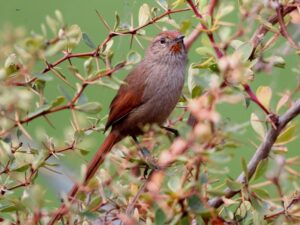
CREAMY CRESTED SPINETAIL
Cranioleuca albicapilla
It has a cream-colored crest that stands out when you look at it. Also, it is small with a long, crimson tail. Its displacement ranges from 2,500 to 3,800 m. Likewise, we can find it in semi-humid shrubby areas with scattered trees. Also, it can be found in Polylepis forests.
Where do we find this endemic bird on the Inca trail hike?
During the entire first day to the Uncas forest, located in the upper part of the Wayllabamba camp.

CHESTNUT BREASTED MOUNTAIN FINCH
Poospizopsis caesar
It stays between 3000 to 3800 m. It is the largest monterito that exists in Peru. Mostly, we find it at ground level or at the base of shrubs in rocky mountain thickets.
It has a black mask with white feathers on top and bottom. Also, the chest is scarlet and the rest of its body is gray.
Where do we find this endemic bird on the Inca trail hike?
In the Wayllabamba area to Llulluchapampa.

BIRD WATCHING DURING THE SECOND DAY OF THE INCA TRAIL HIKE
The second day will be approximately 7 km of walking. From the Wayllabamba camp to the sector called Llulluchapampa we will find an ecosystem of the Interandino Valley. Later, you will cross the first mountain pass “Warmiwañuska” (the dead woman’s pass), where vegetation is sparse. Similarly, there is presence of dwarf trees Queuñas (Polylepis), Chachacomos (Scallonia) where grassland areas predominate. Since, they will enter the ecosystem called Puna.
SWORD BILLED HUMMINGBIRD
Ensifera ensifera
Its diameter is 19.5 cm including its peak that measures 7 cm. It is very surprising to behold it. Due to the long beak it possesses. It is in the Wayllabamba camp. During the entire climb to Ayapata we can find it surrounding the Daturas flowers.

SHINNING SUNBEAM
Aglaeactis cupripennis
It measures between 10 to 12 cm. Most of the plumage is dark brown. In addition, the mantle and rump are iridescent lilac-gold in color, with a small bill. We can observe it. During the walk from the Llulluchapampa sector to the first mountain pass (Wiñayhuayna). Almost always perched on the upper branches of the bushes located along the ascent. Likewise, it generates a song that sounds very messy to the ear. Recognizing it is relatively easy. Because, it is one of the few species that we have on the Inca trail hike of brown color.

WHITE TUFTED SUNBEAM
Aglaeactis castelnaudii
A very easy species to recognize. Since, almost entirely it is dark brown with a small tuft of white feathers on the chest. Similar to the Radiant Sunbeam / Shining Sunbeam (Aglaeactis cupripennis), a species with which it can be confused. Because both are similar in the color of their plumage. However, the plumage of our endemic bird is much darker. Likewise, its size is 11 – 12 cm including the 1.5 cm peak, it moves from 2500 to 4600. In fact, it sometimes descends to 2200 m.
Where do we find this endemic bird on the Inca trail hike?
We will be able to observe the Ayapata sector up to Llulluchapampa upper part. During, the second day.
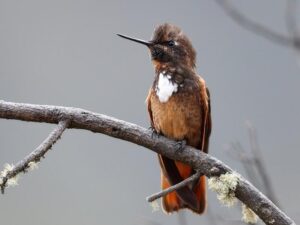
MARCAPATA SPINETAIL
Cranioleuca marcapatae
This species has two variations: weski that has a white crest towards the Vilcabamba mountain range and tag for Cusco. Meanwhile, its elevation range goes from 2400 to 3350 m.a.s.l. However, it has a reddish-brown crest, wings, and tail. Also, the rest of the body is dark gray that becomes lighter towards the face with a white eyebrow. Finally, it feeds in the lower part of the vegetation of the cloud forest and bamboo areas.
Where do we find this endemic bird on the Inca trail hike?
Throughout the Pacaymayo Sector.
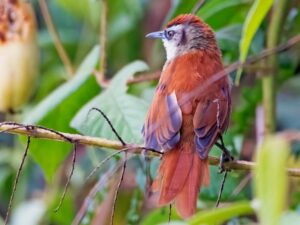
YELLOW BILLED TIT TYRANT
Anairetes flavirostris
It is found between 1900 to 4100 meters above sea level with a diameter of 10.5 – 12 cm. Moreover, known among bird watchers as “Torito”. Due to, it has a small tuft of feathers that are pronounced over the head. Similar to small, black antlers. It is a beautiful species to observe. Since its plumage is striated between black and white, it is very peculiar. We can find it walking in pairs or alone in the Pacaymayo camp and its surroundings. Especially active towards sunset (dusk). Also, in the first hours of the day (dawn) moving through the bushes.
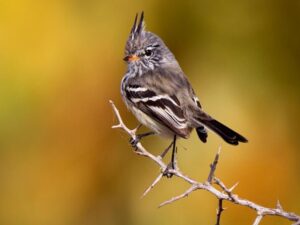
BLACK THROATED FLOWERPIERCER
Diglossa brunneiventis
Black throat flowerpiercer, 14 cm long. In addition, it presents a difference in the color of its plumage between the juvenile and the adult. Juveniles are dark brown for the head, mantle, and rump. Also, its chest is striated in brown and pale cream colors. Meanwhile, adults wear bright colors as shown in the photograph. During the day they are seen hopping among the purple flowers of the Melastomataceae. Also, in the crown of the Polylepis seedlings. During the entire ascent and descent of the Wiñayhuayna pass.
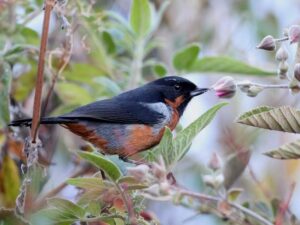
MOUSTACHED FLOWERPIERCER
The Moustached Flowerpiercer is geographically variable All forms are black with a broad white malar stripe (moustach) and rusty undertail coverts. The sub-species albilinea has solid black underparts and a blue shoulder patch. The sub-species unicincta has a rusty breast band while the sub-species pectoralis has also the rusty breast band bordered by a white pectoral band. The juvenile is dusky brown with brown streaks below and a white malar stripe. It forages along forest edges, and humid scrub. It is readily distinguished from the Black Flowerpiercer and Glossy Flowerpiercer by the white malar stripe.
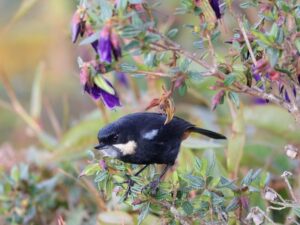
BLACK-FACED BRUSH-FINCH
The Black-faced Brush-finch has blackish upperparts, tail, and sides of the head. The crown and nape are rufous. The throat is blackish. The underparts are dingy yellow. It forages in dense shrubbery near the ground along forest edges and semi-open habitats. It may overlap with the similar Tricolored Brush-Finch and Vilcabamba Brush-Finch but is distinguished by having a blackish throat and dingy yellow rest of the underparts.
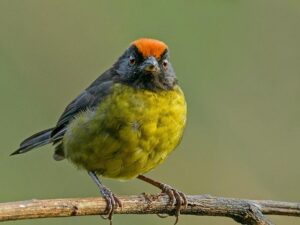
HOODED MOUNTAIN TANAGER
The Hooded Mountain-Tanager is blue above and yellow below. It has a distinctive black hood and bright red iris. It forages in the canopy of montane forests in family groups or along with mixed species flocks. It is similar to the Buff-breasted Mountain-Tanager but is distinguished by larger size, and a lack of bluish on the forehead.
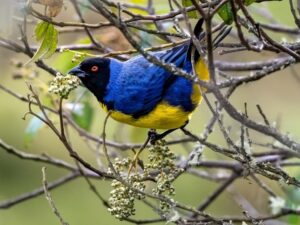
MASKED FLOWERPIERCER
The Masked Flowerpiercer is all blue with a red iris and black mask. It forages in the canopy of humid montane forests as well as forest edges and second growth, often in the company of mixed species flocks. It is similar to the Bluish Flower piercer but is distinguished by the a blue coloration and black mask.
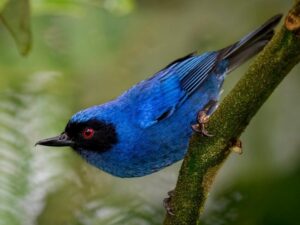
BIRD WATCHING DURING THE THIRD DAY OF THE INCA TRAIL HIKE
The Paq’aymayo camp is located in an Andean Páramo. Also, called the Jalca region (according to the classic distribution of the altitude floors of Peru). In other words, humid montane grasslands with small shrubs and scattered patches of forest.
After leaving the camp, the ascent begins to the second mountain pass “Runkurakay” located in the Puna area. After about 45 min of descent we enter a unique ecosystem known as “Cloud Forest” as its name mentions, in this area there is a great presence of clouds and fogs. Therefore, the humidity of this area is increased, ferns, mosses and orchids abound.
VILCABAMBA TAPACULO
Scytalopus urubambae
It has a black beak and eyes. In the same way, its plumage is gray and brindle towards the part of the tail in black with chestnut. Also, its size varies between 11 to 12 cm. On the other hand, its habitat is the places with mosses and rocks between 3500 to 4200 meters above sea level and humid forests of Polylepis in the Urubamba valley.
Where do we find this endemic bird on the Inca trail hike?
This endemic bird can be found in the Runkurakay mountain pass. During the walk on the third day.

JUNIN BASKETBALL
Asthenes virgata
Its altitudinal range goes from 3300 to 4600 m.a.s.l. On the other hand, it is a very striking small bird, striped brown with almost entirely white. Also, the lower part of the body and tail are brown. It can be confused with Asthenes urubambesis. However, this other species is smaller. It searches for food on the ground among tufts of grass. In addition, when scared away, it seeks refuge at the base of the bushes.
Where do we find this endemic bird on the Inca trail hike?
In the descent of the Runkurakay pass (Second day).
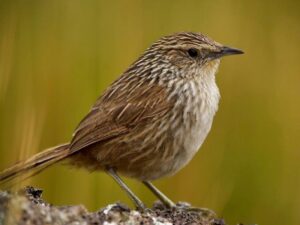
RED AND WHITE ANTPITTA
Grallaria erythroleuca
In a peculiar shape and design and this makes it very pleasing to the eye. Since, it measures only 17.5 cm and moves at ground level among the thickets of montane forests. Due to its striking color it can be located. Since, it has a lighter dark orange color towards the face with a white streak in the lower part of the beak and throat. It is also a solitary bird.
Where do we find this endemic bird on the Inca trail hike?
We found this species from the Chaquicocha area to the first tambillo (Small Inca construction) after crossing Phuyupatamarca.
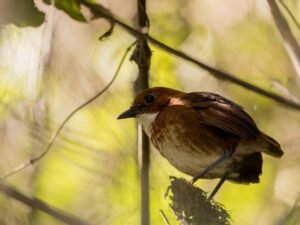
ASH CHEST TORITO / UNSTREAKED TIT TYRANT
Anairetes or Uromyias agraphia
Most of the time he maintains an upright posture with a greyish body, a black crown and a white eyebrow. Meanwhile, its distribution ranges from common to uncommon in the Polylepis valleys. It is a common member of mixed flocks.
Where do we find this endemic bird on the Inca trail hike?
He is a bamboo specialist, areas that we can find. During this time, the descent from Phutupatamarca to the first tambillo.
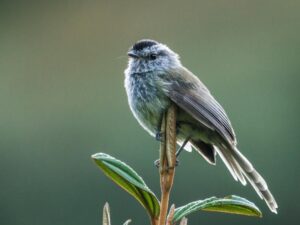
YELLOW SCARF TANAGER
Iridosornis reinhardti
Black eye, bill and legs. However, it has a black head and a yellow spot towards the back of the eye. Meanwhile, the rest is from the body is blue. Also, this species can only be found in Peru in high elevation cloud forests. Likewise, it moves with mixed flocks and feeds on fruits and insects.
Where do we find this endemic bird on the Inca trail hike?
From the Phuyupatamarca mountain pass to Wiñaywayna, it is frequently found in mixed flocks.
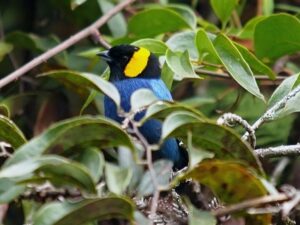
CUSCO BRUSHFINCH
Atlapetes canigenis
This bird is not usually grouped with other species. It also has brown eyes, a reddish-orange crest and its body is gray. Consequently, it forages alone or with its partner at ground level, it is distributed in the southern part of Peru.
Where do we find this endemic bird on the Inca trail hike?
In the woods for a second day. Also, it is located in the descent of the Phuyumatamarca pass.

PARODIS HEMISPINGUS
Kleinothraupis parodii
Its habitat is the humid dwarf forests of the southern Andes. As a consequence, it has a beautiful olive yellow color throughout the body that becomes more intense in the eyebrow. In addition, it belongs to the group of tanagers.
We can see it alone or as a couple. Rather, it is frequently observed in the mixed flocks that we find in the cloud forest of the Inca trail. Furthermore, it can be confused with Myiothlypis luteoviridis and Myiothlypis signata. However, its beak is grayer, thicker, and larger than the other two species.
Where do we find this endemic bird on the Inca trail hike?
It is a common member of the mixed flocks that can be observed, from Phuyupatamarca to Wiñayhuayna.
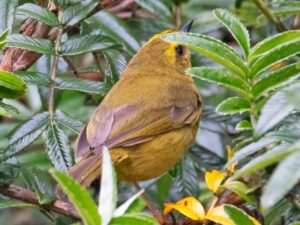
INCA WREN
Pheugopedius euophrys
We will find it only in bamboo areas. Also, the color of their plumage varies according to their geographical location. However, they are mostly brown and gray with black and white faces and mustache stripes. Meanwhile, in most of Ecuador and in southwestern Colombia, it has black dots or scales on its chest. On the other hand, elsewhere it lacks the chest markings and has a black or brown crown. Finally, they hide in the dense bamboo. Therefore, it is easier to locate them due to their strong duet songs that are heard over long distances.
Where do we find this endemic bird on the Inca trail hike?
In bamboo areas, located in the descent of the third mountain pass of Phuyupatamarca and Machupicchu.
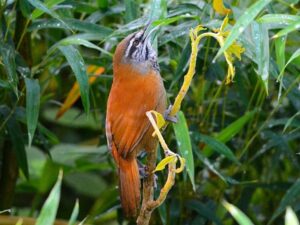
TIT LIKE DACNIS
Xenodacnis parina
Since, it presents a chromatic dimorphism (variation of color in plumage between female and male), we will observe a blue color. Almost, in the entire body of the male without counting the primary feathers that are black. However, the female has a pale red chin, throat, chest, abdomen and flanks. While, in the sector the back, primary coverts and primary feathers of dull brown color. Also, his crown is blue. Surely, we will find it at the second Runkurakay mountain pass. After, the first half hour of descent it can be observed in open spaces (on the rocks) and the top of the bushes.

GREAT SAPPHIREWING
Pterophanes cyanopterus
A kind of large size 17 – 18 cm. Therefore, when flying, a slow flapping is noticed. Meanwhile, the males have an emerald color except for the wings that are blue. The females. Rather, they are emerald in color with brown underparts (chin, throat, chest, abdomen, and flanks) and blue primary feathers. Surely, you will find it in the surroundings of the archaeological center of Sayaqmarka.
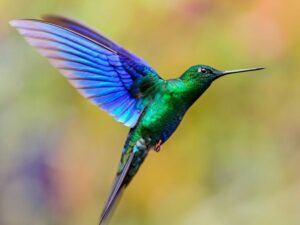
SAPPHIRE VENTED PUFFLEG
Eriocnemis luciani
Of the genus calzadito (Ericnemis). Above all, we find it in dwarf forests. During birdwatching on the Inca trail hike we found it in the bush area. Before that, reach the second Pacaymayo camp and all the descent from the second Runkurakay mountain pass. In fact, when observing it, it easily highlights the white feathers on both legs and their blue undercovers.
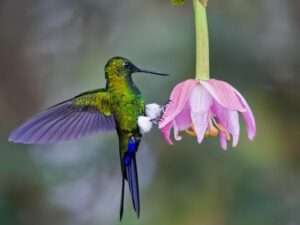
SCARLET BELLIED MOUNTAIN TANAGER
Anisognatus igniventris
Very striking at first glance for its scarlet red and black colors, it measures 18.5 cm in length. Meanwhile, the juveniles have the same color as the adults. However, this one is more opaque. Consequently, it is observed in the descent of the second and third mountain passes that are covered on the second day, they alight quite frequently among the upper part of the bushes.

GOLDEN COLLARED TANAGER
Iridosornis jelskii
One of the most striking tanagers for the Inca trail hike. Due to its golden necklace located towards the back of the head that makes it very attractive. Also, both genera have the same plumage color. Above all, its habitat is dwarf forests, humid scrub between 2,900 – 3,700 m and can descend to 2,500 m. Consequently, it moves with mixed flocks (a combined group of birds that move through the cloud forest hunting for insects). Also, there is the entire descent of the third mountain pass “Phuyupatamarca” along the entire length. Above all, it moves in the middle and upper part of trees and bushes.
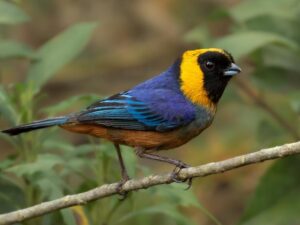
TROPICAL KINGBIRD
Tyrannus melancholicus
Consequently, it is found in the upper part of the bushes near the banks of the river. However, it can be seen accompanying the mixed flocks that we can hear all the way to the Puerta del Sol. Since it measures 22 cm, it is a medium-sized bird. In addition, it has a gray crest and chin with an inconspicuous black stripe at eye level. Next, the chest and abdomen are pale yellow.
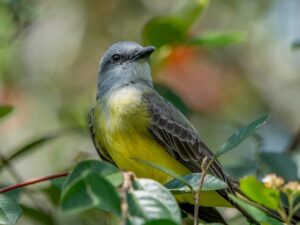
MASKED TROGON
Trogon personatus
It is located in high montane forests (1100 to 3300 m). Almost always we can find it perched on the branches of medium and large trees in the wooded area of the Wiñaywayna camp. In addition, it should be noted that it is one of the most beautiful birds on this route, it measures between 25 and 26 cm. Likewise, it presents chromatic dimorphism. The male is bright black, green and red in color. Meanwhile, the female has a black mask around the eye, a red abdomen and the rest is brown.
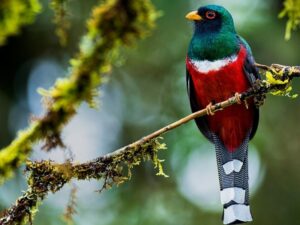
DUSKY GREEN OROPENDOLA
Psarocolius atrovirens
The male measures between 41 to 43 cm. Meanwhile, the female is smaller in size 33 cm. Also, both genera have the same plumage color. It is located in humid montamos forests that are located between 800 to 2600 m. During the first three hours of Inca Trail km 104 we can easily locate it. Because their nests are built like gray pendulums that are very striking. In addition, they present a lot of activity. Since, parents are observed entering and leaving them frequently. His song is loud and very loud.

BLUE GRAY TANAGER
Thraupis episcopus
Despite the fact that they are normally distributed at 2000 m it can be found on the Inca trail. On the other hand, the juvenile has almost the same colors as the adult. However, it is of a duller shade and without a white marking on the brim. Meanwhile, it moves in the cloud forest, we will place it in the lower layer of the canopy. Also, we can observe it perched on cables and trees found in the town of Aguas Calientes.
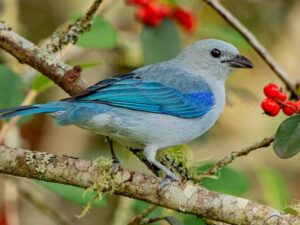
ANDEAN COCK OF THE ROCK
Rupicola peruvianus
Male has elegant crimson plumage with black and white wing feathers. It is also easy to recognize as it moves through the treetops. On the other hand, the female has a small crest and is brown in color that helps protect her from predators. In addition, it is hidden under the shelter of the achupallas (reddish tree plants).
It is a very rare bird to observe. Since, it is found in cloud forests located at a lower altitude. However, if there is an opportunity to observe it, it will be at the beginning of the walk in the rocky area of the Urubamba river. Because it was previously reported.
It should be noted that normally this bird moves in the canopy and canopy area of the cloud forest.
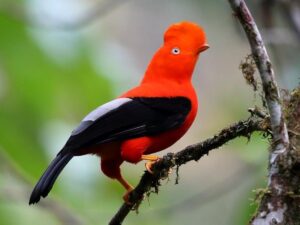
BIRD WATCHING DURING THE FOURTH DAY OF THE INCA TRAIL HIKE
The walk starts very early in the morning. It is a short distance of only 5 km to reach the Puerta del Sol (Entrance to Machupicchu). During this first stretch of walking, bird watching will be difficult. Because this part of the road has narrow areas that are heavily traveled by travelers.
Cloud forest, it is an ecosystem with a lot of vegetation and humidity. Due to these characteristics, the landscapes that we will find in the last part of the Inca trail will be abundant in vegetation and birds.
INCA COLLARED
Coeligena torquata
Its size varies between 13.5 – 14 cm. While we observe it, it is easy to distinguish the white feathers that they have on their chest with a white drop in the eye ring. Likewise, it has an iridescent crown that varies between purple and green. However, the females are more opaque, it is found over 2,000 m.a.s.l.
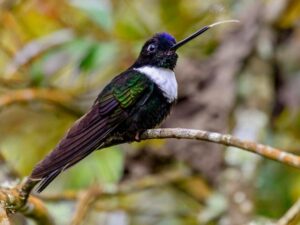
SLATE THROATED REDSTART
Myioborus miniatus
Meanwhile, we observe the birds of the Inca trail, we find it in pairs, towards the lower and middle levels of the bushy areas, even on the ground. In addition, it moves frequently with mixed flocks that exist below 2,600 m.
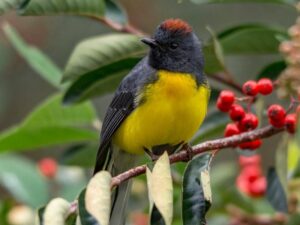
WHITE WINGED BLACK TYRANT
Knipolegus térimus
When it is perched, a totally black bird is observed (beak, eyes, plumage and legs). However, in flight, white stripes are seen in the central part of the primary and secondary feathers of both wings. Also, highly distributed throughout the citadel of Machupicchu and its surroundings.

MASKED FRUITEATER
Pipreola pulchra
It is a very colorful bird. Since it has a black head, yellow throat, pale yellow chest and the rest of the body is green. Also, the beak is pink, the eye is yellow and its black legs show chromatic dimorphism. Since, the females are almost completely green. It perches discreetly in the middle part of the humid montane forest. Because, there he finds trees with fruit and occasionally joins mixed-species flocks.
Where do we find this endemic bird on the Inca trail hike?
It is located at the height of the valley. Therefore, we will take into account the area of the botanical garden and the town of Aguas Calientes.

SPECTACLED REDSTART
Myioborus melanocephalus
Frequently integrates mixed flocks. It is found from the extreme south of Colombia and south to Bolivia. Mostly cloud forests. It has pale gray upperparts. As well as yellow underparts and yellow lens-like feathers around the eye with an orange crest. In addition, it tends to actively feed along the branches, spreading its tail.

STARRED WOOD QUAIL
Odontophorus stellatus
Almost always, it moves at ground level in groups, pairs or alone. Its diameter ranges from 24 to 26.5 cm. While the male’s crown is reddish, the female’s is brown. Consequently, we will hear it at the Puerta del Sol and Machupicchu and they usually cross the paved road without fear of travelers.
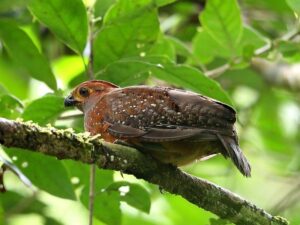
ANDEAN GUAN
Penelope montagnii
Widely distributed in humid mountainous forests ranging from 1700 to 3450 m. However, they walk in groups or alone. Dull brown in color with a small ridge. Also, at first glance it resembles in shape a hen with a slender silhouette. In addition, it is fruitful; It is located in the surroundings of the citadel of Machupichu. Consequently, he is observed on the descent section of the Puerta del Sol. Above all, walking in the sloping branches of medium to large trees where it looks for its food. It is almost always very social if one approaches cautiously otherwise they tend to fly away.

EMERALD TOUCANET
Aulacorhynchus atrogularis
The Emerald Toucanet is all green with chestnut undertail coverts and chestnut tail tip. The lower mandible is always black. The amount of yellow in the upper mandible is variable and color of throat varies according to the sub-species. It can be blue, dusky, or pale. It is similar to Chestnut-tipped Toucanet but is distinguished by having chestnut undertail coverts and yellow in upper mandible. Also similar to Blue-banded Toucanet, but it is distinguished by having a blue or black throat, no red uppertail coverts, and black and yellow bill.
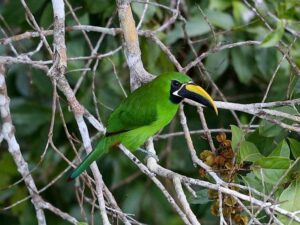
SPOTED TANAGER
Tangara punctata zamorae
Spotted Tanager is mostly green above and whitish below with dense dusky specks on the upperparts and underparts. It forages in the canopy of montane forests. It is similar to the Yellow-bellied Tanager but is distinguished by having speckled underparts without yellow on the belly.
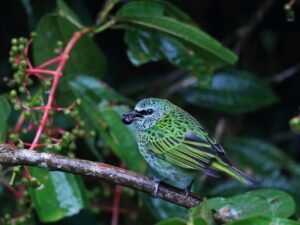
ANDEAN MOTMOT
Momotus aequatorialis
The Andean Motmot has green upperparts that shade into blue towards the wings. The underparts are greenish tawny. The crown is bright blue with a black center. It has a black mask fringed with blue and a long tail with a bare-shafted racket tip. Andean Motmot is larger, overall greener, and range at higher elevations than closely related Amazonian Motmot.
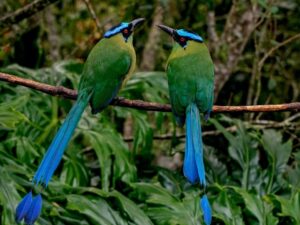
If you are going on the Inca Trail hike to Machu Picchu, you may be surprised to stumble upon so many varieties of orchids along the inca trail trek!
There are a great diversity of orchids species in Perú, some restricted to their natural regions. They are epiphytic or terrestrial. They grow between 100 and 4,600 meters above sea level. Many of orchids species of Perú are in danger of extinction due to illegal trade and deforestation of their habitat.
There are literally thousands of orchid species in Peru, many of which are located in the low cloud forest eco-regions around Machu Picchu and along the famed Inca Trail Hike. It is estimated that as many as 50% of Peru’s more than 3,000 orchid species remain unidentified by science.
The diversity of microclimates in Peru allows a great variety of orchids. They have been appreciated since pre-Columbian times by the native cultures of Peru.
ORCHID CHARACTERISTICS
The Orchidaceae family is one of the largest among the superior plants and its distribution is worldwide; the described species are estimated at 25,000, distributed in 750 genera.
Their growth habits are very varied and can be separated into two large groups: epiphytes and terrestrial (within this group are lithophytes), including even an underground species (Rhizanthella gardneri), which grows in Australia. In the tropics most of the orchids are epiphytes and very showy flowers, while those of temperate zones are terrestrial and of little attractive flowers.
The orchid flowers are generally hermaphrodite and bilaterally symmetrical. In the vast majority of the flowers are made up of three external elements called sepals, two lateral and one dorsal, and three internal elements called petals, the lower one modified on a lip or lip, larger and more intense in color than the remaining.
The lip is often trilobed with fleshy ridges or a basal spur, and often with a completely different color pattern than the other two petals.
Orchids are a well-distributed and extremely varied plant family, often with fragrant, colorful and bizarrely shaped blooms. The Orchid family is one of the largest families of flowering plants, containing around 600 genera, and comprising approximately 10% of all seed plants. All orchids are myco-heterotrophic, meaning they form a relationship with fungi in the soil in order to get their nutrients. Because of their vibrantly colorful, often strange and perfumed blooms, orchids seem to possess a certain mystique that has captured the imaginations of humans from time immemorial. In fact, dedicated orchid horticulturists and enthusiasts have been known to compete, fight over and even commit crimes in the service of their obsession.
POLLINATION
Its flowers have great diversity in color, shape, size and smell, with the sole purpose of attracting pollinators, most of which are insects, which in many cases are specific to certain species. The flower has evolved to such a degree that some take the shape and smell of the female of the pollinating insect, in order to “attract” the male of the same species. Another developed strategy is to take on the appearance of a male insect, which, when “detected” by another male of the same species within its territory, is attacked and fertilization of the flower is achieved.
The seeds are very small and are produced by thousands and even millions for each fruit. This high production compensates the difficulties for germination, such as the lack of reserve substances in the seeds, its low viability and the need for germination of a type of fungus that provides nutrients until the plant is autonomous.
97% of the orchid species need a pollinator to carry out the transfer of the pollen grains from one plant to the pistils of another, in order to produce fertilization and seed formation. The pollen of orchids is grouped into compact masses called polynyas, in such a way that by itself, or by the action of the wind, the pollen cannot get from one flower to another, so pollinators are essential to ensure their reproduction.
These pollinators are very varied and, depending on the species, they can be flies, mosquitoes, bees, wasps, butterflies, beetles and birds, especially hummingbirds, which are in charge of collaborating with the reproduction of this beautiful flower.
Orchids are normally pollinated by bees, birds, wasps, moths, beetles, flies, etc. When the orchid opens, it emits aromatic essences, inviting and seducing some pollinators to land on the flower. In Machu Picchu there is a fascinating pollination, as it is a refuge for exotic birds, and more than 300 species of Butterflies, which makes pollination an incredible multi-colored spectacle, in one of the most impressive ecosystems on the planet, made up of covered mountains of abundant vegetation that in turn is home to numerous species of birds and mammals in danger of extinction, such as the spectacled bear and the sachacabra or pudú, the smallest deer in the world.
It takes three to seven months to mature, after this time it opens. Depending on the orchids species of Perú, each fruit can release up to four million seeds that, when released and dragged by air currents or transported by pollinators, manage to germinate if they reach a trunk or branch, giving way to symbiosis with the fungus of the germination, the first leaves appearing. After 5 or 6 years the orchid will reach its adult state, stage from which beautiful flowers will sprout for several years.
FEEDING
Another peculiarity of orchids is found in the roots, which are completely covered by a fluffy, creamy white tissue, called a canopy, which allows it a high uptake and moisture retention.
Orchids are mistakenly thought to be parasitic because they grow on other plants. In reality, the only thing they seek is to reach a maximum of light by locating themselves in the upper parts of the trees; In addition, the orchid feeds on the humus produced by the decomposition of the leaves of the trees and on the nutrients it can collect from the rainwater, never from its host.
WHERE SHOULD I LOOK FOR ORCHIDS?
The regions where orchids species of Perú can be found are those that have the cloud forest ecosystem, such as San Martín, Amazonas, Piura, Huánuco, Junín, Pasco and Cusco, according to Bravo Urtecho. “Where we find orchids most frequently are regions of the central jungle due to the cloud forest ecosystem.
Contrary to popular belief, orchids are not found in the predominantly hot places. Epiphytes and lithophytes grow on trees and stones, including many of the most spectacular species, which tend to concentrate where there is constant and strong rainfall and humidity during the growing season, allowing the forest to allow light to pass through. Diversity tends to peak almost everywhere at around 1500 meters in the tropical and sub-tropical world. Typically, the environment these species need is normally rocky and mountainous, and this is exactly the case in Peru.
The main center for orchids species of Perú is the mountain cloud forest, the point where the Andes end and the jungle begins. These areas of Peru can receive more than 5 meters of rain per year. In these areas diverse valleys unite, some more humid and others drier, as well as the climate itself, where the changes move from North to South. As a result, plants vary greatly, with altitude and valley.
THREAT
Peru probably has the greatest diversity of orchids worldwide, because we have a wide range of microclimates, which circumscribe species in highly restricted areas with very specific climatic characteristics, making it difficult for many species to grow outside their environment. natural.
Currently in Peru, the Orchidaceae family is highly threatened and with many species in danger of extinction, mainly due to two factors:
Selective depreciation of species, carried out for export purposes by commercial collectors
The massive destruction of habitats due to logging and migratory agriculture, which deforest about 300,000 hectares per year, thus exterminating not only orchids, but also the native flora and fauna of the place.
Obviously, the rainy season (November to March) is the best time to see orchids in Cusco Perú, especially in the cloud forest; which is an area outside the Inca Trail hike between 1,800 masl and 3,000 masl.
There are 425 varieties of orchids in Machu Picchu Cusco, including several new species for science.
There are more than 400 species of orchids in Machu Picchu Cusco, some of them originating from this natural area protected by the State and several are new to science.
The prestigious international magazine “Icones Orchidacearum” published in 2015 an article about the discovery of three new species unknown to science: “Epidendrum ochoar”, “Epidendrum inca huamani” and “Epidendrum mormontoy”.
Treks to see orchids in Perú:
Wiñay Wayna Orchid: (Epidendrum Secundum) found at Machu Picchu and along the Inca Trail hike, this is an orchid with multiple white to fuchsia blooms. Each flower is around an inch in width. Wiñay Wayna means “Forever Young”; Wiñay Wayna Pass on the Inca Trail hike takes its name from this flower. The orchid is pollinated by both butterflies and birds. Flower essences made from this orchid are said to preserve youth and vitality.

Paradise Orchid: (Sobralia Dichotoma) is one of the most common orchids in the region on the inca trail hike to Machu Picchu. This orchid has 5-8 flowers per stem, and is deep pink and white in color. It’s an ephemeral orchid, lasting for only a few days and blooming between February and April. Its essence is said to have a calming and grounding effect.
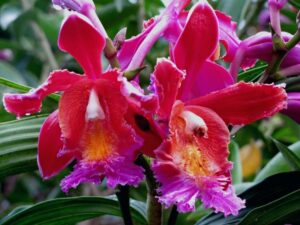
Waqanki Orchid (Masdevallia Veitchiana) This orchid’s common name in Quechua, Waqanki, means “ You will Cry.” This is a single-flower orchid that grows in crevices on rocks. It has orange sepals with purple spots on the sides. A Quechua legend recounts that an Inca princess’ forbidden love for a common soldier led to the creation of this orchid.
With beautiful petals in litmus; The great variability in the color and shape of its flowers means that no camera can capture it in all its splendor, being highly appreciated by growers around the world, which has earned it many international awards. Finding a beauty like this in its natural environment is part of the experience offered by the sanctuary of Machu Picchu and Inca Trail hike. It develops between 2,100 and 3,310 meters of altitude, of terrestrial habit and rarely epiphyte. It is used a lot for the creation of hybrid species. It can measure up to 20 cm long by 6 cm wide. The Waqanki orchid is considered a national treasure of Peru.

Cryptocentrum Inaequisepalum C. Schweinf.
This tiny species measures just 8 mm, its strange shape provides its name, which derives from the Greek meaning pointed tongue, it extends from Mexico to Brazil and Bolivia, it develops in rainforests and humid forests with temperatures from warm to cold, from sea level up to 2,600 meters of altitude.
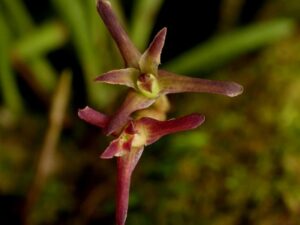
Kefersteinia Koechlinorum Christenson.
It is an epiphytic, medium, uniflora plant, like the tulip or magnolia, with 2.8 x 2.8 cm flowers. It can be perceived by its aroma similar to coriander. Its flowering lasts for 15 days. Discovered by the late gardener Moisés Quispe, (dragged by a huayco years ago) and can be found from sea level.

Odontoglossum Praestans Christenson.
Epiphytic orchid that spreads through countries such as Ecuador, Colombia, Peru (Cusco and Cajamarca) and Bolivia, we can find it between 1,700 and 2,100 meters of altitude. So simply beautiful that it inspires peace. It is found in the humid subtropical jungle and the humid sub-tropical jungle of the sanctuary. It can be found in bouquets of up to a dozen, with a scent between jasmine and roses.
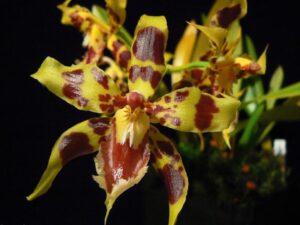
Maxillaria Alpestris Lindl.
This little girl is found growing as an epiphyte and lithophyte, in Venezuela, Colombia, Ecuador, Peru (Amazonas, Cajamarca, Pasco, Cusco, Puno) and Bolivia. In the Historic Sanctuary of Machu Picchu it is found from 2,060 to 4,150 meters of altitude, it develops in humid mountainous forests, growing in the form of a vine.

Cyrtochilum Minax
Endemic to the Historic Sanctuary of Machu Picchu, it blooms between August and October, it is found from 1,500 to 3,600 meters of altitude, especially in cloud forests with cold climates, it presents long-stemmed bouquets of few flowers, of 5 cm. long by 4 cm. Wide.

Chondrorhyncha Aurantiaca Senghas
Epiphytic plant from warm to cold areas, which extends from 500 to 2,400 meters of altitude, it is found in Peru and Bolivia, easy to find in the Historic Sanctuary of Machu Picchu. It develops in the humid subtropical forest and the humid sub-tropical premountain forest, it presents a single flower of about 10 cm. long, sprouting from the base of the plant simultaneously.
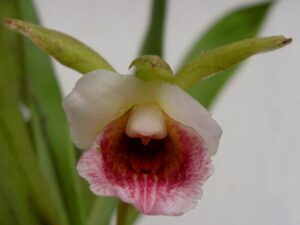
Bletia Catenulata
Variable in size with two to four lanceolate leaves. Formosa plant (presents spheroidal bulge), its flower varies from 4 to 5 cm. long, it has stems with about a dozen purple-pink to fuchsia flowers. The highest flowering is from January to February.
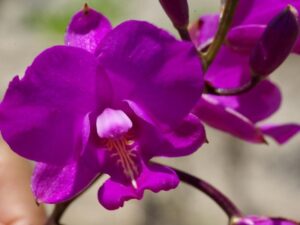
Oncidium Scansor
Epiphyte. Pseudobulbs: It has impressive bright yellow flowers with red-brown spots, they are 2 to 5 cm in size. long. Lip prominent, discoidal, unifoliate. Its flowering time goes from February to May.

Phragmipedium Caudatum
Terrestrial and Epiphyte, with leathery leaves. Petals brownish-purple, large, some of them reach 20 to 80 cm. long. Two blooms a year have been reported, May, June and February. This is the largest orchid flower that exists.
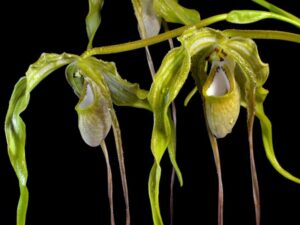
Prosthechea Vespa
Terrestrial, it has creamy red-brown speckled flowers with elongated pseudobulbs, two to three leaves; It has a size of 2 to 3 cm. long. The largest flowering is from November to April.
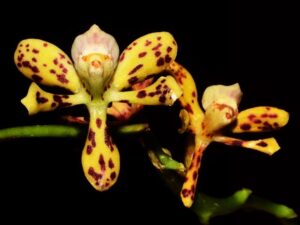
Pleurothallis sp
Epiphyte and terrestrial, quite smooth leathery leaves. With 1.5 cm long flowers, and creamy green to yellow on sepals and petals. Flowers from October to December.
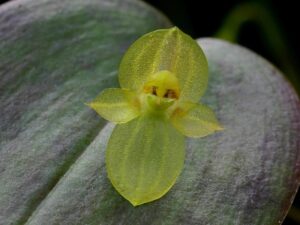
Ida Macrophylla ( Lycaste macrophylla)
Terrestrial and Epiphyte. Presents cavities, which give the sensation of grooves. Generally 2 to 3 leaves; flowers 6 to 9 cm. wide, dark brown sepals, petals and creamy white lip, its flowers are long lasting. Flowers from November to January.
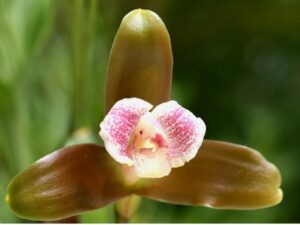
Anguloa Virginalis
Terrestrial, it has dark green pseudobulbs, ovoid, with two to three leaves. With a flower that measures 7 cm. long, white with purple-pink spots on the lip, sepals and petals. Flowers from October to November.

Telipogon Papilio
Clearly epiphytic. Short stem and oval leaves. It has a flower 4 cm long. Yellow-green sepals and yellow petals, with purple veins. Column with purple brown mushrooms. Flowers from April to June.
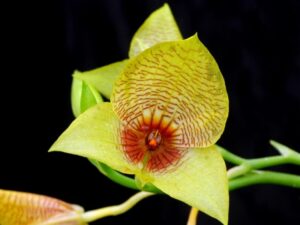
Masdevallia Karineae
Epiphyte or lithophyte. Sepals light purple to pale pink with purple spots. Large leathery leaves, up to 12 cm. long, white petals, with a flower that measures approximately 7 cm. long. New species for science. Flowers from December to January.
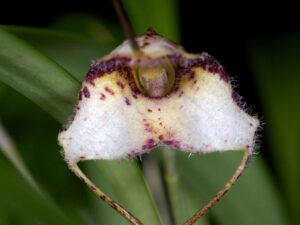
Hofmeisterella Eumicroscopica
Epiphyte. Inflorescence flattened, in racemes, acuminate linear leaves. It has a flower up to 2 cm long. Sepals and yellow petals. Yellow lip with purple veins. Its flowering stage goes from January to February.
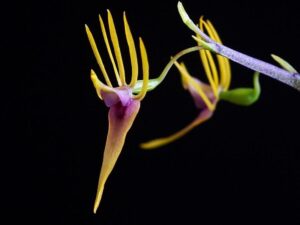
Comparettia Falcata
Epiphyte with cylindrical pseudobulbs, unifoliate leathery. With flowers up to 2 cm, with purple-pink to fuchsia sepals, petals and lip (with a noticeable spur). Flowers from December to March.
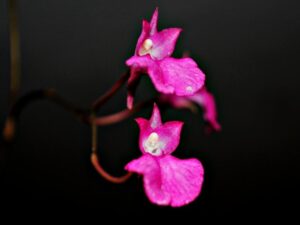
Masdevallia Marizae
Epiphyte. Leaves with prominent petiole, uniflora. With flowers of 6 to 7 cm. long; Whitish sepals with red-purple dots and veins. This species is new to science. It has beautiful white petals.
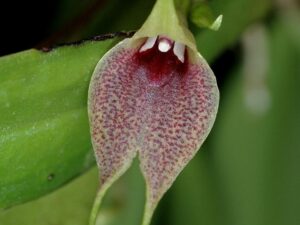
SOBRALIA SATIGERA
Also called “flower of a day” for its short duration and delicacy; It generally grows in the open or under very little shade, in rich, loose soil, somewhat damp. Restricted habitat. 8 cm.
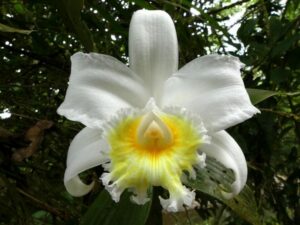
EPIDENDRUM FRIDERICI GUILIELMI
It grows in open places in rocky and mossy soil, with a somewhat restricted habitat, the flower is about 2 cm. Paqaymayu 2,300 masl.

ELLEANTHUS AURANTIACA
It grows in sunny open places or under little shade; in moist and rich soil, forming considerable colonies; wide habitat; the plant exceeds one meter in height; the floral ear measures 10 cm. Wiñaywayna 2,500 masl.
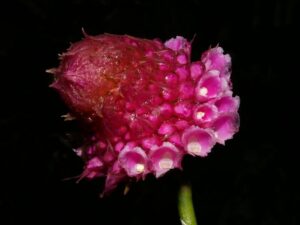
TRICHOCEROS PARVIFLORUS
It grows under the shade of sparse forest; on slightly mossy branches. Gives off an unpleasant odor; it is not very common in the Sanctuary. Restricted habitat. 2 cm. Patallacta 2,800 masl.

In the Historic Sanctuary of Machu Picchu, more than 700 species of butterflies have been registered (300 diurnal and 400 nocturnal). Many of these species are endemic and others migratory. Along the Inca Trail hike they can be seen through their fragile flights. These are very colorful: there are blue, yellow, white, red and even transparent wings.
The mysterious world of butterflies was present in the time of the Incas. These magical insects were present in his ideology since they were related to the “Hanan Pacha”, that is to say, the world above where the tutelary gods lived (the sun, the moon, the stars). Butterflies were related to the soul and longevity. A sample of this are some ceremonial plates, found in 1911 by Hiram Bingham.

The butterflies of Machu Picchu date back more than 100 million years, and have adapted to the environment to survive. These butterflies are very important in Machu Picchu and along the Inca Trail as they help pollination of flowers.
Butterflies are both diurnal and nocturnal insects, they have extremely colorful wings. Their antennas allow them to pick up smells, sounds, and vibrations. Their eyes are made up of ommatidia that allow them to see at great distances. So they capture many colors. His eyes are green, blue and white.
Their long legs have joints through whose plants they capture different flavors. They are fed by their tongue, which has two tubes that function as taste sensors. These tubes wrap them around their head when they are not used.
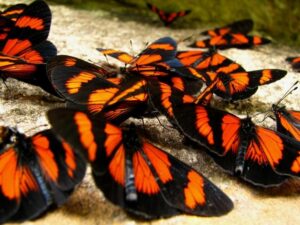
At Machu Picchu and the Inca Trail hike, butterflies have many predators, of which the most dangerous are birds. However, butterflies have been able to develop a defense mechanism, through their flight, that they do so quickly that they disorient the birds, at the same time that they secrete liquid substances with an unpleasant odor.
During the entire visit to Machu Picchu, or when you do the Inca Trail hike, you can notice the presence of different varieties of butterflies. On the third day of the walk is when you can see the greatest variety of butterflies (especially in the camps of Phuyupatamarca and Wiñayhuayna).
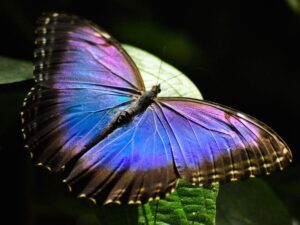
However, there is a place in the town of Aguas Calientes called “Mariposario”. This is an interpretation center of the butterfly biodiversity of Machu Picchu. In this place, through a guided tour, you will be able to know the different species of butterflies that exist in the so-called Historic Sanctuary of Machu Picchu.
The route is also home to different types of mammals, amphibians, reptiles and birds. The most colorful are: the cock of the rocks, the spectacled bear, the Andean deer, the torrent duck and the giant hummingbird.
In addition to butterflies on the Inca Trail hike you will be able to appreciate various types of exotic insects such as: millipedes, crickets, beetles, bees, spiders and more. It is recommended to use repellent against mosquitoes as they can be annoying.
If you are a photography lover you can get excellent butterfly shots, especially very early in the morning. The Inca Trail hike is only done on a tour organized by a tourism agency. Due to the high demand for this adventure, the purchase must be made online 6 or 7 months in advance.
The spectacled bear is also called Andean bear because it inhabits the eastern region of the Andes Mountains in South America. In the Historic Sanctuary of Machu Picchu (an area protected by the Peruvian State) there is a population of approximately 70 bears. These are not easily seen, although sometimes they even roam the Inca city of Machu Picchu. The best occasion to visit their habitat is by doing the 4-day Inca Trail hike.

The Inca Trail hike to Machu Picchu takes 4 days in which visitors walk 39 kilometers. In the last two days of the hike you can see humid tropical landscapes where the spectacled bear lives. This peculiar animal is not aggressive. Likewise, if you spot one, it is recommended to keep a safe distance. In 2021 two spectacled bears walked through the archaeological site of Machu Picchu. In the town of Aguas Calientes there is a conservation center where you can observe these animals.
THE SPECTACLED BEAR
The spectacled bear (Tremarctos ornatus) is one of the eight species of bear in the world (the others are the giant panda, the Malayan, the black from Asia, the bezudo, the polar, the brown and the black from America).
It is known as ‘ukuko’ by the inhabitants of Cusco. It lives in a tropical Andean geography, between 500 meters to 4,500 meters of altitude. This animal prefers to live in the humid forests of the high jungle where there is a lot of rainfall (and fruits with which to feed).
In Peru there is a population of approximately 18 thousand spectacled bears. It is considered to be an animal in a ‘vulnerable situation’. In 1,800 square kilometers of land area, only 5,000 bears have been registered. Yet Peru has the largest spectacled bear population in South America.

DESCRIPTION
The spectacled bear can measure between 1.30 and 1.90 meters tall (standing on its two legs). It has a large head disproportionate to its body. Its tail is small (it measures approximately 8 centimeters). Males are larger than females. They can weigh from 80 to 125 kilos.
It is considered a plantigrade because it supports the soles of its legs on the ground. It has five fingers, with very sharp claws, which allow it to climb trees with ease. It has a short brown muzzle.
The Machu Picchu Spectacled Bear has long, thick black fur. He has a few yellowish, circle-shaped spots on his face near his eyes. Because of this it has been given the popular name of the spectacled bear.

FOOD AND CUSTOMS
He is a vegetarian bear (only 5% of his diet is of animal origin). It feeds preferably on fruits, roots, cuts, leaves and fungi, insects, honey, eggs, rodents, among others.
It has solitary habits. They walk through wooded areas, climb trees, and mark their territory with scratches and scent. Trees are very important to them. It is there where they find their food and specific places to rest.
The female usually gives birth to two cubs. It is considered as a seed disperser and pollinator. He is a sullen bear. Scared easily. The Historic Sanctuary of Machu Picchu is one of the places where ‘ukuku’ can roam freely, although the possibility of being hunted illegally is not ruled out.
Although it is not frequent, on the route of the Inca Trail spectacled bears can be seen. If you see one of these animals, keep your distance with your group. Remember that bears are only looking for food. Don’t scare them away because they can act in self-defense. Follow the directions of the guide who will accompany you.
During the third and last day of the Inca Trail there are more possibilities to know the habitat of the spectacled bear. With a bit of luck, you can even see it walking through the trees of the place. Remember that these animals are protected by the Peruvian State. Therefore, their hunting is a crime.
Threats to the Spectacled Bear in Machu Picchu
In the Historic Sanctuary of Machu Picchu there is probably a population of 70 bears.
One threat is deforestation caused by forest fires and forest clearing. Another problem is poaching. The spectacled bear is considered a threat to livestock. They are hunted and taken into captivity as a circus attraction where they are mistreated.
How to protect it?
In 2009, amid the Inca walls of Machu Picchu, a spectacled bear and its calf could be seen. This came as a surprise to the visitors. Since the 1980s, up to four entries of these bears have been recorded in the park. Spectacled bears prefer to do it very early in the morning or after five in the afternoon.
During the Inca Trail it is advisable not to leave food on the route. This helps not alter your diet and eating routine. If you want to see spectacled bears up close in the town of Aguas Calientes (Machu Picchu town), there is a “Spectacled Bear Conservation Project” at the Inkaterra hotel.
This private conservation project together with the National Institute of Natural Resources (INRENA) rescued three bears: one that lived in a Cusco zoo for almost 21 years. The other was saved from a forest fire. The third was brought by a farmer who kept it as a pet.
Currently there are five rescued bears that are in custody and in the process of re-insertion to their natural habitat. The project accepts voluntary donations for the protection of the Spectacled Bear.
MORE INFORMATION
The spectacled bear, Ukuku or Ukumari, is present in oral traditions that tell that there was once a hairy young man who was the son of a bear’s love affair with a beautiful peasant woman.
The hairy young man is the Ukuku (a typical Cusco dancer who is especially related to the Qoyllur Riti festival). This festival takes place in the snowy Ausangate, near the city of Cusco. Today this religious festival is the largest pilgrimage in the Andes Mountains (it brings together more than 10 thousand people).
The Ukuku wears a suit made of black wool, a white balaclava and emits sounds similar to that of an animal because it is a mythical character. This dancer is also present in other traditional festivities of Cusco.
The visiting time in Machu Picchu citadel is an average of 1 hour and 45 minutes to 2 hours. This is enough time to visit the main circuit that includes the most important sites of the historical sanctuary. Once the guided tour is over, you won’t have much time to visit the site on your own. However, if you have bought the entrance tickets for either Huayna Picchu or Machu Picchu Mountain, the extra hikes, you will have the chance to enter the site a second time.
Huayna Picchu: Average time of the hike is 1 hour and 45 minutes roundtrip. The climb is steep and has small stairs. Therefore, this extra hike is not recommendable for children.
Machu Picchu Mountain: Average time of the hike is 2 hours and a half roundtrip. This extra hike is more recommendable for people who travel with children.
Something important that any traveler must be aware of is the regulations of the Inca Trail hike to Machu Picchu that entities such as SERNANP and DDC-Cusco have established in order to preserve the route. Therefore, we will mention some of the main regulations to hike the Inca Trail 4 days.
You aren’t allowed to hike the Inca Trail Hike on your own. To hike the Inca Trail 4 days, you need to hire the service of a licensed tour operator.
You can’t buy the permits on your own. Only licensed tour operators can get the tickets for you.
Groups shouldn’t exceed 8 tourists. If they are more than 8 people in the group, there must be an extra assistant.
Permits have to be bought in advance since there are limited spots. You can’t buy permits at the checkpoint.
It is not permitted to camp at unauthorized sites.
Above all, It is important to be aware of these regulations and follow them. If not, park rangers will approach you and you will receive a fine for any damage caused.
The permits or entrance ticket for the Inca Trail Hike includes the entrance to Machu Picchu citadel, but it does not include the entrance to the extra hikes to the mountains from where you can see the citadel from above.
For example, Huayna Picchu mountain costs $80 USD per person. In case, you want to hike it you have to buy the entrance ticket to the mountain in advance.
Of course, if you are ok with taking the same train out of Aguas Calientes that is part of your original itinerary, which is typically at 14:00PM that evening than there is no additional charge to move the train back a day. If you need us to secure your hotel or another visit to Machu Picchu, this will be an additional cost. If you do choose to spend one more night in Aguas Calientes, make sure you tell the Andean Great Treks office at least one month in advance, so your train ticket is purchased for the right day.
Most of the groups reach the Sun Gate at approximately 6.00 am. On the 4th last day of Inca trail. You will start hiking towards gates at 4.30 am and will enter the site 45 min. later. The time may vary a little that depends on the placement of campsite, which we will assigned on the last night.
Will I be able to witness the sunrise at Machu Picchu?
In truth it is not typical sunrise. As long as you don´t have too much mist or low cloud then you see the first light illuminating Machu Picchu. It is after dawn though as the sun must rise up over the high mountains surrounding Machu Picchu.
If you are wanting to include an ascent of Huayna Picchu in your visit to Machu Picchu, note that The trail to Huayna Picchu is safe but very vertical and is about an hour and a half round trip beware that there are new regulations since July 2018 and permits have to be bought in advance. If you want us to organise your permit to climb Huayna Picchu and we must have this request in writing and confirmed at the time of your booking indicating you will pay the extra for this permit. Deposit for Huayna Picchu permit is $80 usd .
BUT remember, so in case you will book the huaynapicchu mountain, you will lost the tour guiding in Machu Picchu, because our tour guiding starts at 9:00 am and ends at 11:00 am. So the time to climb up Huaynapicchu is at 10:00 am. And you will not able to go to both places at same time.
When the Inca trail tour is done, we arrive at the citadel at 8:30 am. After a 30-minute break to use the bathrooms, and eat a snack. It begins with the guided tour at 9:00 am. The complete circuit takes 2hrs approx. Then we will all retire as it is not allowed to stay longer in the archeological site, by rules of protection of the Sanctuary. At 12:00 pm approx. We must get off by bus to the city of Aguas Calientes where you can have lunch, and then take the train back to Aguas Calientes.
Upon arriving in Machu Picchu on the last day of the inca trail hike, travelers will be invited to take a guided tour of Machu Picchu. This tour comprehends a visit to the most important places of interest of Machu Picchu,so that temples, palaces, astronomical observatories, houses, fountains, etc. The guided tour takes two to three hours approximately, depending on your interest in the information provided by your tour guide. The guided tour of Machu Picchu takes place along any of the different circuits that the Peruvian government has established. Every tourist circuit runs in a one-way direction, which has a different duration and difficulty level.
Small, ten-litter backpacks are allowed inside the archaeological site. We advise that people take their passports, entrance tickets, small one-liter water bottle, sunscreen, bug spray, sunglasses, cap, and rain gear or rain poncho. Make sure to use the toilets before heading for the guided tour, as there are no toilets inside Machu Picchu. Large backpacks must be left at the luggage storage outside the entry point of Machu Picchu. Large tripods, professional photographic equipment, drones, selfie sticks, and food are not allowed inside.
To many people, the guided tour is just one of many things to enjoy at Machu Picchu or just the beginning of their adventure at this wonder of the world. Machu Picchu offers a bunch of other attractions that can be visited after hiking the trail. Below is a list of all the things you can do while at Machu Picchu.
Huayna Picchu mountain. People can get the privilege to have one of the most impressive climbs inside Machu Picchu from the top of this breathtaking mountain. It takes between 45 minutes to an hour to climb to the top of this steep mountain. Due to high demand, permits must be obtained at least four months in advance to hike this mountain.
Machu Picchu mountain. If hiking the Inca trail for more than four days has not been enough of a challenge for you, then climbing the Machu Picchu mountain is the ‘ice on the cake’. The trail leading to this mountain is perfectly preserved. It takes almost two hours to get to the top, and the views are mindblowing. If you plan on hiking this mountain in the peak season, you will need to make reservations at least four months in advance.
Temple of the moon or Great Cave. The hike to the Great Cave is considered ‘off the beaten path’ as this is one of those places that very few people dare to visit in Machu Picchu. This fantastic place is located in the Huayna Picchu mountain’s back, a few hundred feet above the Urubamba river. The hike is difficult and a bit risky. It takes almost 2.5 hours to complete the full circuit. However, the remains of the Inca Trail and the Inca structures are fascinating,
Inca Bridge. The Inca bridge is located only 25 minutes away from the Guardian’s house at Machu Picchu. The trail goes alongside an impressive cliff that allows for impressive views of the Urubamba river.
The Site Museum displays a great collection of the most important artifacts found at Machu Picchu. If you are a history and archaeology lover, then this is a must-see location. The place is located 35 minutes away by foot from Machu Picchu pueblo.
There are plenty of shuttle buses departing from outside the main entrance of Machu Picchu. The shuttle ride ends at Aguas Calientes main street. From there, there is a 5-minute walk to the train station.
Staying overnight in Machu Picchu pueblo. Those who want to have a more thorough visit to Machu Picchu then stay at Aguas Calientes (Machu Picchu pueblo) are compulsory. This town offers a wide range of hotels, restaurants, massage parlors, and shopping centers for people to remain busy.
There are plenty of tourist trains departing from this town bound to Ollantaytambo and Cusco. The train ride to Ollantaytambo takes about two hours, while the train ride to Cusco takes four hours approximately.
There are two main Inca Trail tours. First, the Classic Inca Trail hike which takes 4 days and 3 nights to complete the hike and the shorter 2 days Inca Trail, the easier and faster way to reach Machu Picchu, but you still experience the last part of famous Inca Trail (you basically will be avoiding second day hike).
Additionally, in case of no available permits, there is a number of alternative tours to get to Machu Picchu such as the tours of Machu Picchu by train or the tour which combines biking, hiking and Machu Picchu tour in 4 days and 3 nights.
Actually, there is no government restriction on the age limit for the inca trail hike to machu picchu. However, because of the challenging trek, we consider it to be best for visitors above 15 years old to 55-year-old adults. Of course, they must be in good physical condition. Certainly, In case a child travels with you, you may need to hire the service of a personal porter who will assist your child along the hike and carry his backpack.
Above all, Adults over 55 years old, should have hiking experience and be in good health condition. This way, they will be able to arrive in Machu Picchu safely.
Most importantly, Training in advance is the key to succeed on hiking the Inca Trail hike to machu picchu. Without it, you may not be able to complete the circuit since the inca trail 4 days presents different types of terrain which go from easy to challenging levels to finally arriving in Machu picchu.
So, performing some activities at home or at the gym will make the difference. You can do activities that make the legs, arms, heart and back work. Consequently, when you start the Inca Trail, your body won’t struggle at the difficult parts; instead, you will be better prepared and, as a result, enjoy the view more. It is recommendable to start training at least 3 or months before your travel date.
Likewise, breathing exercises can strengthen chest muscles and make breathing easier during the inca trail hike to machu picchu. This way, high altitude won’t be a problem for you, not even the 4200 m.a.s.l., which is the highest point of the inca trail 4 days you will be at.
Although, it is not mandatory to have travel insurance to do the 4 day inca trail hike to machu picchu, we highly recommend getting one. This way you can prevent any inconvenience that can happen during your trip such as a flight delay, strikes in the country or city, a natural disaster, or getting sick during the inca trail hike.
To sum up, You should know that getting sick in Peru may be a bit more expensive than other countries. So, Getting travel insurance will make you feel more secure. Insurance companies normally charge you from 100 to 150 US Dollar. Here you have a list of some insurance companies:
We will provide tents which will be set up for you every night at the campsite by our porters.
A compact three-season sleeping bag is recommended. It’s also possible to rent a sleeping bag in Cuzco. They are clean, warm and cost approximately USD$20 (for the three nights). You may also bring a sleeping bag liner or sheet. Foam mats are provided however some travelers also bring their own self-inflating mat. Sleeping bags are not included.
We include in the cost of the tour the foam matress.
This is a fairly thick bulky mat that weighs 1 kg and we still say if you are travelling with a termal-rest or technologically advanced type of sleep mat then definitely bring that instead.
Yes another person of the same sex , or if you prefer you can pay a single supplement for a tent just for you. This is US$ 70 (For the entire trek)
As one of the most frequently asked questions, the highest point of the Inca Trail hike is at 4,200 meters above the sea level, you will spend the night at the campsite at 3.600 meters. It is difficult to say if you really going to suffer from altitude sickness, people are different and are prepared physically different. Most hikers don’t have any issues, but two days rest in Cusco to acclimatize is very advisable, drinking water and chewing cocoa leaves will definitely prepare you for the Inca Trail hike.
Most people have that concern but don’t worry. Only in extremely rare circumstances does a passenger need to come back early. You just need to remember that you are able to go at a speed that is comfortable for you. Take your time, pace yourself, and enjoy.
The Inca Trail hike is considered a moderate hike. It’s not a technical hike but there are a lot of Inca stairs to walk up and down, and the altitude may affect some individuals. We recommend using a trekking poles and have an early night before to start the Inca trail trek.
The physical rating on the Inca Trail hike is level 2-3. On Day 2 of the Inca Trail hike you will be walking uphill from 3000 to 4200 meters above sea level before descending steeply through big steps and difficult terrain. While this demanding walk is the main challenge our passengers face on this trip, it’s also one of the highlights and worth every minute of it.
We recommend that you undertake regular aerobic exercise in the months before you travel, particularly if you are not in the habit of regular exercise. Doing mountain walks or climbing long staircases with a pack is good preparation. Walking, jogging, swimming or riding a bike are all good ways to increase your aerobic fitness, which will allow you to enjoy the trekking to its fullest.
While you don’t need any specific training to do the 4 Day Inca Trail hike, being fit will help. The best preparation for the trek is treadmill exercises with steep inclines and stairs. The second day will be your toughest day, as you will climb up two peaks that day.
This is an approximate breakdown according to our regular campsites:
Day 1: 11 kilometers (6.8 miles) 5-6 hours.
Day 2: 12 kilometers (7.4 miles) 7-8 hours (“Dead Womans Pass,” the highest pass of the trek at 4,200m, is on this day )
Day 3: 16 km (9.9 miles) 7-8 hours. Its the longest day of the trail
Day 4: 6 Km (3.7 miles ) 6-5 hours
This is a frequently asked question. The whole Inca Trail hike takes 42 kilometers (26 miles) to hike. During the hike you will see all the variety of Andean landscapes including snowcapped mountains, rivers, high mountains, beautiful plains and a very sunny sky.
Because all campsites are determined by the authorities we cannot tell exactly how many kilometers per day you going to hike, or which of the campsite is assigned to the group, but be ready to hike at least 6 hours per day up to 8 hours. However don’t worry! This is a chance to take amazing pictures of the surrounding landscape and make these memories last forever.
From 1 to 5 it’s 3, moderately difficult. The Inca stairways to walk up and down in different temperatures and high altitude all that makes this level of difficulty. You can rent walking poles before you start your hike. Those will help you in many ways, we would recommend you get ones if you have some issues with knees or ankles, poles would absorb some pressure from those parts and also help to keep your balance! We recommend you to have a look how to prepare yourself for the Inca Trail hike.
During the 4 day inca trail hike, you will not have Internet connection. Therefore, using a cellphone or any electronic device is not convenient in most places.
To keep in contact with the administrators of the tourist agency and inform them in case of a problem, or to check something important, we use radios or satellite phones.
First and Fourth day: you will have internet connection.
Second day: there is no internet connection.
Third day afternoon: there is internet connection.
However, you will have internet connection at the campsite in Wayllabamba on day 1, it has a cost of 5 to 10 soles ($2 or $30) per hour. You will also have internet connection at the campsite of Phuyupatamarca until you arrive in Machu Picchu, and you will be able to make calls, too. The telephone operators that have better signal are CLARO and BITEL. Other telephone operators don’t have good signals along the inca trail hike, but once you arrive in Aguas Calientes town, you will be able to communicate with your family or friends.
In the scenario that you are unable to finish the inca trail hike due health issues, Andean Great Treks will do everything in its power to get you to the nearest civilization and get help or transportation to help. If the issue is respiratory or due to altitude, we do carry at least one tank of oxygen on trek that you will have access to. In extreme cases, a helicopter pick up can be arranged at your own expense. (Travel Insurance required) There are no refunds in the situation that you are unable to finish though.
Generally if due to altitude sickness people can´t make it over the pass on the 2nd day of the inca trail hike they come back to Ollantaytambo accompanied by a porter if just mild (or guide if serious) and if they recover from altitude sickness they stay the night here in Ollantaytambo and then take the train to Aguas Calientes the next day (Day 3) in the afternoon , you will spend the night in any hotel in aguas calientes, and rejoin your group in Machu Picchu early on Day 4 and continue the tour as normal. The additional costs for this such as train ticket and accomodations will be payed by the customer.
Yes we are able to accommodate many types of dietary needs upon request at the time of booking. If you are a vegetarian, or cannot eat gluten or have allergies to certain foods, it will not be a problem. The meals of our chefs on the inca trail hike are one of the most popular parts of our tours too, and the quality will not be reduced when accommodating your dietary needs. The meals are served buffet style and you are able to choose what you would like to eat. Your guides will let you know what time the meals will be served.
Our inca trail hike cooks prepare excellent high-energy meals appropriate for a classic inca trail hike of this nature. The menu usually includes quinua, cereals and vegetable soups, Beaf Lomo Saltado with rice, chicken cacerole, fresh fruit and vegetables and a variety of oatmeal, eggs and other breakfast foods as scramble egg, quinua panqueques.
There is no drinking water on the inca trail hike to machu picchu. We will provide boiled water at the campsites. You need to bring a camelback or water bottle which will be refilled.
Therefore, this will be provided on the day agreed with the agency you have hired which can be since the second or third day. It is also recommendable to bring pills or water purification bottles, ultraviolet water purifiers, portable suction filter or portable filtration pump. This way, you could drink water from the rivers and streams.
You can buy them at some points of the inca trail hike, from day 1 to day 2 (Llulluchapampa). However, you will notice that they cost a bit more than in the city. And with all reason since it implies a great effort to take these products from the city to these areas not only it is expensive but also challenging for the altitude.
We include some snacks in our tour. However you can contribute to local small businesses. You should know that tourism is a form of economic growth for families that live in the high Andean regions where the main activity is agriculture.
There are different kinds of campsites on the inca trail hike each night. That is to say, some of them don’t have restrooms and showers. Having that said, we will mention what you will have at each of the most popular campsites:
Wayllabamba (1st campsite):
There are bathrooms that belong to the local people who rent them to the tourists. They cost S/ 1.00 to S/ 2.00.
No showers
Pacaymayu (2nd campsite):
There are bathrooms and showers with cold water. Since they are property of SERNANP, they are free.
Wiñayhuayna (3rd campsite):
There are bathrooms and showers with cold water. Since they are property of SERNANP, they are free.
So, If you are traveling with a tourist agency, there is no need to worry about the restrooms. The tourist agency will carry portable toilets. Some of the porters will carry the portable toilets that tourists will use. At this point, you may wonder who carries the waste of the toilets. If so, you should know that since waste can’t be thrown along the inca trail hike, porters carry this type of waste in special bags.
It’s impossible to predict who will be affected by altitude. Your ability to adapt to high altitude is determined by your genetic makeup and has little to do with fitness or health. Most people will have no problems as long as they take the time to acclimatize properly. A full day spent in Cusco (3399m), taking it very easy and drinking plenty of water is enough for some people but if you can arrange to have minimum 2-3 days in case of any travel disruptions as well then this is what we recomend as there is also so much to do here. The highest point you will reach while hiking the Inca Trail hike is 4200m/13818 ft. You will sleep at 3340m/10988 ft for two nights.
The inca trail hike is perfectly safe during the rainy season. Some people actually like to go during the rainy season because there are fewer tourists. If you are one who doesn’t mind the rain, then we say ‘Go for it!’ You will just have to bring good rain gear and waterproof boots.
The Inca Trail hike has many difficulty levels depending on which route one decides to take.
Each inca trail itinerary has its level of difficulty that is based on a few factors such as the number of days, the highest altitude reached, and the fitness level, experience, and acclimatization to the altitude of the hiker.
For instance, the Salkantay Trek + Classic Inca Trail hike is the most difficult of them all because it covers a much longer distance, more days hiking, while the highest altitude to be reached is 16,000ft / 5,000 m.
These things determine that the difficulty level of this inca trail trek is strenuous.
Conversely, the Short Inca trail route is the easiest route, as it takes only 7 hours to be completed and the altitude is not that much of a problem.
The classic four-day and the five-day routes start at the town of Piscacucho or 82Km, while the two-day option starts at the 104Km or Chachabamba and the Salkantay trek + Classic Inca Hike starts at Soraypampa.
Yes, you do need a permit to hike the Inca Trail hike to Machu Picchu.
Everyone who hikes along any of the four routes of the Inca Trail network of roads to Machu Picchu must have a permit.
This is includes tourists, tour guides, porters, and cooks.
According to the ‘Plan Maestro’ or ‘Master Plan’ of Machu Picchu, elaborated by the Ministry of Culture of Peru and Sernanp (National Service of Natural Protected Areas) in 2003, only 500 people a day can access this place, Roughly 300 of them are porters and 200 are tourists.
Also, 300 people a day are allowed to enter the Short Inca trail trek.
You must do some research before you choose a tour provider. Cheap tours involve poor service and mistreatment of porters. See the chapter on Sustainable travel and porters’ rights.
What is usually included in these tours is the following.
Fitness is important but more important than that is acclimatization and experience.
In the world of trekking, hiking for one day is one thing; hiking and camping for several days is another, while hiking and camping for several days at high altitudes is an entirely a different situation.
No matter what category you fall into amongst those three levels, the Inca Trail Hike is not recommended for people who have never hiked, nor is it advisable for people who suffer from heart or respiratory problems.
If you are capable of hiking at sea level for at least 5 hours non-stop, then you are very likely to succeed at inca trail hiking to Machu Picchu
What will determine your success is the time acclimatizing to Cusco’s high altitude before the inca trail trek, the weight that you carry in your bag, and the psychological commitment that one devotes to it.
Age is also not a problem; there have been people in their late 70s or early 80’s who have completed the full length of the inca trail to machu picchu.
Also, hiking at high altitudes might be difficult for heavy smokers and other people with breathing conditions.
Most inca trail tour operators will gather the members of their group tours in one location where they will meet their tour leaders and receive a pre-trek presentation with all the details about their journey. On this occasion, you will have the last chance to re-check dietary options, update passport information, and hire the necessary camping gear and extra porters. Be sure to attend such a gathering and ask the essential questions.
The food served on the Inca Trail hike is as delicious as it is diverse. Chefs are highly trained and very competitive with one another.
The meals are gourmet and made of the immense variety of the product grown in the fertile Andean valleys. For many people, the food people eat on the Inca trail hike is much tastier and healthier than what they eat at tourists’ restaurants in cities like Lima and Cusco, especially when it comes down to preparing these impressive meals under such difficult conditions of cooking inside a camping tent.
No matter what dietary option people have, be that, vegan, vegetarian, pescatarian, lactose or gluten-free, etc., chefs on the Inca trail will make sure they meet your requirements.
Depending on what tour provider one hires, lunch and dinner usually include buffet-style meals made of poultry, beef, fish, veggies, and other staples such as quinoa, potatoes, and rice.
In Peru, the main course is always preceded by a bowl of soup. As for breakfast, porridge, hot chocolate, coffee, eggs, and pancakes is what is mostly served. In addition, tourists get every morning, before the hike, a snack bag containing a sandwich or dry fruit and nuts.
Taking the time to hike the Inca Trail to Machu Picchu is worth every penny. The trek is considered to be one of the greatest adventure experiences on the planet. There are very few places where you have an opportunity to walk through awe inspiring terrain while passing 500 year old archeological treasures. And at the end of your adventure you are rewarded with a breathtaking view of Machu Picchu.
The Inca Trail hike , or the Camino del Inca, is one of the most important features of South America’s past and present, and the trek to Machu Picchu is unlike any other adventure in the world. There are very few trails where you can actually walk through history like this. On this adventure, you will continuously encounter 500-year-old Incan archaeological sites, and at the end of the trek, you receive a great reward as you ascend the Sun Gate and reach the legendary Machu Picchu site.
Another factor that makes the Inca Trail hike to Machu Picchu trek one of the best adventure experiences on the planet is the diversity of the terrain that you will encounter along the way. Whether you are climbing stone staircases, crossing wooden bridges over rivers, weaving through tropical jungles, or navigating through cloud forests surrounded by mountain peaks, it is truly once-in-a-lifetime journey. Along the way, you may even spot curious llamas, alpacas, spectacled bears, enormous condors, and various other fascinating Peruvian fauna!
The high-altitude ruins of Machu Picchu are located on a mountain ridge 7,972 feet above sea level at the end of the Classic Inca Trail Route, in the Urubamba Province of Southern Peru. When looking at a map or satellite imagery of Machu Picchu, you can see that it is hidden within deep forestation, 50 miles northwest of Cusco (the former Inca capital).
Known as one of the ‘New Seven Wonders of the World’ and officially recognized as a UNESCO World Heritage Site, there are plenty of excellent reasons to visit Machu Picchu at least once! As the most widely recognized surviving symbol of the Inca Empire and one of the most important archeological sites discovered on Earth, this Andean landmark is guaranteed to excite even the most experienced adventurer. Striking in both its natural beauty and rich cultural heritage, thousands of people come from all over the world to explore the site each year, and the ancient site has in turn inspired countless musicians, artists, and photographers. The Inca Trail hike to Machu Picchu trek is for any adventurer who is ready to travel back through history and follow in the footsteps of our Inca predecessors.
There are a number of trekking routes along the Inca Trail hike to Machu Picchu. However, the Classic Inca Trail hike is a 3 to 5 day hike, and on average, it takes 4 days and 3 nights to reach Machu Picchu. For those short on time, there is a shorter route to Machu Picchu. This trek starts at Kilometer 104 on the Trail and only takes one day to hike to Machu Picchu.
Other Inca Trail hiking tours, such as the Salkantay Trek, will be discussed later in this guide.
However, if you would like to visit Machu Picchu but do not wish to do an Inca Trail hike, you can take a train from near Cusco to Aguas Calientes, a town at the base of Machu Picchu, in just under four hours. For the most luxurious option, the truly peerless Hiram Bingham train takes you down through the Urubamba gorge, amongst spectacular mountainous vegetation and cloud covered forests. The train itself is almost a time capsule, beautifully appointed with rich, polished woods, fine fabrics, and historic furniture. Large windows allow for excellent views on either side of (and above!) the train. You will find it hard to get off the train at the end of this ride! Additionally, there are two other PeruRail train options to Machu Picchu: the iconic and modern Vistadome, and the affordable Expedition trains.
From Aguas Calientes to the citadel’s entrance area, you can take a 15-minute bus ride, or you could walk up the hill (approximately 45 minutes). Don’t forget to book Inca Trail permits for your visit well in advance of your trip! You can find out more about the Machu Picchu permitting process near the end of this guide.
There are multiple water sources along the Inca Trail hike, such as streams or rivers. Most tour companies utilize either a pump filtration system, boil water, or combine both methods in order to purify water during the inca trail trek. Typically, you will be provided with potable water three times per day: at breakfast, lunch, and dinner. It is essential that you fill up your water containers each time you have the opportunity because the hike can be strenuous, and temperatures can get hot during the day. In our experience, we have seen many other trekkers on the Trail run out of water prematurely because they underestimate how much water they will require. We recommend that you have a minimum of 2 liters of water for both the morning and afternoon treks. Depending on your personal preferences, you can either use 32 fluid ounce (1 liter) Nalgene bottles or reservoir-type water systems (such as Camelbak). It is also wise to have salt tablets or electrolytes to add to your water. Additionally, if you are the type of person who likes to be extra prepared, the below items are popular options as a personal backup:
There are limited spots for the Inca Trail hike, only 500 spots. These spots are not only for tourists but for guides, porters, chefs, assistants who will assist you along the inca trail to machu picchu. This means that about 230 spots are for the staff mentioned and only 270 spots are available for tourists. Before booking your tour with any licensed tour operator, make sure there are spots available for your desired date. Otherwise, you won’t be able to do 4 day inca trail hike. Remember that permits are sold fast.
Andean Great Treks is considered the number one ethical tour operator of the inca trail to machu picchu in Peru.
It has been recommended widely in many renowned media platforms such as National Geographic, Lonely Planet, Fodor’s Travel, Matador Network and Al Jazeera to name a few.
In 2020, there were over 200 tour providers authorized to run tours on the Inca trail to machu picchu. Choosing a inca trail tour operator might be a daunting experience, especially considering the number of options. Obviously, you will want to find one that accommodates your budget, has a very good reputation, and offers the type of tours that you wish to take – be that a private or a group tour.
The criteria recommended for choosing a inca trail hike tour operator should consider the following points:
Customer satisfaction ratings usually can be found in some user-generated websites where people leave reviews of their inca trail trek experiences. Places like Google Business, Facebook pages, and Trip Advisor are a good place to start looking for a inca trail tour operator. However, they should not be the sole reason to choose a inca trail tour provider, as there are other important things to consider.
Ethical practices. Traveling to places like inca trail to Machu Picchu, where having superb eco practices and the most ethical treatment of the supporting staff is involved, should invite people to do more thorough research. In the case of the latter, checking in with the Federation of the Porters of the Inca Trail will help you deal with this point. As for the former, the best place to determine that will be on the trail once you complete your hiking.
Media reputation. Usually, reputable tour operators’ best practices can be found in media articles covering their activities. These online sites cover issues such as customer experience, ethical practices, and other related matters. Also, the internet has a vast array of places where one can found a list of best inca trail tour operators.
People must consider a correlation amongst these criteria in what past customers have to say and what porters and online articles have to add to that feedback.
As early as possible as many chances you have to get your reservation complete before tickets maybe be sold out quickly. We would recommend you to reserve your tickets for Inca Trail 3 months in advance for the low season (between November to March) and at least 6 months before you planning visit Peru in high season (April to October). Note that we cannot guarantee the availability so it’s on you how early you going to book and make sure there are still tickets left (check the official Inca Trail Availability).
We try to make booking as easy as possible at Andean Great Treks. We need a booking form that is completed and includes all details for the entire party on one form please, and then a $250 deposit per person. The deposits can be paid separately, as long as we have one booking form that we can use to track payments. Once we have all deposits and details, we will then book your permits. When permits are in our hands, we will send you your invoice and confirmation that everything is 100% set. All start dates, once confirmed, are guaranteed.
Only licensed Inca Trail tour operators, like Andean Great Treks, can obtain permits from the government. Once your permit is secured, the name and start date can not be changed, under any circumstance. The only information the government permits us to change is the passport numbers.
One of the most frequent questions we hear from hikers is, “Do you need a permit to trek to Machu Picchu?” On the list of necessities every traveler needs to remember when making travel arrangements, one of the most important – but also one of the most unexciting and often overlooked – is obtaining permits to hike the Classic Inca Trail to Machu Picchu route!
Because the Peruvian government protects the historic landmark for its natural and historical significance, only 500 individuals are allowed on the Classic Inca Trail hike each day from Kilometer 82. Around 300 of these will be porters, guides and other staff, which leaves room for 200 trekkers that can join the trail per day.
Due to the worldwide popularity of this trek, permits must be purchased before you leave for Peru – sometimes many months before a trip commences! These permits for Inca Trail reservations used to go on sale in January of each year. However, for the 2022 season, permits went on sale in October 2021. It is important to note that in past years, once on sales permits for April and May have sold out entirely in just a few days, and in some years permits for June, July, and August have sold out as early as mid-February. So, it pays to plan and choose your dates at least six to nine months in advance. Once you decide on the times that you would like to go , Andean Great Treks secure your permits to hike the Inca Trail.
If traveling in a group, it is essential that your group or party reserves Inca Trail permits in a contiguous ‘block’ at the same time. In our experience at Andean Great Treks, we have seen several instances of a group or a family unit not doing this despite warnings. As a result, some of these parties have not been able to hike the Trail together as a group. Even a few minutes or hours can make a difference!
Please also note that the permitting system is carefully structured to prevent people and organizations from abusing it. Travel companies and tour operators cannot buy Inca Trail hike permits in bulk to resell at a later date. In order to obtain a permit, you will need to provide a full name, date of birth, passport details (passport number, country of issue, date of issue, and expiration date) and the dates you want to trek the Trail. Once the application for a permit is submitted, it typically takes anywhere from 24 to 72 hours to get a response from the Peruvian permit authority (through the Peruvian Ministry of Culture). This means that until a successful confirmation is received, you should not book flights to or hotels in Peru. Also, be aware that you will be required to pay a security deposit when initially booking the permit. If the permit is not secured for any reason, this deposit can be refunded. When a permit is successfully secured and paid, the deposit is no longer refundable.
Another critical thing to know is that after a permit is secured, you cannot change travel dates. If you can no longer go on the trek as scheduled for whatever reason, you will forfeit your deposit and the permit will go unused. Unfortunately, you can not transfer your Inca Trail permit to a friend or family member.
If you get a new passport after securing a permit, you must contact your tour operator to resubmit the new identification information to the Peruvian permitting authority. Please ensure that the passport you bring with you to Peru matches the permit’s details – otherwise, you will not be allowed to begin your Inca Trail tour! If you changed your passport, it would be wise to bring both the old and new passports to Peru. There are multiple permit checks performed along the way, and the agents are thorough!
To hike the fantastic Inca Trail 4 days, you need to bring your personal identification documents. The names in the permits must match the information in your documents. Therefore, make sure you provide accurate information to the agency you are booking the tour with. If the information is not accurate, you won’t be able to do the Inca Trail hike:
You must bring with you any of these personal documents that you used at the moment of booking. Otherwise, you won’t be able to do the Inca Trail 4 days. Make sure you have your personal documents with you all the time. Put them in a safe place before and during the inca trail hike.
Note: If you have updated your passport some days prior the trek, you have to let the agency know and ask them to update the new information. If possible, bring both the old and new passports. You should also send a copy of both the old and new passports to the agency.
Certainly, There is a small discount that the Culture Ministry gives to minors or students who have a valid student card. A student card is considered valid if it shows the following features:
Expiration date, which has to be the year that the student visits Machu Picchu (NOT a year early or later to the visit date)
Note: To apply for the students discount, you shouldn’t be over 25 years old.
The government will only allow us to change passport numbers if we have a copy of the new passport and old passport. If you no longer have your old passport, any government issue ID will be accepted, as long as the name is the same. Also, make sure your passport does not expire six months or less from your trip.
The only time that you can change your dates with no penalty charge is, if we have not purchased your permit yet. Usually we try to purchase the permits, at the most, the same day yo do the reservation for the Inca Trail.
If we do not already have your permit you can change your date. If we already have your permit, the penalty to change is US $150 and there must be availability for the date which you want to move to.
The Park of Machu Picchu requires a valid passport to issued your permit to the inca trail hike,best case is to organize your new passport in advance if that is the case. There is the possibility due to the limits of spaces on your requested date to book with your old passport number, them we can do a paperwork to change it.
Usually we only charge the deposit of your Inca Trail to the card to confirm your booking. The balance is paid on your arrival to Cusco in cash. If you choose to pay with credit card you need to pay 5% commission. The prices of the tours are for cash payment. You can withdraw US $ out of the ATMs, which there are plenty in Cusco.
There is very little possibility of a cancellation of inca trail hike by the DRCC (Park Office) even under extreme weather circumstances or even in case of a strike there will be no cancellation. The DRCC or Andean Great Treks cannot change the date of inca trail trek if there is a general strike. We do everything possible to ensure you get to the inca trail head to start the trek .
Only licensed and authorized inca trail tour operators are able to book a permit for travelers.
Every year, on October 1st, inca trail permits become on sale for all tour providers who must compete for these permits on a first-come, first-served basis.
To secure a inca trail hike permit, they must submit the necessary personal information of their clients, together with a partial payment and those of the porters and cooks that will assist them along the trail.
April, May, and some dates in June and July usually sell out quickly.
It is recommended that anyone wanting to take a Inca Trail hike to Machu Picchu hike during those months should make arrangements for these permits ahead of October 1st.
Also, all Inca trail permits are non-refundable, non-changeable, and non-transferable.
People need to be 100% sure of the dates that they are booking. Once tour providers submit their information with the park management of Machu Picchu and inca trail, it is unlikely that any changes can be made.
We work with the best brands of trekking tents, such as The North Face, Mammut, Eureka, Ferihno, Salewa, Doite, Mountain Hard Wear. Our tents for the Inca Trail to Machu Picchu are kept clean and in the best condition for the outdoors every time we finish an expedition. Normally the measurements of our tents are length (2m), height (1.2m), width (1.5m). If in case you have a larger size, we can organize a special tent for your comfort.
A very important issue to answer is that all the way from the Inca trail to Machu Picchu, you spend the night on hard surfaces, so we give you a foam mat, if you want more comfort, it is recommended that you bring your own mat inflatable.
Andean Great Treks will include a personal porter in your Inca Trail hike to Machu Picchu, who will carry 6 kg of your belongings. But if you are going to take more things for the Inca trail hike. It is possible to hire a personal porter who will be in charge of carrying your belongings, up to a maximum of 20 kg. Keep in mind that you should also carry a small personal backpack, to carry water, or a jacket. This personal porter does not keep up with your group, they leave the camp before you, and all your things will be waiting for you when you arrive. The costs to hire a personal porter are $ 120 usd for the entire tour.
Porters are humble people who live in the high Andean area of Cusco. In their communities, they raise domestic animals and are dedicated to agriculture. Therefore, It is common to see locals trading their products with people from nearby. Those are their main source of income for most families.
Porters are the backbone of the Inca Trail Hike. Their work consists of hauling all the necessary camping gear and food from campsite to campsite until the Inca trail hike to Machu Picchu is completed.
According to the Federation of Porters of the Inca Trail hike, there are approximately 8,000 porters registered with the Peruvian government based in Cusco. Most of them are men, and only a fraction of less than one percent are women. Most of them are young men between the ages of 18 and 45 who come from many distant villages located as far as 100 miles away from Cusco. A good portion of them are farmers who work only part-time, while the rest are people who have migrated to Cusco due to lack of employment and opportunities in their small villages.
Porters’ regulations. According to the Peruvian government rules in the National Sanctuary of Machu Picchu, all the male porters must carry a maximum of 20 kgs / 45 pounds – this weight includes their personal belongings and the things needed for the comfort of the tourists. In addition, inca trail tour operators should provide them with food, shelter, and gear to work in the outdoors. The average salary a porter makes for the four days of the Inca trail hike is 230 soles / 70 USD.
Women porters. Since 2017, some inca trail operators have been hiring women porters as part of a campaign to empower women. Inca Trail Tour operators should include women as porters and guides and pay them equally as men. Make sure that your inca trail tour operator guarantees these ethical practices. By doing so, you will set the conditions for your investment to go to the right hands and in the right way.
Sustainability. Most inca trail tour operators brand themselves as Sustainable, Eco-friendly, and Ethical. However, the reality of the Inca trail treks has shown that this is far from the truth. Porters are fundamental to the operations of the Inca trail treks. They perform a backbreaking job, literally. Without them, it would be simply impossible for most people to try hiking in this place.
Some renowned international media outlets have written extensively on the rights of porters and responsible travel.
The exploitative conditions in which porters have been working are unacceptable. All travelers who hike to Machu Picchu must ensure that their tour providers abide by a certain standard in which porters are treated like human beings.
Inca Trail Tour providers should ensure that porters should have decent nutritious food equal to the food tourists consume, backpacks that will not hurt their backs, and tents of the same quality as the tents tourists use.
Andean Great Treks provide everything you need for the hike. Consequently, the porters are the ones who carry all the things needed for the adventure. These things include cooking utensils, tents, food supplies, chairs, among others.
The tents will be set once you arrive at each campsite. Porters will arrive earlier than you and set everything for you can rest during the inca trail hike. This way, you will have one less thing to worry about and have a pleasant resting time.
If you are carrying some of your personal belongings such as your own camping equipment, it will be you who sets everything up after a tiring day.
According to the Porters Law – Inca Trail to Machu Picchu Nº 27607, article 3rd, the weight has been limited to 20kg. This includes a 5kg personal allowance.
When the porter is a woman, the weight limit will be reduced according to the regulations, including the 5kg of personal belongings.
All the supplies must be provided by the agency and guarantee their use. Of course, in case there is any change, it must be informed and agreed by both the employer and employee. The following are the things that each porter should receive for the inca trail 4 days.
The most important is to hire the service of tour agencies that look after their porters. You can testify how the agency you have chosen treats their porters since the first day and along the inca trail hike. So, check if they have proper outfit and if at campsites they receive quality meals. A good way to interact with them is by engaging in a conversation. Likewise, You can ask about their history and legend of the town or the importance of coca in their culture.
Don’t wait for them to start the conversation since they are shy and speak Quechua and Spanish. Some tourists also give some personal help for the porters such as clothes, shoes, or any kind of support. Porters of inca trail to machu picchu will definitely appreciate the kind gesture.
This is a common question tourists often ask. They want to be sure they are giving a fair tip and take enough money with them. Most tourists would like to show their gratitude for the effort porters and guide make on the strenuous inca trail hike 4 days.
The tips collected from the tourists are given to the chef who will distribute them among the porters.
If you feel a certain porter has worked harder or has done something special for you, you can tip him personally. This way you can make sure he receives what he deserves. Sometimes the distributed tips are not equitable. Another thing you have to consider giving a reasonable tip for the inca trail 4 days. If you give more than expected, the risk is that porters would splurge it. Therefore, resist the urge to over-tip.
Note that tips are NOT mandatory. The amount of money you are willing to give should be based on the service you have received along the inca trail to machu picchu. It can be classified as bad, regular or good. Each person in the group can contribute between S/40 and S/60 for the porter and double for the chef, which can be S/120. The chef receives double since he has to carry food ingredients and prepare the meals, which are well elaborated and marvel tourists.
Likewise, Something that encourages porters to go ahead with their hard work are the words of gratitude and motivation that tourists give them. So, feel free to say something positive.
There is no need to bring all your luggage to the Inca Trail Hike. You should only take the most essential things you will use during the inca trail 4 days. You should pack light and organize the clothes you will wear each day of the hike. Don’t forget to bring an extra pair of shoes, raincoat, a hat, among others.
Packing light allows porters to follow the weight limit regulation. It also shows you are considerate of the effort they will do carrying all your staff. You will be given a duffel where you will put all your belongings for the inca trail to machu picchu.
All of your luggage is not needed for the inca trail hike should stay in Cusco or Sacred Valley Hotel. All hotels are very accommodating and quite used to storing luggage on-site, or you can safely store with the Andean Great Treks team.
ESSENTIALS
FOR YOUR DUFFEL BAG
Porters will carry up to 7 kg of your personal items. This must include your sleeping bag and air matt (if you bring/rent one). From us these two items weigh 3.5 kg.
TOILETRIES
INSIDE YOUR DAYPACK
Daypacks can be any size for hiking, but we always say the smaller, the better. Inside Machu Picchu, bags larger than 25L will not be allowed in. If it is larger, you will need to store it outside citadel gates. But don´t worry, they have a secure storage facility.
Above all, It is important to know the allowed weight for the hike not only to avoid an extra payment but also to help porters carry the adequate amount of weight.
Likewise, We recommend weighing your things before traveling to inca trail 4 days. Most hotels have scales to weigh your backpack. You can ask your tourist agency to lend you a scale and weigh your backpack.
Sleepmat weight = 1 kg aprox.
Seeping bag weight = 2-5 kg aprox.
Camping gear for rent.
Most people who hike to Machu Picchu choose to rent camping gear from their inca trail tour providers instead of transporting them from their countries and having to carry them through their entire trip. Here is the list of the camping gear that you can rent.
Sleeping bag. They must be rated 20F / 5C, preferably made of synthetic fabrics. Synthetic sleeping bags are more hygienic and easier to wash. Try not to rent down sleeping bags – they are more difficult to wash, and the chances are that you will not get a clean sleeping bag. Also, take a liner to cover for a sheet.
Inflatable sleeping pad. If you don’t have much experience of camping, let alone going on a multi-day camping trip, then renting an inflatable sleeping pad is a lifesaver. They will improve your sleeping conditions substantially and will ensure that you have a good rest after a long day of trekking.
Pick up from your hotels starts at 4:30 am, Andean Great Treks is one of the only companies to pick you up directly from your hotel. As long as your hotel is in the center of Cusco city, we will coordinate this pickup based on a time that your inca trail trek guide will discuss at the briefing. Pick up times may vary 30 – 45 minutes based on traffic conditions and previous pickups.
Cusco is an old city with cobblestoned streets and very narrow passageways. Smaller hotels and Airbnbs are often located on streets that cars can´t pass through. They also are frequently on hillsides with long steep climbs, making it difficult to carry luggage. We highly recommend that you book accommodations with better access. We have a list of hotels that are all comfortable with easy access to pick up and drop off.
If your hotel is located in the sacred valley , don’t worries we can pick up you directly your hotel address.
We assume most people try to arrive to Cusco 2-3 days before the trek to allow adequate time for acclimatisation and a buffer in case of transport delays. Once you have settled in and rested you must come to the Cusco office to view and reconfirm the information we have pertinent to your inca trail trek, personal requirements and sign the conditions ( even if you have already paid in full.) There are occasions when local holidays or unrest may require last minute changes to departure times or some additional information and so we have a short briefing day before the trek, our office is open from 9:00 am to 17:00 pm.
Ollantaytambo & Urubamba is the best place to stay other than Cusco. By staying in the sacred valley, you get a little more sleep, because we will pick you up about 1.5 hours after the Cusco pick up time. You can only have your briefing in Cusco. So please arrange a time that works for you and our office team with your Andean Great Treks sales team.
YES, so that you can take part in options such as bottle water/drinks, tips for your trekking staff, souvenirs, snacks in Machupicchu, etc. You should take at least 500 soles as emergency money. Also, for the passengers that are concerned about health, it may be prudent on your part to keep in mind that a train ride from Ollantaytambo to Aguas Calientes costs approx US$50-80 (in the case you need to leave the trail early).
We know how vital information is when making the fabulous Inca trail to Machu Picchu, before this Andean Great Treks has planned the recruitment of the best local expert guides on the Inca Trail route to Machu Picchu, who are trained in our training academies for aspiring guides to form part of this select group of leading guides. Andean Great Treks prepares them every semester in group mangment techniques, evacuation and first aid, concepts of archeology, botany, and Inca astronomy. After rigorous field and theoretical examinations, an aspiring guide is included in the working group for the Inca trail route to Machu Picchu, since our company is a pioneer in leading groups in the languages of English, German, and French.
Our groups on the Inca Trail to Machu Picchu are made up of a maximum of 8 people. Andean Great Treks organize the Inca Trail to Machu Picchu from 2 people. A very important aspect is that we only organize trekking services on the Inca trail to Machu Picchu in premium class. To make you feel very comfortable, we take care of all the details on your vacation in Peru.
The train will came back at 14:30 pm, wich arrives to Ollantaytambo train station at 16:20 pm. Then you will be pick up by our private transportation , arriving to Cusco at 18:30 pm, the drop off will be your Hotel adress in Cusco.
Full passport details are required at the time of booking in order to purchase Entrance fees to certain sites. Additionally, on certain trips it’s needed to book, train or inca trail trek tickets. Delays to provide this information may result in booking fees or changes to your itinerary. Details provided must be accurate as per your passport bio page. This will be used for applying for your Inca Trail permit and if any info doesn’t match your passport, Inca authority will refuse your entry.
Please note that this trip starts at 4:30 am on day 1. If you cannot find a suitable flight, additional nights may be booked at the joining accommodation. We recommend that travelers who intend to leave Cusco on the last day of the trip book flights outside of Cusco no earlier than 12 noon, to allow for possible delays in the final section of the inca trail or in case they need to take antigen or a Test of PCR. Andean Great Treks staff will be able to help you book any required exams in Cusco.
Inca Trail permits are sold on request basis only. Once deposit is paid and passport details provided, Andean Great Treks will endeavour to secure a permit for you. Due to the reduced capacity of Inca Trail, if Inca Trail permits of our chosen route are unavailable by the time you book, you can opt to hike the Inca Quarry Trail instead.
The timing of trekking may vary depending on the route and time slot we are given for entering the Inca Trail. Your group leader will give you the details at the welcome group meeting on Day 1 of your trip.
The Inca Trail closes in February to allow cleaning and restoration works. If the trek portion of your trip starts in February, you will be automatically booked to hike the Inca Quarry Trail.
Should you choose not to hike at all, please let us know in writing at the time of booking so alternative arrangements can be made. Without this prior warning, local fees may apply.
While hiking the 4-day Inca Trail you may be joined by another Andean Great Treks travellers.
Mask wearing is mandatory in Peru during Covid period as part of the local regulation. Travellers will be required to wear masks in situations where they are unable to physically distance themselves from other group members, whether hiking, in public gathering areas such as campsites or when visiting local communities.
Parts of your trip go above 2800 metres / 9200 feet where it is common for travellers to experience some adverse health effects due to the altitude – regardless of your age, gender and fitness. Please consult your doctor for professional advice about travelling at high altitude if you have a health condition.
Altitude sickness is serious and can ruin your trip. The biggest mistake you can make is to fly directly to Cuzco (3326m/10,910ft) and expect to hike the next day. Give yourself a few days to adjust to the altitude first.
Altitude sickness, also known as acute mountain sickness (AMS), altitude illness, hypobaropathy, or Soroche, is a pathological effect of high altitude on humans, caused by acute exposure to low partial pressure of oxigen at high altitude. It commonly occurs above 2,400 metres (approximately 8,000 feet). Acute mountain sickness can progress to high altitude pulmonary edema (HAPE) or high altitude cerebral edema (HACE).The causes of altitude sickness are not fully understood. The percentage of oxygen in air remains essentially constant with altitude at 21% up until 70,000 feet (21,330 m), but the air pressure (and therefore the number of oxygen molecules) drops as altitude increases — consequently, the available amount of oxygen to sustain mental and physical alertness decreases above 10,000 feet (3,050m). Altitude sickness usually does not affect persons traveling in aircraft because the cabin altitude in modern passenger aircraft is kept to 8,000 feet (2,440 m) or lower. A superficially related condition is chronic mountain sickness, also known as Monge’s disease, occurring only after prolonged exposure to high altitude. An unrelated condition, often confused with altitude sickness, is dehydration, due to the higher rate of water vapor lost from the lungs at higher altitudes.
Those who ascend rapidly to altitudes greater than 2500m (8100 ft) may develop altitude sickness. In Peru, this includes Cusco ( 3326m) Machupicchu (2400m) and Lake Titicaca (3820m). Being physically fit offers no protection. Those who have experienced altitude sickness in the past are prone to future episodes. The risk increases with faster ascents, higher altitudes and greater exertion.
Symptoms may include headaches,nausea,vomiting,dizziness,malaise, imsomnia and loss of appetite. Severe cases may be complicated by fluids in the lungs (high-altitude pulmonary edema) or swelling of the brain (high-altitude cerebral edema) If symptoms are more than mild or persist for more than 24 hours (far less at high altitudes), descend immediately by at least 500 meters and see a doctor.
To help prevent altitude sickness, the best measure is to spend two nights or more at each rise of 1000m. Alternatively, take 125mg or 250mg of acetozolamide (Diamox) twice or three times daily starting 24 hours before ascent and continuing for 48 hours after arrival at altitude. Possible side effects include increased urinary volume, numbness, tingling,nausea,drowsiness, myopia and temporary impotence.
Acetazolamide should not be given to pregnant women or anyone with a history of sulfa allergy. For those who cannot tolerate acetazolamide, the next best option is 4 mg of dexamethasone taken four times daily.
Unlike acetazolamide, dexamethasone must be tapered gradually upon arrival at altitude, since there is a risk that altitude sickness will occur as the dosage is reduced.
Dexamethasone is a steroid, so it should not be given to diabetics or anyone for whom taking sterorids is not adviced. A natural alternative is gingko, which some people find quite helpful.
When traveling to high altitudes, it´s also important to evoid overexertion, eat ligh meals and abstain from alcohol.
ALTERNATIVE MACHU PICCHU HIKING TOURS
Lots of people do not get permits for the Inca trail due to high demand. Others choose simply not to take the main road and choose off-the-beaten-path trails. Here is a list of the most important alternatives to the Inca Trail Trek.
1.- Salkantay Trek to Machu Picchu via Santa Teresa.
Pros: Amazing views of the multiple ecological niches.
Cons: Sometimes, it gets more crowded than the Inca Trail Trek and lacks archaeological sites.
2.- Salkantay Trek via Inkachiriaska.
Pros: Amazing views of the Salkantay Mountain, with almost no crowds at all. It can connect with the Classic Inca Trail or the 2-day hike to Machu Picchu. Lots of archeological sites.
Cons: Higher and more difficult than the Salkantay Trek via Santa Teresa.
3.- Lares Trek.
Pros: “Off-the-beaten-path” trails, fewer crowds, very cultural.
Cons: It takes place outside Machu Picchu park, lacks archeological sites.
4.- Choquequirao Trek to Machu Picchu.
Pros: Impressive in every way. It connects with Machu Picchu via Santa Teresa valley. It visits amazing Incan archeological sites.
Cons: It is more difficult and longer than other routes.
5.- Inca Quarry Trail to Machu Picchu.
Pros: Amazing views of the multiple ecological niches.
Cons: It takes place outside Machu Picchu park, lacks archeological sites.
6.- Ancascocha Trail to Machu Picchu
Pros: Impressive in every way, with almost no crowds at all. It can connect with the Classic Inca Trail or the 2-day hike to Machu Picchu.
Cons: Higher and more difficult than the Lares Trek
MACHU PICCHU TOURS BY TRAIN
The Two day Machu Picchu train from Ollantaytambo. For some people, not hiking the Inca means not hiking at all. If You are one of those people, then there are other ways to get to Machu Picchu. The two-day Machu Picchu by train tour is a great option. This particular alternative allows you to have a complete visit to Machu Picchu. On this tour, you will have the chance to visit Machu Picchu twice. Once in the afternoon to watch the sunset, and another the following day in the morning to experience the beautiful sunrise at Machu Picchu. Alternatively, You can walk up the last stretch of the Inca Trail to the famous Sungate. See the full itinerary here.
The two day Sacred Valley + Machu Picchu by train. This tour is an excellent combination for those who want to explore the fabulous Sacred Valley of the Inca in one day, followed by a day visit to Machu Picchu. It is an excellent option for those who don’t have the leisure to spend more than three days in Cusco area.
This city, also known as “the fortress” was built and inhabited by the Chachapoyas between 1000 and 1400 AD, but Kuelap did not remain that way much longer. First it was the Incas who imposed their domain and somewhat later, in 1532, it was the Spanish conquerors with Diego de Alvarado at the head who took control of it, moving all its inhabitants to a new city with easier control.
From that moment the city was abandoned and was forgotten until 1843, when a judge from Chachapoyas, Don Juan Crisóstomo Nieto, went to the area to resolve some land disputes and found a large stone wall on which the ruins of hundreds of houses of the same material. From that moment Kuelap came to light and with time came the investigations that revealed everything we know today about this enormous ghost city.
Although it has been largely forgotten and one of the best kept secrets in Peruvian archaeology, Kuelap is gradually becoming a new Machu Picchu, saving the distance, of course. If until recently there were only a few brave people who reached it, the recent construction of a cable car to go up to its ruins has made it a much more popular and crowded place.
Kuelap has been a hidden gem in Peru for many years, one that was only accessible on foot and unknown even to Peruvians. It has only been in the last few years that the Peruvian government has been making an effort to make this place more accessible.
Kuelap was the political center of the Chachapoya civilization, but the civilization collapsed in the mid-16th century due to the Spanish conquest and Kuelap was abandoned.
The fortress deteriorated over time due to rain, wind erosion, and the lack of a drainage system, as well as the growth of tree roots. Now these trees are part of most of the buildings that still stand on the site.
Time, nature and stones have become one, and that is one of the most attractive things about Kuelap, the feeling of authenticity and reality that you do not have in other ruins.
The Chachapoyas people, also known as the cloud warriors, are one of the most important cultures in Peru. They built this fortress on top of a mountain 3000 meters above sea level from where they could see the entire Utcubamba Valley.
Kuelap, located in the north of Peru in the department of Amazonas. It is one of the largest fortresses in the country and older than Machu Pichu.
It was accidentally rediscovered in 1843 and since the 1980s many Peruvian and foreign archaeologists have continued with excavations and studies, despite that only a small part has been studied, since funds are generally not available.
Kuelap was included in the 2004 World Monuments Watch, a program of the private NGO World Monuments Fund to draw attention to its continuing deterioration and need for improvement.
Kuelap was also voted Best Overseas Attraction in 2017 by the National Geographic Traveler Reader Awards and in 2018 it was one of the 10 must-see destinations mentioned by the Wall Street Journal.
Kuelap is amazing inside and out. The first thing you find when you arrive at the settlement is the 20 meter high wall that protected the citadel.
The Chachapoyas built a real fortress here, the wall only has three entrances and they all start as a narrow corridor, almost becoming a funnel that only allows one person at a time.
Inside the fortress there are more than 500 structures, of most of them only their foundations or walls remain. What is different about the architecture of the place is that the buildings were circular and other strange shapes.
There is no very direct way to get there from Lima or other major cities in Peru. So first you have to get to the city closest to this beautiful attraction, we are talking about Chachapoyas, where you can get there by plane or bus. You can also get there by plane to Jaén and from there take a 3-hour bus. Once in Chachapoyas, you have several options to visit Kuelap.
There are 3 options to get from Chachapoyas to the Kuelap fortress. You can do the excursion from El Tingo, book a tour or take the cable car.
Kuelap is open all year round, however, the best time to visit is from June to October, during the summer. During the rainy season, from November to April, you may encounter some complications and it can be uncomfortable.
We know Peru, both north and south, like the back of our hands, but we thought it was worth clarifying exactly how we make our new trip to northern Peru so unique and memorable:
The experience of local leaders
The reason we feel so confident in saying that we know the country like the back of our hands is because of the experience of our wonderful local leaders.
Our Andean Great Treks tour guides are all locals. And, more than that, everyone is passionate about showing off their country. So whether you’re looking for a non-touristy bar in Chachapoyas, a behind-the-scenes look at Peruvian culture, or some extra pick to get you on that trek, they’ve got your back.
Other world accommodation
We carefully select all of our accommodations on all of our trips, ensuring comfort, safety and an insight into the local culture. But this one is special. If you are visiting northern Peru, you will be staying in a lodge built for the sole purpose of providing views of the impressive Gocta Falls.
In other words, it is nestled in the Andes, facing the waterfall and surrounded by all the gardens, pools, terraces and llamas.
Full day guided tour of Kuelap
If it wasn’t already obvious, we’re very excited about Kuelap. Because it is one of the most significant and impressive pre-Columbian ruins in all of South America.
Therefore, to ensure that visitors do this wonder justice, we offer a full-day guided tour of the site. It is quite spectacular and the local knowledge that you will receive when you do it makes it even more spectacular. Honestly pay him a visit and you’ll wonder why he gets so few hits.
The new Machu Picchu has much to offer the explorer in South America.
Come prepared for your Kuelap adventure. Be sure to bring the following items along for your tour.
While most tours include transportation from and to your hotel, it is important to know the logistics of how to get to Kuelap before embarking on your tour.
Tours to Kuelap take a full day, starting in the morning at around 8 AM and lasting about 8 hours, depending on where you are staying. From Chachapoyas or hotels nearby, you are a drive, cable car ride, and short walk away from the fortress. To reach the Kuelap cable car station, the first step is to drive one hour from Chachapoyas or 1.5 hours from Gocta Andes Lodge.
The recent installation of a cable car system has greatly improved the ease of access. It carries visitors from the town of Nuevo Tingo to an area that is a 30-minute uphill walk from the archaeological site. Horses are available to hire for the walk from the cable car station to the entrance of Kuelap if necessary.
The Kuelap cable car system stretches about 14,435 feet (4,400 m) up the mountainside, taking about 20 minutes each way. This new improvement cuts out 90 additional minutes driving on a winding dirt road. Keep in mind that the cable car is open Tuesdays through Sundays from 8 AM to 5 PM. If traveling to Kuelap on a Monday, additional driving time should be considered.
There are several main points of interest in the Kuelap Fortress.
Keep in mind that this is a remote destination and there are no 5-star luxury options available. However, the 3-star Gocta Andes Lodge has everything you need for a comfortable stay. While there are quite a few lodges in the area, Gocta Andes Lodge stands out among the rest. An infinity pool overlooking the Gocta Falls in the distance is an impressive perk of staying here. Each room has its own balcony or terrace with views of the falls as well.
It takes about 1.5 hours to drive from Gocta Andes Lodge to the cable car station that heads to Kuelap. The Gocta Waterfall is a 3.4 mile (5.5 km) hike from Gocta Andes Lodge.
There are two other top hotels near Kuelap. The Gocta Nature Reserve is also close to the Gocta Waterfall. Kentitambo, also known as the Hummingbird Inn, is across the street from the Leymebamba Museum and closer to Kuelap. Budget travelers can find several small hotels and hostels in the area.
While Kuelap is the main highlight in the area, there are several other impressive places to visit nearby. Consider adding any of the following options to your Kuelap travel package with an extra day!
Visit the impressive Gocta Waterfall on a full day tour. Hike to the falls while birdwatching for a chance at seeing the Andean cock-of-the-rock, the national bird of Peru.
Visit Karajia to see several sarcophagi typical of the Chachapoyas funerary traditions. Afterwards, enter the Quiocta Caverns where you will find interesting rock formations and ancient cave drawings from the Chachapoyas people.
Head to the Revash Mausoleums and Leymebamba Museum, where you will find 261 mummies and learn about the Chachapoyas culture. If you happen to take this tour on a Sunday, make a stop at Yerbabuena to visit the largest market in the region.
Head on a day trip to the Mayo River Valley, the land of incredible coffee, breathtaking orchids, and towering palms known as aguajales. This trip explores the biodiversity of the forest nearby, bringing you closer to nature and the Amazon Rainforest.
Take a day to visit Huembo Reserve and the Pomacochas Lagoon for a chance to see the endangered marvellous spatuletail hummingbird and up to 10 other species of native hummingbirds.
Karajía is located 48 kilometers north of the city of Chachapoyas. This place has a set of seven anthropomorphic coffins that measure 2.5 meters high. These sarcophagi are made with a mixture of clay, stones and sticks.
The sarcophagi look towards a cliff about 200 meters high and it is quite an enigma what it meant for the culture and how they got there.
Government officials in the Chachapoyas region are pushing for infrastructure developments to increase the popularity of the Kuelap Fortress. The goal is to make Kuelap the second most visited attraction in Peru, behind Machu Picchu.
But, how does Kuelap compare with Machu Picchu, the most famous ruins in Peru? Both sites are breathtaking, but they are quite different. From different times, cultures, and regions of Peru, the two sites offer visitors their own distinct experience.
| COMPARING KUELAP AND MACHU PICCHU | KUELAP | MACHU PICCHU |
| Age | Between 900 and 1,100 years old. Some structures are up to 1,500 years old. | About 600 years old |
| Size of the main complex | 1,968 ft (600 m) long, 394 ft (120 m) wide | 1,739 ft (530 m) long, 656 ft (200 m) wide |
| Civilization | Chachapoyas | Inca |
| Location | Amazonas Region | Cusco Region |
| Altitude | 9,800 feet (3,000 m) | 7,970 feet (2,430 m) |
| Visitors per year | About 200,000 | About 1.5 million |
Visit one of the world’s tallest waterfalls on your trip to Peru! Learn all about the Gocta Waterfall, a breathtaking place where the Amazon Rainforest meets the Andes Mountains.
The Gocta Waterfall in Peru, commonly known as Gocta Falls, is one of the tallest waterfalls in the world. This 2,530-foot (771 m) waterfall has just two drops, and the powerful free-fall from the second drop is among the tallest in the world.
Named after the closest settlement, the local communities have appreciated the Gocta Waterfall for centuries. “Discovered” by an outsider in 2002, this impressive waterfall has only been on the world’s radar for a short time. With improved infrastructure in the area, the Gocta Waterfall is garnering more popularity than ever before.
The Catarata Gocta, its official Spanish name, or La Chorrera, its local name, sits in the Amazonas department of Peru near the city of Chachapoyas. Flowing into the Cocahuayco River, the Gocta Waterfall is in full view from nearby villages and has been for centuries.
However, the world didn’t know it existed until 2002 when German researcher Stefan Ziemendorff and a group of locals took an expedition to the waterfall. Following their visit and subsequent pressure on the government, the waterfall was finally measured in 2006. Since then, thousands of domestic and international tourists visit each year and tourism makes up a large part of the area’s income.
Its official rank among the tallest waterfalls in the world has varied and changed over time. According to the World Waterfall Database, this soaring waterfall currently ranks 17th by overall height and 4th by tallest free-falling drop. The second drop free-falls an impressive 1,772 feet (540 m).
Two other waterfalls in Peru, Las Tres Hermanas and Yumbilla, are taller by overall height, but the Gocta Waterfall is the most well-known and easiest to access.
The world has only known about this waterfall’s existence for a short time. The waterfall gained some fame in 2002 after an outsider visited the area with some locals, but it wasn’t until the official measurement in 2006 that the world really took notice. Before this, only locals knew of the Gocta Waterfall.
But why didn’t the locals tell others about such a beautiful place in their backyard? In short, the local people feared a curse if they got too close.
Legend has it that a beautiful blonde mermaid, protecting a pot of gold, would curse whoever approached her waters. At the bottom of the waterfall, the water even splits into a U-shape, mimicking the mermaid’s hair. Making matters worse, a giant snake, the mermaid’s bodyguard, inhabits the pool below.
Today, many travelers reach the falls without experiencing a curse or seeing these mythical creatures. Nonetheless, the enchantment and disappearance of a local farmer named Juan Mendoza strengthens the claim of this local legend.
There is no bad time to visit the Gocta Waterfall, as it flows year-round. However, the recommended time to go is on the cusp of the rainy season and dry season, from April to June. As the rainy season comes to a close, the falls are still full and powerful, but the likelihood of getting rained on is less.
If traveling during the rainy season from October to April, you can expect a full and powerful waterfall, but be sure to bring a rain jacket or poncho along. During the dry season, from May to September, there’s less rain and more sunny days. However, this is when the waterfall has less water rushing through.
While there are never that many tourists in this area, the busiest months are July and August. We recommend beginning your Gocta Waterfall hike early in the morning, around 7 or 8 AM, to beat any small crowds.
Want an in-depth insight into this trip? Essential Trip Information provides everything you need to know about this adventure and more.
View Essential Trip InformationThe best time to visit Peru is during the dry season, between May and November, when the weather is dry and bright, with more frequent rainfall occurring between November and April.
To book this tour, a minimum of $ 1000 USD per person is required, the remaining balance will be paid upon arrival in Peru, at the Cusco office.
Any other additional information, please coordinate with your travel agent.
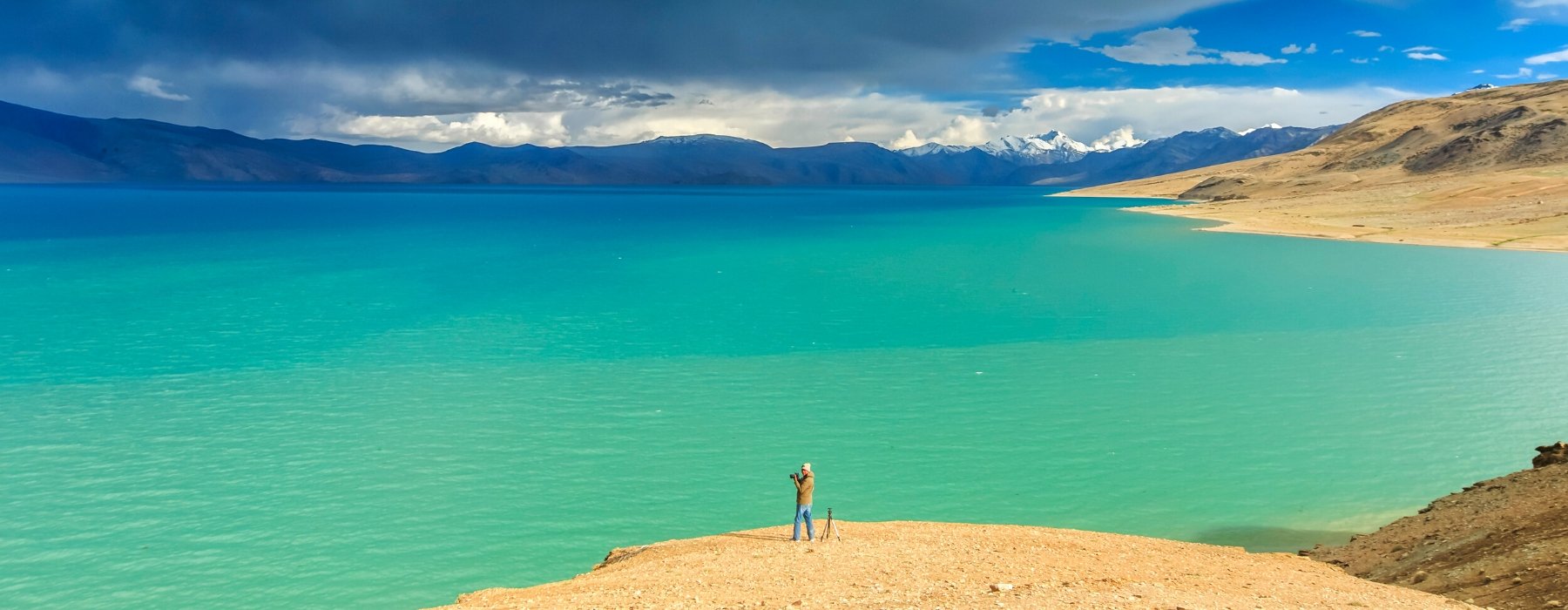
You’ll get up close and personal with the destinations and communities you travel through, seeing the cultural and historical highlights, natural wonders and wildlife, and local hidden gems.

Peru is a country of basically free access. Most of the countries of America and Western Europe do not require a tourist visa to enter Peru, and the maximum length of stay granted by the authorities is 183 days (it cannot be extended). For a stay for a longer period with other objectives (business, study, work, etc.) it is necessary to previously request the corresponding visa from the Peruvian consulates.
To enter Peru it is an essential requirement to present a valid passport with a minimum validity of six months from your entry into the national territory. Citizens of Argentina, Brazil, Paraguay, Uruguay, Ecuador, Colombia, Bolivia and Chile can enter with their national identification document.

Traveling is one of life’s great pleasures and what most of us dream to do at one time or another in our lives. Discovering new cultures and visiting ancient ruins is what motivates us to travel. Peru has a rich and colorful history with many different regions to explore. While thinking of your Peruvian holiday you might want to also consider a group or individual tours in Peru. Both options are viable when traveling in Peru if you prefer the company of other people when you travel then a group tour will be for you. You’ll always have someone to keep you company along the route, but you don’t always have to walk together. Wherever possible your Andean Great Treks leader will allow everyone to walk at their own pace, regrouping regularly along the route.
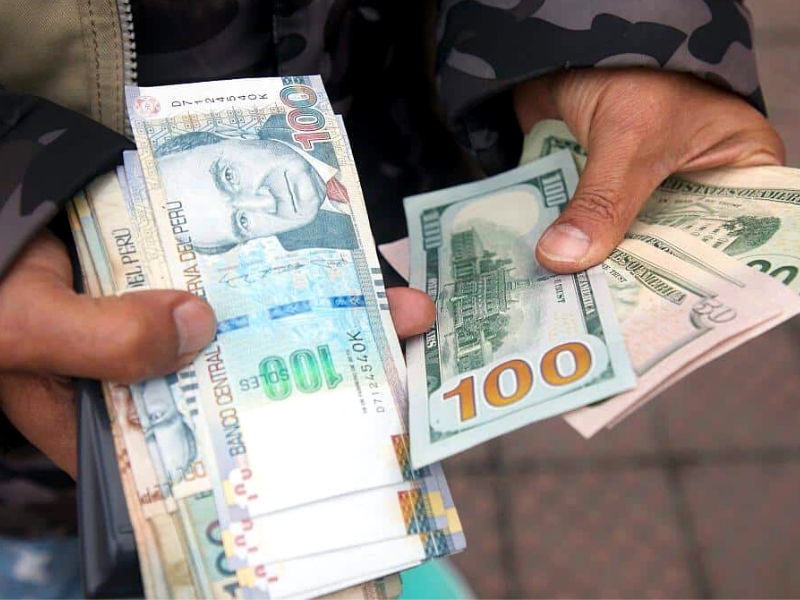
The currency in Peru is the Sol. It doesn’t take long to get used to it. There are just over three Soles to the US Dollar (USD), around three and a half Soles to a Euro (EUR) and just over four Soles to the Pound (GBP). Rounding up helps you make quick conversions when deliberating prices and making payment. While some businesses accept US dollars and some ATMs allow you to withdraw it even, it is much easier to pay for day-to-day things with Soles including food and drink, shopping at local markets and entry to local attractions. There are ATMs in every major city in Peru and as a point of reference can also be found near each city’s Plaza de Armas (the main square). It’s highly unlikely that you will find any ATM in more rural areas including villages and small towns. The fee for withdrawing money at the Peru ATM is around $5-$7 per transaction. The maximum withdrawal is around $200 – $250 per transaction.

Like many other countries in developing destinations, the region’s beauty and uniqueness are countered by inequality and lack of investment. This has led to crime rates (mainly theft and scams) not being uncommon in the larger cities. We know this doesn’t sound very attractive, but it’s important to mention it regardless. Most experienced and well-traveled visitors will understand this well and not be too concerned. However, having said this, it is our duty to take care of you during your visit. That’s why we present you here with a few recommendations to be extra safe. Avoid walking alone at night on empty streets. Don’t flaunt valuables! If going for a walk or going on public transport, be sensible and avoid showing off expensive items such as expensive watches and jewelry. Be careful of pickpockets! Don’t leave your bags anywhere that doesn’t look safe, and make sure to take them with you.
Most people can start to feel the effects of altitude at over 2000 m (6561 ft) regardless of age, gender or fitness level. While our leaders have basic first aid training and are aware of the closest medical facilities, it is very important that you make yourself aware of the cause and effects of travelling at altitude, monitor your health and seek assistance accordingly. It’s important to take it easy, drink plenty of water and speak to your group leader at once if you feel unwell.
We recommend seeing your doctor if you have any health concerns before undertaking the trip. Particularly if you have a pre-existing medical condition or take any medication.
Absolutely. All passengers travelling with Andean Great Treks are required to purchase travel insurance before the start of your trip. Your travel insurance details will be recorded by your tour guide on the first day of the trip.
Travel insurance is compulsory on all our trips for those travelling internationally. We require that at a minimum you are covered for medical expenses including emergency repatriation. If you are travelling within your home country or region please confirm before travel that you are entitled to access the public medical system easily should an accident occur. We strongly recommend all travellers have a policy that also covers COVID-19, personal liability, cancellation, curtailment and loss of luggage or personal effects.
No vaccines are required in order to enter Peru but some are recommended for protection against disease. Visit your doctor or travel clinic for advice and make sure to schedule vaccinations 4-6 weeks before your departure date, as some require time to become effective.
Recommended travel vaccines for Peru
Drinking tap water isn’t recommended in Peru. For environmental reasons, try to avoid buying bottled water. Fill a reusable water bottle or canteen with filtered water. Ask your tour guide or the hotel where you’re staying where filtered water can be found. It’s advisable to avoid ice in drinks and peel fruit and vegetables before eating. There’s no need to worry about keeping your mouth closed while you shower, but if you have a particularly sensitive stomach, you may wish to use boiled or filtered water to brush your teeth or wash fruits and vegetables.
When ordering cocktails or smoothies, try to avoid drinks with ice. You can always ask the waiter or vendor if they use filtered water to make ice, but if you’d rather not risk it, just order your drinks ‘without ice’. Single-use water bottles contribute to a huge environmental problem, so your best bet is to bring a portable water filter or water purifying tablets, and a large reusable bottle to refill at canteens or hotels. Brands like Steripen sterilize water using UV, while bottles from Sawyer remove most bacteria through an in-built foam purifier.
Water safety tips for Peru
Here are some handy tips to follow when it comes to drinking water in Peru:
Most hotels, large retailers and tourist attractions accept credit cards but will usually charge a fee (about 5% to 7%) for using them. Make sure you carry cash for when you’re dealing with small vendors, family-run restaurants and market vendors.
There are many situations where you might want to use your mobile when travelling. It could be to call a hostel to book a room, arrange a meeting point for breakfast with your new travel friends, or contact loved ones in an emergency.
Mobile phone coverage is generally good in Peru’s cities, but may not be available in more remote and mountainous areas. You will be able to use your mobile/cell phone while in Peru, but only if you have activated global roaming or purchased a local SIM card. If you choose to activate global roaming, don’t forget to check with your provider as to what costs will be incurred to avoid any unwanted surprises when you get your phone bill – it’s often painfully expensive! You should also make sure you check that your phone is unlocked before leaving home or the local SIM may not work overseas.
Buying a local SIM in Peru
Many travellers prefer to buy a local SIM card instead of a roaming plan as it works out much cheaper. You can buy a SIM card at most airports and phone retail shops in the bigger towns and cities. There are several carriers to choose from in Peru, with both prepaid and postpaid options available. Though postpaid is slightly cheaper, it may require a minimum commitment period, so you might be better off going with the prepaid option. As far as carriers go, Movistar, Entel and Claro are some of the biggest and will offer you decent coverage, though it may be poor or cut off completely in more rural or mountainous areas like the Andes.
Peru has a mix of both squat toilets and western-style flushable toilets. It’s a good idea to carry your own toilet paper and hand sanitizer, as they are not always provided. Some public toilets charge a small usage fee. Expect to use squat toilets if travelling on the Inca Trail.
ATMs can be found in most of Peru’s major cities and tourist areas. ATMs are far less common in rural areas and small villages so have enough cash to cover purchases when travelling away from the larger cities.

Every Andean Great Treks holiday has been thoughtfully planned and crafted by our specialists. They draw on their own extensive travel experience and the guidance and expertise of our local partners to create superb holidays. Our specialists are committed to making every aspect smooth and enjoyable; they genuinely want to ensure that the holidays they create leave you with wonderful lasting memories.
Every Andean Great Treks traveller is accompanied by an experienced tour guide, you will be immersed in Historic cities, ancient ruins and unfamiliar landscapes are all brought to life by our carefully selected local guides. They want to share their expertise and help you make your own discoveries too; their sole mission is to ensure you enjoy every moment.
Giving you the freedom to make your holiday even more memorable. We know how much our customers look forward to their holiday and we pride ourselves on the choice and flexibility that we offer to enhance every aspect of your experience. Whether it’s getting to the airport, upgrading your room or booking an additional excursion, we can help.
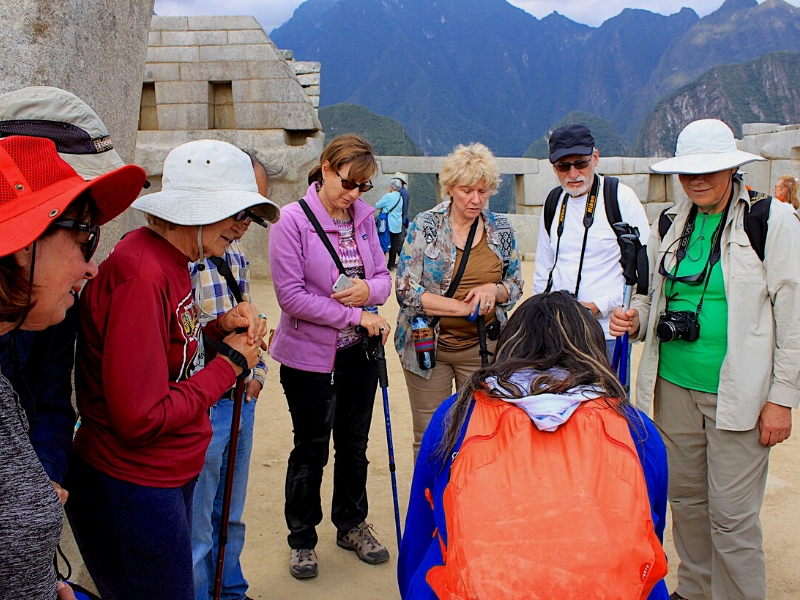
Our guides are the stars of the show; it is their unrivalled knowledge, passion and expertise that will transform your tour experience from good to truly extraordinary!
Because the have grown up in the area and know it like the back of their hand, so they can help you experience whichever aspects most interest you. They’re passionate about sharing their corner of the world with you, and as you explore together, they’ll open your eyes to the intricate details, provide background to enhance your understanding of what you’re seeing, and share stories that will bring everything to life.

“Your inspiration for a trip can be a single word or a highly evolved outline, but it’s the conversations we have that help us understand the experience you’re looking for. Meanwhile, I’m looking back on the time I spent at the destination.
‘The great thing about working with a specialist at Andean Great Treks is how they take your complete jumble of ideas and turn them into something absolutely spectacular.’
As you begin to share your ideas with your specialist, it will connect them immediately back to a time in their own travels. Conjuring a picture of the rest time they made that same discovery, reminding them how it felt.
Your specialist understands that, when the journey is right, it has the power to excite your emotions in the most profound ways after all, that was the effect on them.
They carry a treasure box of moments, captured over many journeys, into every suggestion they’ll share with you, as they ask you how you want to feel on your trip.

EXPERIENCES THAT CALL TO YOU
It’s what you do in a destination that helps bring it to life. It’s why we strive to choose experiences that help you connect to a place, absorbing a little of its complex character. Wherever your passions lie, we’ll recommend experiences that speak to you, and we’ll recommend the guide or local expert who’s most qualified to help you explore. Packing your holiday full of special experiences means some early starts and long days, but you can be sure that you’ll return home with many incredible memories! Read our Tours and check the Physical Ratings to see if the pace and activity levels are right for you.
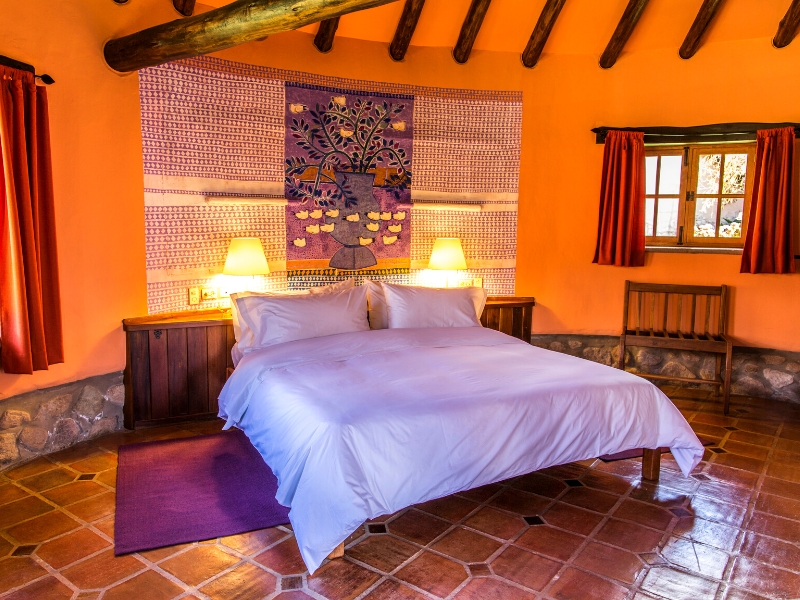
STAYS WITH DIFFERENCE
We know that where you stay is a cherished part of your travels. So, we go to great lengths to find places to stay that exceed expectations, or go above and beyond the ordinary, whether in their character, hospitality, or location. Over the years, we’ve discovered the very best properties, trying and testing them, so we can choose the right one for you. We’ve nourished long-standing relationships with these establishments and the people who founded them, and we’ve stayed there many times often, we’ll even know which rooms have the best views (and reserve them for you).

Our style of travel — authentic, thoughtful, and focused on building meaningful connections to the people and places you visit — is inherently respectful and considerate of the destinations we love. We design each aspect of your trip exactly as you want it, which includes its sustainability. That might mean choosing a train journey instead of a flight, staying at eco-friendly wildlife lodges, or opting for experiences that give back to the communities you’re visiting. The choice is yours.
Responsible travel has always been at the heart of what we do. First and foremost, because it gives you the best experience, but, also because it helps to preserve the communities and landscapes you visit. This isn’t new for us we collaborated with local communities and outside experts so we can grow to be better ambassadors.
The most authentic and interesting experiences often directly benefit the local people. We prefer to buy local products that are produced in the organic farms of the Sacred Valley, we also have alliances with local artisan organizations who provide us with souvenir items for our clients, your money directly benefits the local economy.
Our style of travel — authentic, thoughtful, and focused on building meaningful connections to the people and places you visit — is inherently respectful and considerate of the destinations we love. We design each aspect of your trip exactly as you want it, which includes its sustainability. That might mean choosing a train journey instead of a flight, staying at eco-friendly wildlife lodges, or opting for experiences that give back to the communities you’re visiting. The choice is yours.
Responsible travel has always been at the heart of what we do. First and foremost, because it gives you the best experience, but, also because it helps to preserve the communities and landscapes you visit. This isn’t new for us we collaborated with local communities and outside experts so we can grow to be better ambassadors.
The most authentic and interesting experiences often directly benefit the local people. We prefer to buy local products that are produced in the organic farms of the Sacred Valley, we also have alliances with local artisan organizations who provide us with souvenir items for our clients, your money directly benefits the local economy.
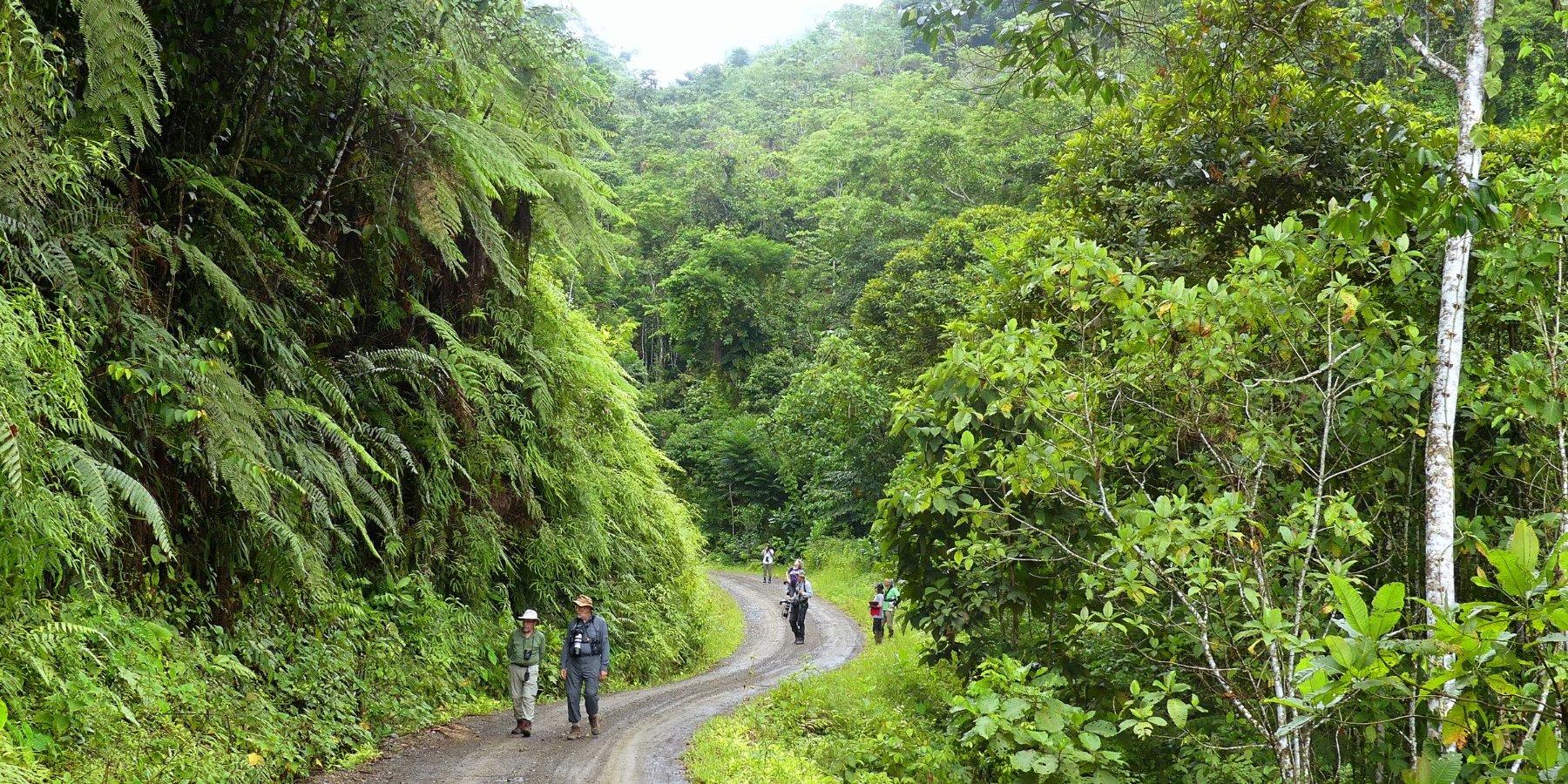
‘There’s a saying: we don’t inherit the Earth from our ancestors, we borrow it from our children. When we show you our country, this philosophy guides everything we do. It’s our responsibility to preserve the environment and wildlife, and support communities. That means using slower modes of transport, like cycling, employing local people, and working with communities who’ll benefit directly from your visit. This also gives you the best, most authentic impression of the places we want to share with you.
We prefer to buy local products in ecological bags, to avoid the use of plastic bags, likewise we teach the use of soaps and ecological products in each tour that we organize. We also work on reforestation projects with local communities who take care of landscape resources such as communal reserves, national parks.
‘There’s a saying: we don’t inherit the Earth from our ancestors, we borrow it from our children. When we show you our country, this philosophy guides everything we do. It’s our responsibility to preserve the environment and wildlife, and support communities. That means using slower modes of transport, like cycling, employing local people, and working with communities who’ll benefit directly from your visit. This also gives you the best, most authentic impression of the places we want to share with you.
We prefer to buy local products in ecological bags, to avoid the use of plastic bags, likewise we teach the use of soaps and ecological products in each tour that we organize. We also work on reforestation projects with local communities who take care of landscape resources such as communal reserves, national parks.
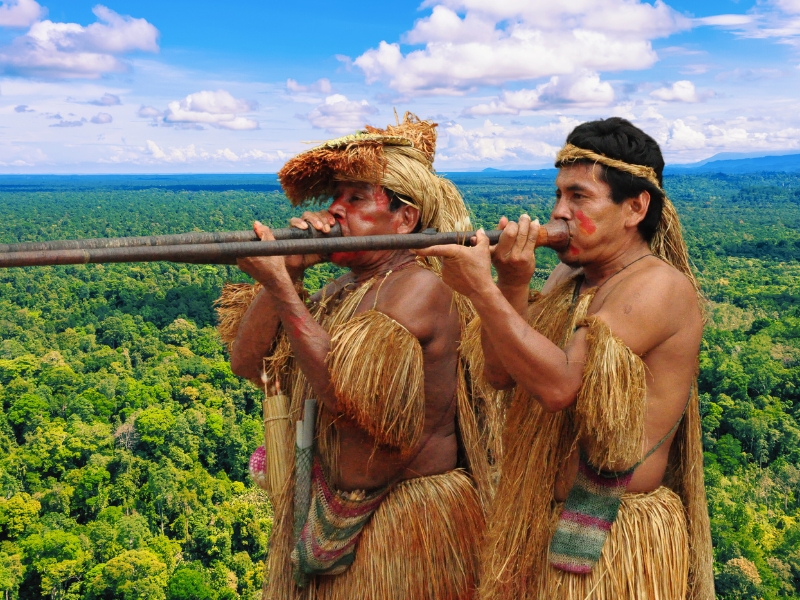
In the heart of the Peruvian Amazon, there is a natural paradise that will leave you breathless: Iquitos. With its impressive biodiversity, gastronomy, wildlife, lush jungle and a culture that is intertwined with nature.

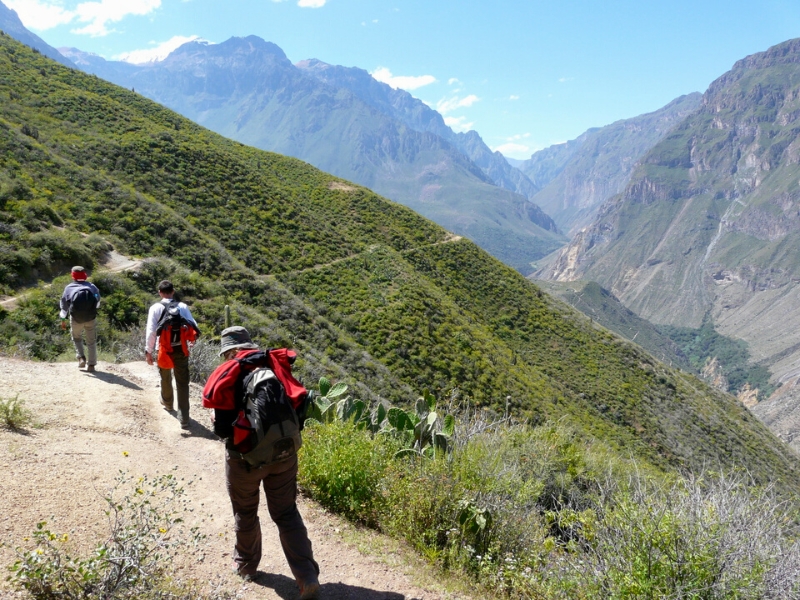
Visit the Colca Canyon, this natural attraction is located in the Arequipa region, when trekking through the Colca Canyon gorges, you can enjoy the beautiful Andean landscapes, picturesque towns and the impressive flight of the condors that was a sacred bird for the Incas.


See Peru in comfort and style with Andean Great Treks. We’ll create a personalized Peru tour just for you, with the perfect mix of locations and activities. Discover the ancient Incan citadel of Machu Picchu with an expert private guide. Enjoy the epic scenery of the Sacred Valley of the Incas and the rich history of Cusco. Explore the wonders of the great green Amazon.
